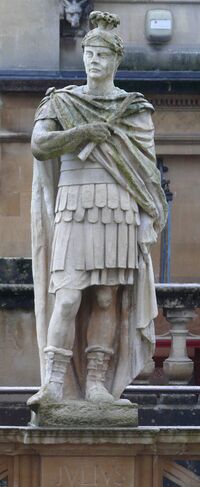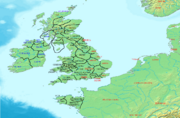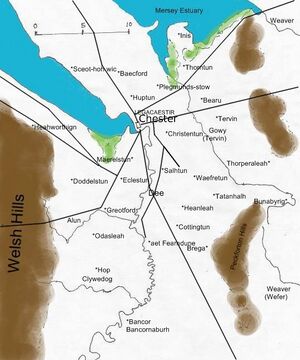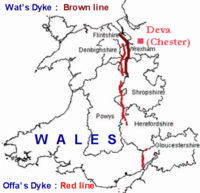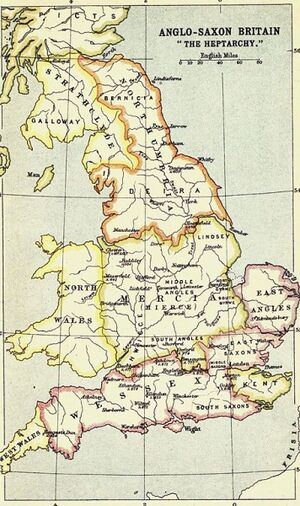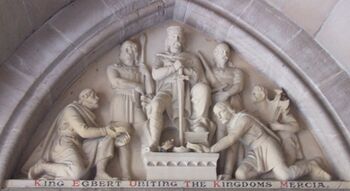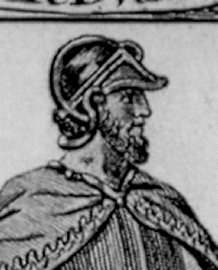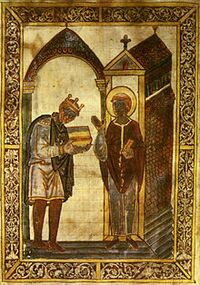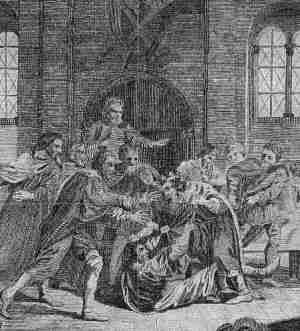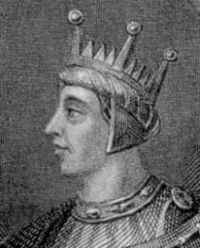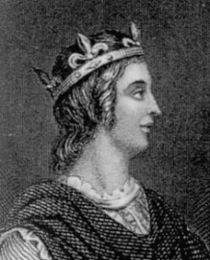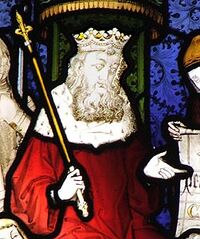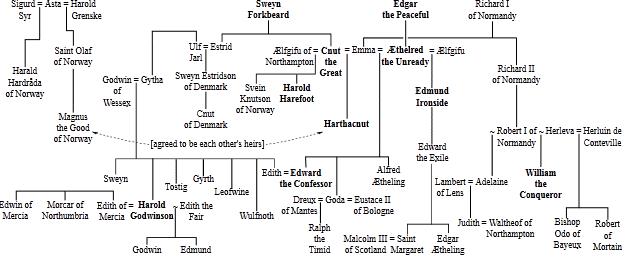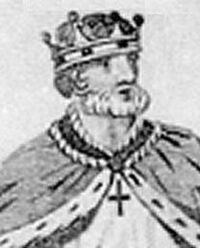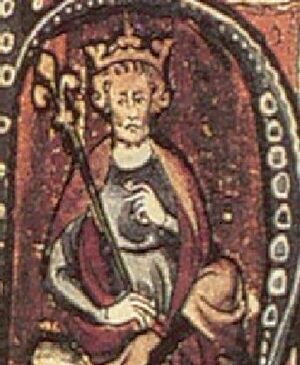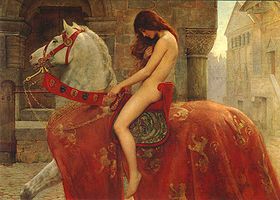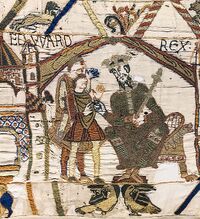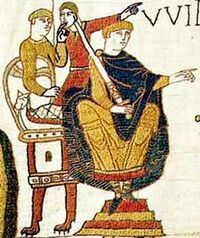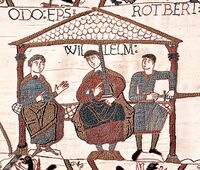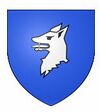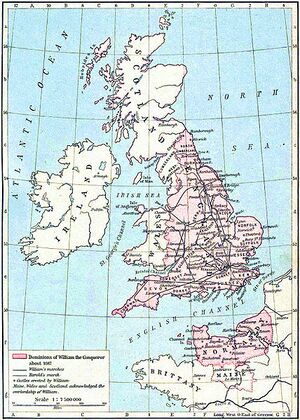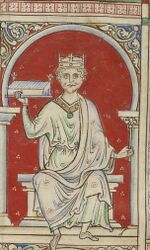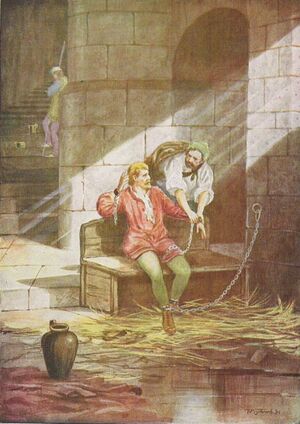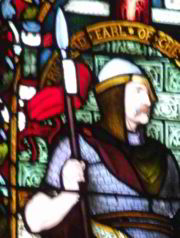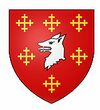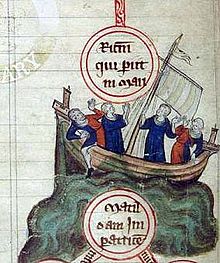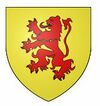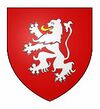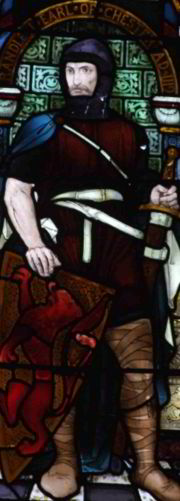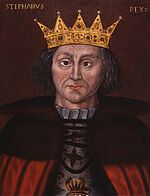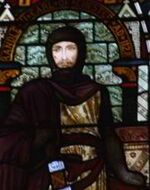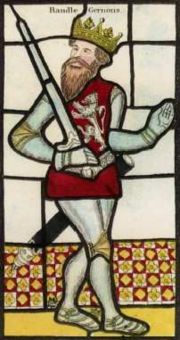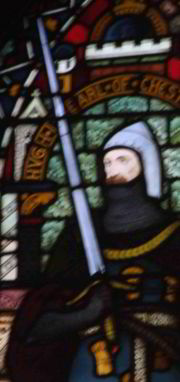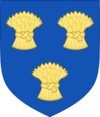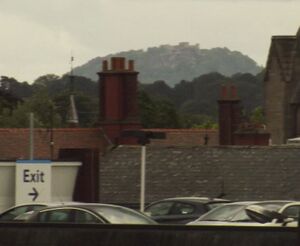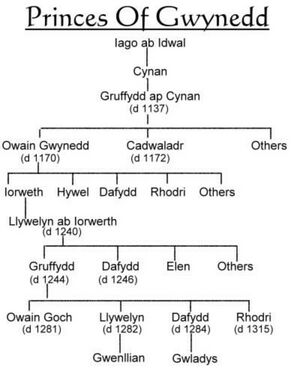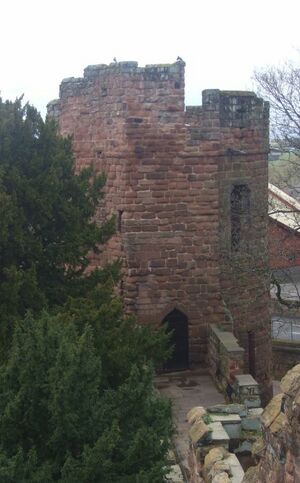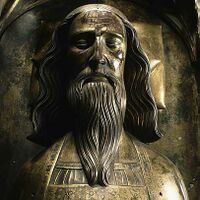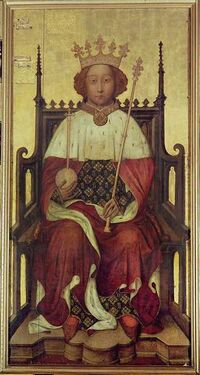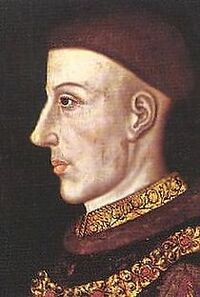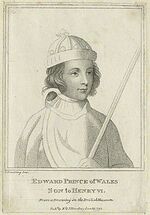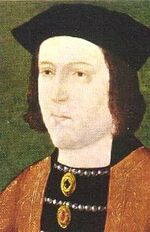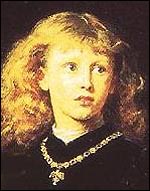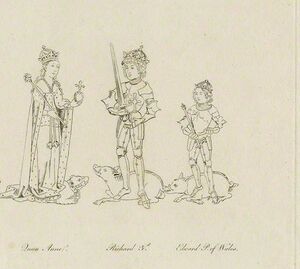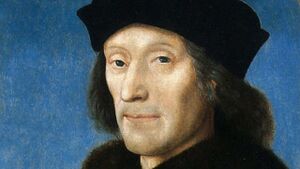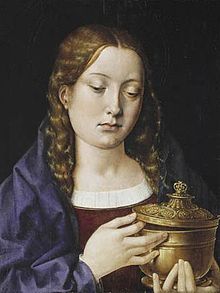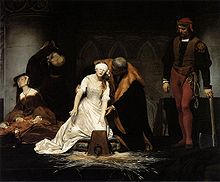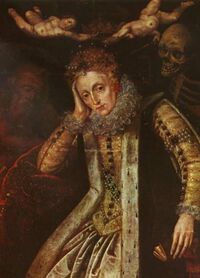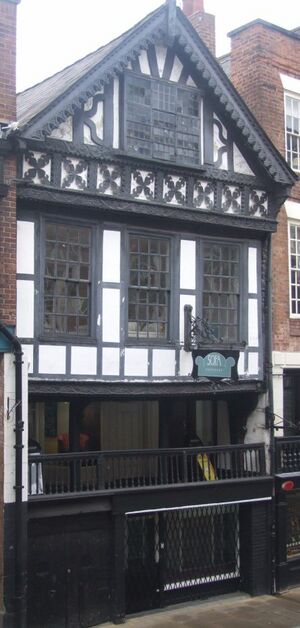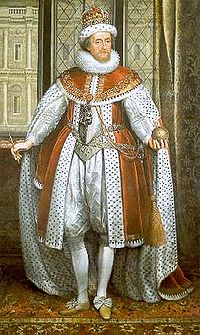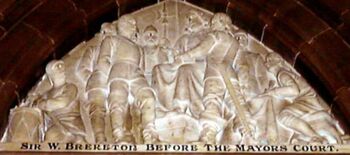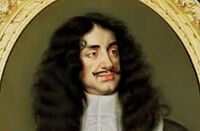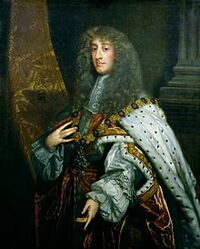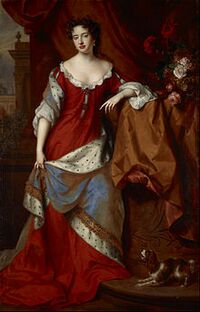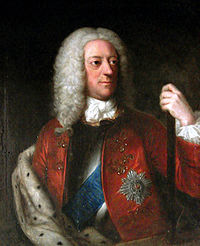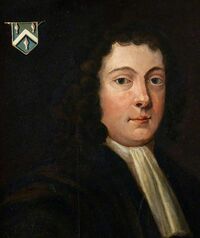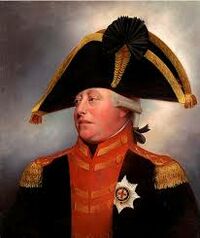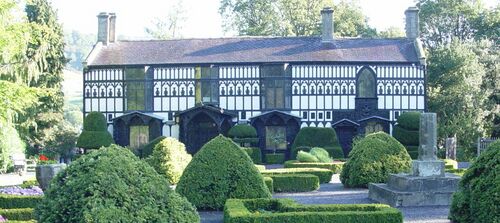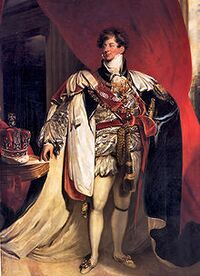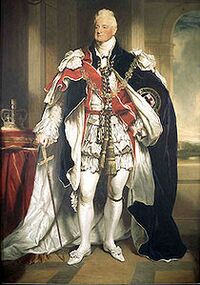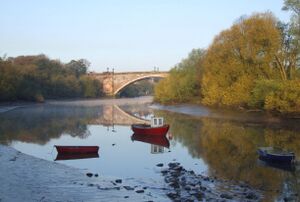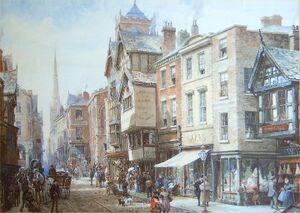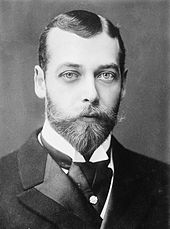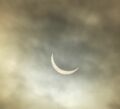Database changes have finished applying - please report any issues you're (still) seeing to support@shoutwiki.com.
Timeline
Introduction
The timeline for Chester starts around the time that the Roman city was founded as continues to the present day. The pattern is similar to that of the Chester Chronicle, apparently kept during the 700 year period 594-1295, but more likely written in the 13th century. The whole point of the timeline is that it is a starting point for branches elsewhere. To start the fun, here are a few things about Chester that most people get wrong:
- There is a clock directly over the main entrance of the Railway Station;
- Most of the Walls were built by the Romans;
- The half-timbered buildings in the city center, along the Rows, are Medieval;
- The Cathedral is called "St Werberghs", and has always been the Cathedral;
- The Countess of Chester is not a famous "streaker";
- Harold Godwinson died at the Battle of Hastings instead of retiring to Chester (well, perhaps...)
There is a more narrative history of Chester in the article A Short History.
Sources and links
- Steve Howe and A Virtual Stroll Around the Walls of Chester packed with information and a great source for links;
- British History Online another excellent source of information;
- Chester Chronicle - the local newspaper;
Chester Before The Romans
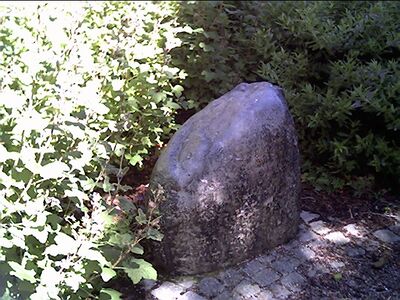
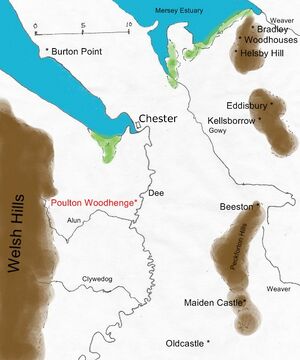
The lower River Dee Geology consists mainly of Triassic (~240 million years old) "New Red Sandstone". To the north west of Cheshire, these sandstones are heavily faulted and the underlying Carboniferous coal measures are exposed, thus, around Macclesfield, coal was easily mined. The mid-east area comprises the "Cheshire Basin" a fault-bounded "graben" structure which was flooded repeatedly in the Permian and early Triassic. The evaporation of this flood-water left salt beds which have been exploited both by cavern-working and hot-water brine extraction for over 200 years. Around the time that these rocks were forming, a significant "extinction event" took place globally. Theories for the cause of this extinction include shifting of continents, a giant meteor, a supernova (or similar), volcanic eruption, a greenhouse effect, or some combination of these - no one is really sure.
From fossils elsewhere, it can be seen that 95% of the species that were around before the event were extinct afterwards. But there are few fossils in the Cheshire sandstones, as these were laid down in a vast desert. However, a river, perhaps not unlike the modern Nile, crossed the desert and this did leave its mark in the form of the Chester Pebble Beds which can be seen very well in the railway cuttings and canal cutting near Northgate . Chester in those days was like the southern part of the Nile Delta, with a braided sandy river depositing pebbles which came from as far away as modern France.
The Cheshire Plain is a flat, "boulder clay" plain bounded by the hills of North Wales in the west, and the Peak District of Derbyshire in the east. The clay was formed in and beneath ice sheets during the Ice Ages. The earliest signs of habitation in Cheshire may be from 380 000 to 400 000 BC (the 'Hoxnian Interglacial'). The Hoxnian is sometimes dated 300,000 and 200,000 BP so this is remarkably early. At some time the ice sheets lay just to the north of the Mersey and much of the topography of the Mersey valley may have been formed by flood-waters from the melting ice. Occupation by people is not likely to have been continuous as the ice came and went. There is considerable debate about hominid activities in this period.
It appears that early settlement was largely along the sandstone ridges. Bickerton Hill, for example, has an Iron Age promontory hill fort dated around 600 BC (Maiden Castle) that encloses an area of 1.3 acres adjacent the cliff edge. It was destroyed by fire in around 400 BC, although the area was probably used as a settlement until around the 1st century AD, when the Romans arrived. Signs of Iron Age settlement (including post-holes near the Amphitheatre) have been found in Chester and reported.
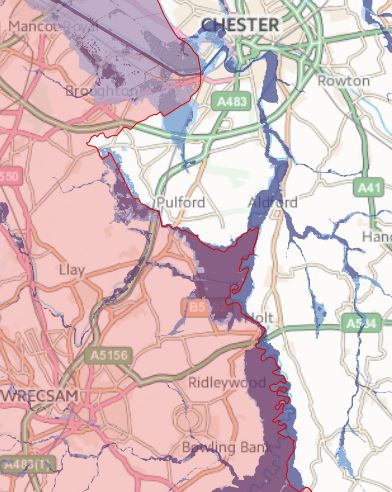
The Timeline starts
* 8000-4500 BC: Mesolithic (Middle Stone Age): 'microlithic' flints. Nomads exploiting the River Dee and nearby lake for wildfowl, fish etc.
* 4500-3000 BC: Early Neolithic (New Stone Age): First 'settlements'. Clearing of woodIand for grazing and cultivation. Long distance trading, introduction of polished flint tools, first pottery. Timber Circle ('wood henge') at Poulton c.3,500 BC. Palaeobotanical evidence suggests some woodland clearance confined to river valleys, flood plains and terraces, though there is little evidence for cultivation in the Chester area at this time. Worked stone tools (polished axe heads) have been found in the area.
* 2300-1800 BC: Early Bronze Age: Society becoming more organised; groups joining together to form larger tribal entities. Earliest roundhouses (c. 2,000 BC). New metal technology ; Copper and Gold. Increased trade links with the continent. 'Beaker' pottery vessels. Small Stone Circles, Round Barrows. Cremation burials. At Poulton: cemetery group of barrows and cremations. Palaeobotanical evidence suggests a wooded environment with small local clearances probably given over to cereal cultivation. Clearance increasing during the latter part of the period to the extent that some parts of the landscape became permanently open.
* 1,500-750 BC: Middle-Late Bronze Age c.1,100 BC Major climatic deterioration: wetter climate. Agriculture becomes increasingly livestock-based. Roundhouses increasingly common. Introduction of horses. Religion and ceremony based on water sites; rivers, lakes, etc. At Poulton: ring-Ditch ceremonially 'closed', ritual deposits in SE entrance-way. Desertion of many upland settlements due worsening climate and soil exhaustion. The beginnings of hilltop enclosures (hill forts).
* 750-150 BC: Early Iron Age - Iron tools (particularly from 200-300 BC). Society still essentially Late Bronze Age. Hillforts - Bickerton Hill, for example, has an Iron Age promontory hill fort. Settlements increasingly 'enclosed' by a ditch and bank, sometimes with a superimposed palisade. Granaries and storage pits become more common.
* 150 BC-AD 43: Late Iron Age - Hillforts largely abandoned. Rapid increase in trade and exchange with the continent. Exports of metals, hides, slaves and grain. Agriculture thriving; a 'surplus' economy. Late Iron age pottery (VCP) has been recovered from Chester, and pre-Roman plough marks were observed at a site on Frodsham Street.
Links and Sources
- Poulton Project (Retrieved from archive of july 2008)
Roman Chester
The link associated with the year will take you to the Wikipedia page for that year and let you see what else was happening in the wider world at that time.
In AD69, the "year of four emperors" (Galba, Otho, Vitellius and Vespasian) civil war raged in Rome and weak governors were unable to control the legions in Britain. Venutius of the Brigantes seized his chance, ending up in control of the north of the country. After Vespasian secured the empire, his first two appointments as governor, Quintus Petillius Cerialis and Sextus Julius Frontinus, took on the task of subduing the Brigantes and Silures respectively - the Romans then conquered more of the island, building a fort at Chester on the way and providing the first approximate dates for this timeline. The governor Gnaeus Julius Agricola, with Legio XX (at some time named Valeria Victrix), defeated the Caledonians in 84 at the Battle of Mons Graupius (somewhere in northern Scotland). Chester was occupied for the next 300 years and may have been the effective capital of Roman Britain. Around 384, the usurper Magnus Maximus (he is mentioned on the "Pillar of Eliseg") fought a successful campaign against the Picts and Scots, but his continental exploits required troops from Britain, and it appears that forts at Chester and elsewhere were abandoned at this period. Not all of the troops in Britain may have returned, but by around 396, there were increasing barbarian incursions in Britain.

- 43; Romans invade Britain during the empire of Claudius, Legio XX lands (from the AD 50s, it was encamped at Camulodunum, with a few units at Kingsholm in Gloucester and a garrison at Wroxeter)
- 47; the governor of Britain, Publius Ostorius Scapula, was forced to abandon his campaign against the Deceangli of North Wales because of "disaffection" among the Brigantes.
- 57; Quintus Veranius Nepos becomes governor in place of Aulus Didius Gallus. He begins a campaign against the Silures of south Wales, but dies before this can be completed. Tacitus states: "... Veranius, after having ravaged the Silures in some trifling raids, was prevented by death from extending the war. While he lived, he had a great name for manly independence, though, in his will's final words, he betrayed a flatterer's weakness; for, after heaping adulation on Nero, he added that he should have conquered the province for him, had he lived for the next two years." Oman (History of England, Methuen, 1910) gives this as the date that either Didius or Suetonius moved the headquarters of one or both of his legions from Wroxeter to Deva, built a flotilla of flat-bottomed boats on the Dee and in 60 A.D. invaded North Wales. By the earlier 50s elements of the Roman army had probably arrived in the area during campaigns against the Ordovices and Deceangli in central and northern Wales and the Brigantes north and east of Cheshire.
- 58; Gnaeus Julius Agricola began his career in Roman public life as a military tribune, serving in Britain under Gaius Suetonius Paulinus from 58 to 62. He was probably attached to the Legio II Augusta, but was chosen to serve on Suetonius's staff and thus almost certainly participated in the suppression of Boudica's uprising in 61.
- 62; Agricola returns from Britain to Rome: married Domitia Decidiana, a woman of noble birth.
- 66; Comet Halley puts in an appearance.
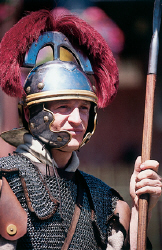
- 69; Agricola was appointed to the command of the Legio XX, stationed in Britain, in place of Marcus Roscius Coelius, who had stirred up a mutiny against the governor, Marcus Vettius Bolanus. Britain had suffered revolt during the year of civil war, and Bolanus was a mild governor. Agricola reimposed discipline on the legion and helped to consolidate Roman rule. Romans overthrow Brigantes. This northern British tribe was a Roman ally ruled by Cartimandua and her consort, Venutius. Cartimandua had been responsible for handing over resistance leader Caratacus to the Romans in 51 AD. Shortly afterwards, she divorced Venutius who revolted but was driven off by Roman arms. But in 69 AD, with the Romans in the midst of civil war, Venutius staged a second revolt and successfully overthrew Cartimandua, who fled to the Romans. According to one scrap of fragmentary inscription she may have lived out her days in Chester, but many scholars think there is no real evidence for this.
- 73; When his command ended, Agricola was enrolled as a patrician and appointed to govern Gallia Aquitania.
- 74; Roman fort probably first established at Chester by Legio II Adiutrix. Some give this as the date of the fort - others give earlier dates. It was most likely established to oversee the mining of silver and lead in what is now Flintshire.
- c.76; Tuathal Teachtmhar, a legendary High King (exiled from Ireland as a boy) is said to have returned from Britain at the head of an army to claim the throne. He may have been supported by the Romans, possibly being exiled in and then sailing from Chester (no firm evidence).
- c.77; Arriving in midsummer of 77, Gnaeus Julius Agricola - the new governor of Britain found the Ordovices of north Wales had virtually destroyed the Roman cavalry stationed in their territory. He immediately moved against them and defeated them. He then moved north to the island of Mona (Anglesey), which Suetonius Paulinus had failed to subjugate in 60 because of the outbreak of the Boudican rebellion, and forced its inhabitants to sue for peace.
- c.79; Romans start to construct the "Elliptical Building" (reconstructed here], possibly as the residence of the governor of the province of Britain. A building inscription from the palaestra of a bath building in the eastern half of the praetentura records completion in A.D. 79 (Also in this year - Vesuvius buries Pompeii)
- 84; The governor of Britain (and Chester resident) Gnaeus Julius Agricola, with the help of Legio XX, defeated the Caledonians in 84 at the Battle of Mons Graupius (somewhere in Scotland). Before the battle Calgacus (the Cadedonian leader) supposedly makes his much quoted "Ubi solitudinem faciunt, pacem appellant" ("you make a wasteland and you call it peace") speech.
- 85; Agricola was recalled from Britain
- 87: Legio II (Adiutrix) was recalled from Chester to the continent to participate in the Dacian wars of emperor Domitian.
- 93; Agricola died on his family estates in Gallia Narbonensis aged fifty-three. Rumours circulated attributing the death to a poison administered by the Emperor Domitian, but no positive evidence for this was ever produced.
- 122; Emperor Hadrian may have visited Chester on his way north to organize the construction of his wall from the Solway Firth to the Tyne, a project in which the Chester Legio XX played a large part. Most of the men in Legio XX are detached to serve on the Hadrianic and Antonine frontiers of northern Britain, with Chester serving as a military depot
- 141; Comet Halley puts in an appearance.
- 197; Legio XX used to support the governor of Britain (Claudius Albinus) in his bid for the imperial throne. Emperor Septimius Severus dispatched a new governor, Virius Lupus, to restore order in Britain, and a few years later campaigned there himself. No doubt the Twentieth Legion, brought back up to strength after 197, took part in his campaigns in Scotland. Severus died at York in 211 and soon afterwards his sons Caracalla and Geta withdrew from Britain. Severus's intervention prompted great building activity at Chester, and within a generation or so every part of the depot appears to have been systematically refurbished. The works included the completion of buildings planned a century before, most clearly the "Elliptical Building".
- 218; Comet Halley puts in another appearance.
- 286: Allectus, treasurer to Carausius, and a Menapian officer in the Roman navy seized power in Britain and northern Gaul. At around this time, substantial portions of the N and W walls were rebuilt on a wider gauge incorporating much inscribed material (mostly tombstones - found after 1883 and now in the Grosvenor Museum). Last mention of Legio XX, this time supporting Carausius in a bid for the imperial throne.
- 295; Comet Halley puts in an appearance.
- 296: Constantius Chlorus launched an invasion to depose Allectus.
- c300; Roman Mansio destroyed by fire.
- c306: Constantius Chlorus dies at York and his son Constantine is declared Emperor of of Britain, Gaul, and Spain. He therefore commanded one of the largest Roman armies, stationed along the important Rhine frontier. After his promotion to emperor, Constantine remained in Britain, and secured his control in the north-western dioceses. He completed the reconstruction of military bases begun under his father's rule, and ordered the repair of the region's roadways.
- 374; Comet Halley puts in another appearance.
- 389; Romans withdraw from Chester around this time - the last regular troops may have been removed by Magnus Maximus in 383. Coins of Theodosius I (379-395) and Arcadius (Eastern Emperor from 395 to 408) have been found in Chester, but no coins of Honorius (Western Roman Emperor from 395 to 423).
- 402; Roman coinage ceases to reach Roman Britain.
- 406; Legio XX Valeria Victrix (once of Chester) is the legion featuring in the novel "Eagle in the Snow" (Wallace Breem) which postulates they were annihilated by the Germanic invasion of 406.
- 410; The Roman emperor Honorius abandoned responsibility for the defence of Britain.
Links and Sources
- Mason DJP. "Roman Chester: city of the eagles". Tempus, 2001, ISBN 978- 0-7524-1922-0. Good source-book for archaeology in Chester.
Chester in the Early Dark Ages 429-871
Before the Roman withdrawal Britannia had been converted to Christianity and produced the ascetic Pelagius. After the Roman legions departed, pagan tribes settled the southern parts of the island while western Britain, beyond the Anglo-Saxon kingdoms, remained Christian. This native British Church developed in isolation from Rome under the influence of missionaries from Ireland and was centred on monasteries instead of bishoprics. Other distinguishing characteristics were its calculation of the date of Easter and the style of the tonsure haircut that clerics wore. Evidence for the survival of Christianity in Britain during this time includes the occurrence in place names of eccles, derived from the Latin ecclesia, meaning "church" (as in "Eccleston") There is no evidence that these native Christians tried to convert the Anglo-Saxons. Following the decline of Rome in the west, Chester was first part of the celtic region, then part of Mercia (Old English: Mierce, "border people") - one of the kingdoms of the Anglo-Saxon heptarchy, centred on the valley of the River Trent and its tributaries in the midlands. There is a more detailed article entitled Dark Ages. The Mercian kings seem to have been concerned with two things: dynastic murder and war with the Welsh.
- 429 At the request of Palladius, a British deacon, Pope Celestine I dispatches Bishops Germanus of Auxerre and Lupus of Troyes to Britain to combat the Pelagian heresy. While in Britain, Germanus, a former military man, leads the Britons in their 'Hallelujah' victory at Maes Garmon, near Mold on the Welsh border. St. Cadfan founds the Monastery of Barsdey
- 441: The Gallic Chronicle records, prematurely, that "Britain, abandoned by the Romans, passed into the power of the Saxons."
- 446: In December 1999 Shropshire County Council archaeologists uncovered the remains of a hearth or fire on the original ground surface beneath the raised bank of the ancient Wat's Dyke near Oswestry, England. Carbon dating analysis of the burnt charcoal and burnt clay in situ showed it was covered by earth on or around AD 446. Archaeologists concluded that this part of Wat's Dyke, so long thought of as Anglo-Saxon and a mid-8th century contemporary of Offa's Dyke, must have been built 300 years earlier in the post-Roman period in Britain. Excavations in 2006 suggested a much later date of 792-852, and the earlier date is now thought to relate to a fire site which preceded the dyke. A likely context for construction is the 820s, when the Mercian king Coenwulf was fighting against a resurgent Welsh threat. The Britons (probably the pro-Roman party) appeal to Flavius Aetius, Roman governor of Gaul, for military assistance in their struggle against the Picts and the Irish/Scots. No help could be sent, at this time, as Aetius had his hands full with Attila the Hun.
- 447: Vortigern is accused of incest. Battle of Aylesford (Kent) in which the rebellious sons of Vortigern, Vortimer and Cadeyrn, defeat Hengest and Horsa for the first time. Cadeyrn and Horsa are killed in the fighting. Shortly afterward, Hengest leaves Britain and returns to his homeland to recruit more troops. Telling the kings of the Angles, Saxons and Jutes of the "cowardice" of the Britons, he stirs much interest in migration among those tribes.
- 451: Comet Halley puts in another appearance.
6th Century
Very little if anything is known about events in Chester during the 6th Century. The post-Roman (after AD 400) kingdom of Powys initially extended much further east and may have included the Roman cities of Deva (Chester) and Viroconium (Wroxeter) and so covering the lands of the Ordovices and Cornovii: modern day east mid Wales, Chester and Shropshire - the fertile valleys of the Dee, Severn and Trent. Viroconium may well have been the capital of Powys and later of the sub-kingdom of Pengwern.
- 530 Comet Halley puts in another appearance.
- 536 Volcanic eruption causes extreme weather events and possibly extensive crop failures.
- 540 Possible comet impact causes widespread environmental cooling (visible from tree-ring data).
- 547 "Mortalis Magna" (The Great Death) "Mortalis magna in qua pausat Mailcun rex Genedotae. Unde dicitur, 'Hir Hun Wailgun en llis Ros.' Tunc fuit wallwelen" (A great death in which Maelgwn, king of Gwynedd died. Thus they say 'the long sleep of Maelgwn in the court of Rhos. Then was the yellow plague). This seems to be related to the Plague of Justinian (see: Pandemic)
- 560 around this time a Celtic monastery had been established at Bangor-on-Dee. Between 530 and 570, when most Roman urban sites and villas in Britain were being abandoned, there was a substantial rebuilding programme at Wroxeter. The old basilica was carefully demolished and replaced with new timber-framed buildings on rubble platforms. These probably included a very large two-storey building and a number of storage buildings and houses. In all, 33 new buildings were "carefully planned and executed" and "skillfully constructed to Roman measurements using a trained labour force"
- c.584, Battle of Feathanleag: a Celtic British force led by Brochwel Prince of Powys defeated the army of Ceawlin, King of the West Saxons, one of the key figures in the Anglo-Saxon conquest of England, who was attempting to advance into Wales. The Anglo-Saxon Chronicle records the event "This year Ceawlin and Cutha fought against the Britons at the place called Fethan-lea, and there was Cutha slain; and Ceawlin took many towns, and spoils innumerable; and wrathful he thence returned to his own." Some place the battle in Oxfordshire, others in Cheshire at Faddiley near Nantwich which seems highly dubious.
- c.585, Foundation of the Kingdom of Mercia.
7th Century
In the 7th Century Chester developed into an important ecclesiastical center and was the site of a Battle in 616 which may have had religious undertones. The struggle for power between the Welsh kingdoms, the Mercians and the Northumbrians was fought for most of the century with fortunes favouring different groups at different times. By the end of the century St Johns had been founded. Religious "conflict" also occurred as the followers of the Roman Rite sought to convert the Anglo-Saxons creating a trail of saints through the Anglo-Saxon nobility. The dispute between clerics following a synod at Chester and the Battle of Chester a decade later kicked-off a century of both religious and secular stuggle for dominance.

- 601: Synod at Urbs Legionis.(Annales Cambriae) possibly the same as mentioned below for 603. article by Carla Nayland.
- 603: Meeting of St Augustine with the British bishops at "Urbs Legion" (Chester? - others place the meeting with the British bishops in Wessex at a place known today as Augustine's oak - see "Bede and the Augustine's Oak conferences: implications for Anglo-British ecclesiastical interaction in early Anglo-Saxon England" - Martin Grimmer). He neglects to rise to greet them, lectures them again and insists they submit to him. The British send him packing. They refuse to recognise the authority of a church within their enemies' territory under such a disrespectful bishop.
- 604: 26 May Augustine dies.
- 607: Comet Halley revisits.
- 616: Battle of Chester: Æthelfrith of Northumbria against Kings Selyf Sarffgadau of Powys and Cetula (possibly Cadwal Crysban of Rhôs) and possibly also Iago ap Beli - possibly at Heronbridge. The Battle of Bangor-is-Coed follows in quick succession. King Bledric of Dumnonia is killed in the fighting. A large number of Saint Dunod's monks are slaughtered (said to be in keeping with Augustine's prophecy that if "they would not accept peace with their brethren, they should have war with their enemies"). Geoffrey of Monmouth (in History of the Kings of Britain) states that one of leaders of the British was "consul urbis" (Consul of the City) and that: "After this all the princes of the Britons met together at the city of Legecester,(..possibly Chester/possibly Leicester..) and consented to make Cadwan their king, that under his command they might pursue Ethelfrid beyond the Humber. (Book XII part I)"
- 641battle of Maserfieldat Oswestry. Oswald of Northumbria (later St Oswald) killed by Mercian snd his body was dismembered. Bede mentions the story that Oswald "ended his life in prayer": he prayed for the souls of his soldiers when he saw that he was about to die. Oswald's head and limbs were placed on stakes (his relics later moved about a bit). An old legend has one arm taken to a sacred ash tree (Oswald's Tree = "Oswestry") by his constant companion, a pet raven. Where the arm fell a holy well sprang up. Maserfield left Penda of Mercia as "the most formidable king in England."
- c650: Werburgh daughter of King Wulfhere of Mercia (himself the Christian son of the pagan King Penda of Mercia) and his wife St Ermenilda (herself daughter of the King of Kent) born at Stone, now in Staffordshire;
- 655: Battle of the Winwaed between King Penda of Mercia and Oswiu of Bernicia, ending in the Mercians' defeat and Penda of Mercia's death. Mercia's position of dominance, established after the battle of Maserfield, was destroyed, and Northumbrian dominance was restored; Mercia itself was divided, with the northern part being taken by Oswiu outright and the southern part going to Penda's Christian son Peada, who had married into the Bernician royal line (although Peada survived only until his murder in 656)
- 675: according to the Annals of Chester "Wulferus, king of Mercia, father of St Werburgh", died.
- 684: Comet Halley revisits.
- 689: St Johns Church founded by Æthelred of Mercia - "In the year of our lord six hundred and eighty-nine Ethelred, king of the Mercians, the uncle of St Werburgh, with the assistance of Wilfric, bishop of Chester, as Giraldus [Cambrensis] relates, founded a collegiate church in the suburbs of Chester in honour of S. John the Baptist (Annals of Chester)"
- 690: St Werburgh dies: her relics were taken to Chester in late 9th Century or early 10th Century (Annals of Chester gives the date of her 'translation' as 875)
8th Century
Mercian power reached its zenith in the 8th Century. With the exception of the short reign of Beornrad, who succeeded Æthelbald for less than a year, Mercia was ruled for eighty years by two of the most powerful Anglo-Saxon kings, Æthelbald and Offa. These long reigns were unusual at this early date; during the same period eleven kings reigned in Northumbria, many of whom died violent deaths. Little is known of specific events in Chester.
- 704: according to the Annals of Chester "Ethelred, king of Mercia, gave up the kingdom to Kenred, brother of S. Werburg".
- 717, Æthelbald becomes King of Mercia, marking the beginning of that kingdom's ascendancy over the other Saxon realms. Æthelbald's reign marked a resurgence of Mercian power, which would last until the end of the eighth century. Wat's Dyke may have been constructed during the reign of Æthelbald.
- 757, King Æthelbald of Mercia murdered at Seckington, Warwickshire, near the royal seat of Tamworth. According to a later continuation of Bede's Ecclesiastical History, he was "treacherously murdered at night by his own bodyguards". After the short reign of Beornrad he was succeeded by Offa.
- 760, Comet Halley revisits.
- 784, Construction of Offa's Dyke begins.
- 789, Annals of Chester record "Primus Danorum educatus [adventus] in Angliam qui docuerunt Anglos nimis potare" (The first arrival in England of the Danes, who taught the English to drink too much).
- 796: Offa dies (July) in a battle against the Welsh: it is believed that he was trying to establish a final link in the dyke to the Irish Sea in the north. Brief reign of Ecgfrith of Mercia. He is succeeded by Coenwulf a distant relative, apparently because Offa had arranged the murder of nearer relatives in order to eliminate dynastic rivals. Hemingway writes: "The origin of St Bridget's church is buried in obscurity but it may probably be dated from the reign of King Offa who died ad 797 [sic] about which time we read That 'divers parish churches were erected in Chester'"
9th Century
With the death of Offa and Beorhtric the focus of power shifted to the House of Wessex. Under Ecgbert, Wessex rose to become the most powerful of the Anglo-Saxon kingdoms, overthrowing the supremacy of Mercia. Ecgbert of Wessex captured Chester in 828.
- 801, Northumbrian invasion of Mercia fails.
- 821, Coenwulf dies at Basingwerk near Holywell, probably while making preparations for a campaign against the Welsh and in succeeded by his brother Ceolwulf who promptly invaded Wales. Another likely context for construction of Wat's Dyke is the 820s, when Coenwulf was fighting against a resurgent Welsh threat.
- 823, Beornwulf overthrows Ceolwulf and become ruler of Mercia. He promptly invades Wales. It was probably Beornwulf whose defeat of the kingdom of Powys and destruction of the fortress of Deganwy are recorded in a Welsh chronicle, the Brut y Tywysogion, in 823.
- 825, Beornwulf attacked the West Saxons but was badly defeated by the King of Wessex, Ecgbert, in battle at Ellandun, fought at Wroughton near Surrey. It is not clear whether sometime around this time Kenelm (Cynehelm) ruled briefly (before being murdered and become Saint Kenelm) - a document from 825 says that after the death of Coenwulf "much discord and innumerable disagreements arose between various kings, nobles, bishops and ministers of the Church of God on very many matters of secular business".
- 828; Ecgbert, King of the West Saxons, takes Chester and has statues of Cadwallon, King of the Britons, destroyed. Under Ecgbert, Wessex rose to become the most powerful of the Anglo-Saxon kingdoms, overthrowing the supremacy of Mercia.
- 829: Ecgbert invaded Mercia and drove Wiglaf, the king of Mercia, into exile. This victory gave Egbert control of the London mint, and he issued coins as King of Mercia. It was after this victory that the West Saxon scribe described him as a bretwalda, meaning "wide-ruler" or "Britain-ruler", in a famous passage in the Anglo-Saxon Chronicle. The relevant part of the annal reads, in the [C] manuscript of the Chronicle: "⁊ þy geare geeode Ecgbriht cing Myrcna rice eall þæt be suþan Humbre wæs, he wæs eahtaþa cing se ðe Bretenanwealda wæs (and the same year King Egbert conquered the kingdom of Mercia, and all that was south of the Humber, and he was the eighth king who was 'Wide Ruler'). Egbert will later get a statue in the Town Hall.
- 837: Comet Halley makes a very close approach to earth. Its tail stretched halfway across the sky and it appeared as bright as Venus.
- 839, Æthelwulf of Wessex held the Witenagemot (literally "meeting of the wise") in Chester, and, being crowned (in Kingston not Chester?), received at Chester the homage of tributary kings, "From Berwick to Kent." (Encyl Brit 1911 - not found in the A.S. Chron). April 10 — Comet Halley passes approximately 5 million km from Earth — its closest ever approach. Æthelwulf and his first wife, Osburh, had five sons and a daughter. After Æthelstan came Æthelbald, Æthelbert, Æthelred, and Alfred. Each of his sons, with the exception of Æthelstan, succeeded to the throne.
- 840, Wiglaf dies, is succeeded by Wigmund (who dies at once), then Wigstan (who does not want to be king), retires to a monastary with Ælfflæd (his mother) as regent. On 1st June AD 840, Beorhtfrith (who was the son of Beorhtwulf) went to visit the young King in peace at Wistow (Leics) - or Wistanstow (Salop) - but, when the two greeted each other, he struck Wigstan on the head with the shaft of his dagger and his servant ran him through with his sword. Ælfflæd was deposed by Beorhtwulf who becomes king of Mercia
- 865: An army of Danes which the Anglo-Saxon Chronicle described as the Great Heathen Army had landed in East Anglia with the intent of conquering the four kingdoms that constituted Anglo-Saxon England.
- 868 Chester Annals record a severe famine, follow by a visitation of the plague. Alfred the Great marries Ealhswith and goes to the aid of Burgred of Mercia, who is attacked by Danes.
Links and Sources
- British History Online: Early Medieval Chester
- Mercian relics in Cheshire
- Anglo-saxons.net plenty of history from Sean Miller
Chester in the Later Dark Ages 871-1066
While the House of Wessex ruled a kingdom in southwest England from the 6th century (under Cerdic of Wessex) it was not until the unification of the Kingdoms of England that they became rulers of all England (Bretwalda) roughly from Alfred the Great in 871 to Edmund II (Edmund Ironside) in 1016. The Dane, Sweyn Forkbeard claimed the throne from 1013 to 1014 and Sweyn and his successors, including Cnut ruled until 1042. There was a brief Saxon restoration between 1042 and 1066. During this time Chester was at some times deserted and at others an important strategic location. There is a more detailed article entitled Dark Ages and a specific look at the later Dake Ages under Ælfgar.
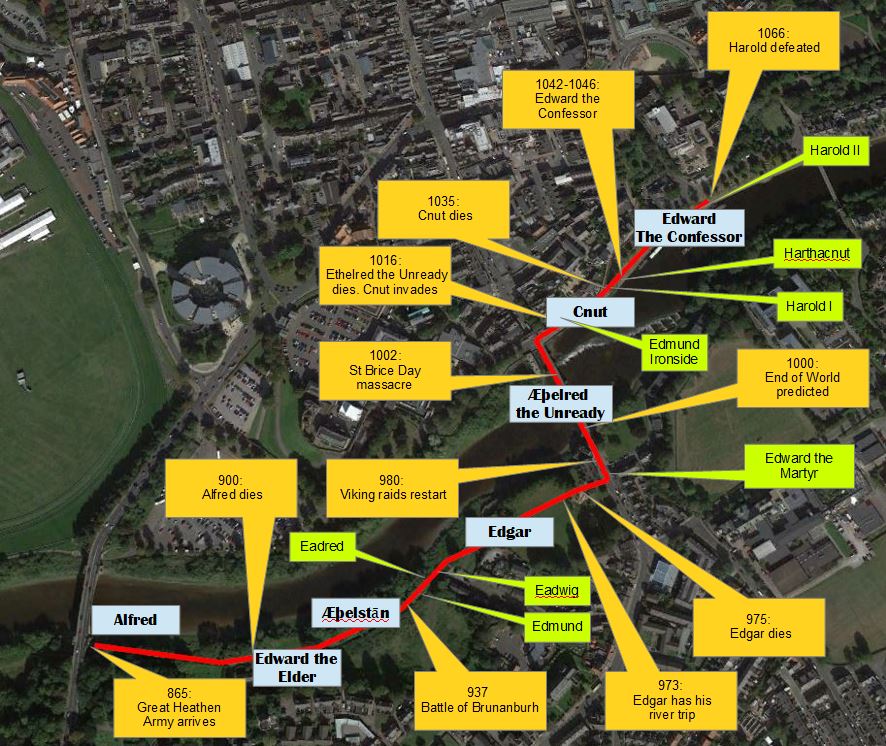
Alfred the Great(23 April 871 — 26 October 899)
Alfred is noted for his defence of the kingdom against the Danish Vikings (as well as burning cakes), becoming the only English King to be awarded the epithet "the Great" (apart from "Cnut the Great"). He was the first King of the West Saxons to style himself "King of the Anglo-Saxons", was a learned man, and encouraged education and improved his kingdom's law system as well as its military structure. By 879, both Wessex and Mercia, west of Watling Street, were cleared of the Danish invaders.
- 874 the Danes drive Burgred from Mercia and appoint a Mercian ealdorman Ceolwulf II to replace him, demanding oaths of loyalty to the Danes. Burgred retires to Rome and dies there. The ASC states: "This year went the army (i.e. the Great Heathen Army) from Lindsey to Repton, and there took up their winter-quarters, drove the king (of Mercia), Burgred, over sea, when he had reigned about two and twenty winters, and subdued all that land. He then went to Rome, and there remained to the end of his life. And his body lies in the church of Sancta Maria, in the school of the English nation. And the same year they gave Ceolwulf, an unwise king's thane, the Mercian kingdom to hold; and he swore oaths to them, and gave hostages, that it should be ready for them on whatever day they would have it; and he would be ready with himself, and with all those that would remain with him, at the service of the army."
- 875, St Werbergh's shrine moved to the Church of St. Peter and St. Paul within the city walls of Chester - "..when the Danes made their winter quarters at Repton after the flight of Burdred, king of the Mercians, the men of Hanbury, fearing for themselves, fled to Chester as to a place which was very safe from the butchery of the barbarians, taking with them in a litter the body of S. Werburg, which then for the first time was resolved into dust." . Is it perhaps convenient that the saint's hitherto "incorruptible" body converted itself into unrecognisable dust to prevent it being manhandled by the vikings?
- 878 Ceolwulf II appears to have been active in Wales. Rhodri the Great and his son Gwriad were killed, fighting the English, and Ceolwulf II is presumed to have been the leader of the Mercian army. Alfred the Great defeated the Great Heathen Army led by Guthrum on a date between 6 and 12 May at the Battle of Edington. Three weeks after the battle, Guthrum was baptized at Aller with Alfred as sponsor. The converted Guthrum was required to leave Wessex and return to East Anglia.
- 881, Ceolwulf II dies. Anarawd ap Rhodri inflicted a heavy defeat on Mercians at the Battle of the Conwy. in north Wales, in this year. This is described as "God's vengeance for Rhodri". As Ceolwulf II disappears from the record at about this time, it may be that he was killed in the defeat.
- 883, Æthelred becomes Earl (Eaoldorman) of Mercia. Although Æthelred is not recorded until 883, historians believe that he was "Edryd Long-Hair", of the Mercian army which invaded Gwynedd in 881, and was defeated by Rhodir Mawr's sons at the battle of the Conwy.
- c887, Æthelflæd (aged 15), marries Æthelred, Earl of Mercia. By this time Alfred had summoned Plegmund to his court, where he worked with three other scholars, Wærferth, Bishop of Worcester, Æthelstan and Wærwulf on translating Pope Gregory the Great's treatise Pastoral Care into Old English.
- 893, Vikings raided Chester, then 'a deserted city in Wirral'
- 894, Danes made a forced march across England to occupy the ruined Roman fortress of Chester - besieged by Alfred 894. The invaders "marched day and night, till they reached a waste fortress in Wirrall, called Legaceaster. The Saxon army could not overtake them, before they were within and had possession of the fortress": "Waste fortress" (westre ceastre) may be the origin of the name "West Chester" sometimes applied to the city.
- 899, Alfred dies, possibly of Chrohn's disease
Edward the Elder(26 October 899 - 17 July 924). Son of Alfred the Great.
Edward extended the control of Wessex over the whole of Mercia, East Anglia and Essex, conquering lands occupied by the Danes and bringing the residual autonomy of Mercia to an end in 918, after the death of his sister, Ethelfleda (Æðelflǣd). There is no reference to Edward's relations with the Mercians in the narrative sources between 919, when Edward is commanding Mercian armies, and 924, when William of Malmesbury records a Mercian revolt at Chester. Between 907 and 921 further forts were built over an area which stretched from north-east Wales to Manchester. Chester thus probably became the focus of complex garrisoning arrangements, initially to monitor Viking settlement. After around 900 Chester was a more prolific mint than London.
- 900, Edward was consecrated at Kingston-upon-Thames by the archbishop of Canterbury, Plegmund (of St Plegmund's Well fame): Edwardus rex Anglorum est consecratus in regem a Pleemundo Dornobernensi archiepiscopo apud Kingestune.
[[File:Æthelflæd as depicted in the cartulary of Abingdon Abbey.png|200px|thumb|left|Æthelflæd - daughter of Alfred]]
- 901, while it is a lot to base on a single document, it is possible that there was an attempt at Mercian independence that year, as a charter of Æthelred and Æthelflæd gives the Lord and Lady of the Mercians grander styles than usual, and there is no mention of Edward. This was also the time of Æthelwold's revolt against Edward, which might have encouraged the Mercians to make their own bid for freedom
- 902, A Hiberno-Norse community (see: Vikings settles in Wirral after its expulsion from Dublin. The exiles, led by Hingamund, were granted land in Wirral by Æthelflæd (Edward the Elder's sister) but cast covetous eyes on the wealth of Chester. Archaeology confirms a Hiberno-Norse presence in Chester:a brooch with Borre-Jellinge ornament found at Princess Street is identical with a brooch found in Dublin, and must have derived from the same mould. At around this time Æthelred's health collapsed and Æthelflæd became the effective ruler of Mercia. Irish annals called the Three Fragments also suggest that he was unable to take an active part in government from about 902
- 906, Abbey of St John the Baptist (St Johns) founded by Æthelred, Earl of Mercia (married to Æthelflæd).
- 909, following a combined West Saxon and Mercian raid led by Æthelflæd, daughter of Alfred the Great, St Oswald's relics were translated to a new minster in Gloucester, which was renamed St Oswald's Priory in his honour.
- 911, after the Battle of Tettenhall, Æthelflæd was elevated to the status of "Lady of the Mercians". Æthelred may have died of injuries from the battle.
- 912, Chester besieged by Ingamund, only to be repulsed by the great army which Æthelflæd assembled in the city. Comet Halley passes perihelion. There is a cryptic reference in "Lives of the Queens of England before the Norman conquest" to "A monastery, dedicated to St. Barnabas, was likewise founded by the 'Lady of Mercia', at Brunnesburgh, [In Cheshire.] that year, which shortly after fell to decay" (St Barnabas is the Parish Church in Bromborough and there is an interesting cross there)
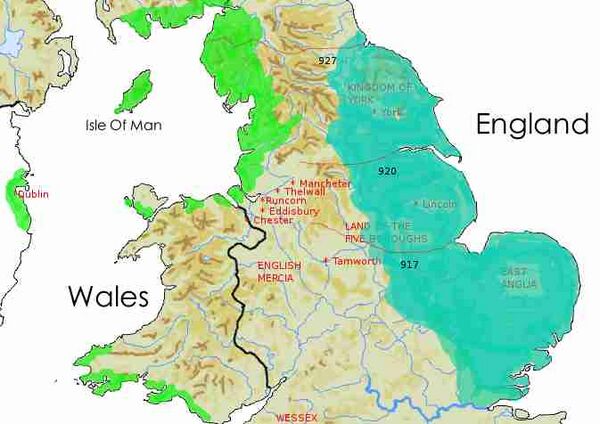
- 916, Æthelflæd of Mercia invaded Brycheiniog and on 19 June stormed the royal llys in Brecenan Mere Llangorse lake. There she captured the queen of the land and 34 others.
- 918, Æthelflæd of Mercia dies. She is succeeded by Ælfwyn who hands power to Edward the Elder after he seized and imprisoned her.
- 921, Edward the Elder establishes an earth and timber fort or burh (near Rhuddlan) at the mouth of the Clwyd, as part of his defence of the north Wales and Cheshire coastlines against the Viking raids. Its location remains uncertain, the burh stood close to the river's mouth at a place on the coast now lost, but still known in 1310 as 'Bircloyt'.
- 924, Chester joins a Welsh revolt against English rule (William of Malmesbury records a Mercian revolt at Chester). The revolt is put down by Edward the Elder who dies on 17 July 924 at Farndon. Annals of Chester record: "King Athelstane is crowned; in whose time, and thenceforth until the arrival of the Normans, secular canons and afterwards regular monks, served in this monastery in honour of S. Werburg."
links and sources
Sean Miller on Edward
Æþelstān (August 2, 924 – October 27, 939). Son of King Edward the Elder.
Æþelstān was the son of Edward the Elder, and grandson of Alfred the Great. His father succeeded, after some difficulty, to the Kingdom of the Anglo-Saxons formed by Alfred. His aunt, Edward's sister, Æthelflæd, ruled western Mercia on his behalf following the death of her husband, Ealdorman Æthelred. On Æthelflæd's death, Edward was quick to assume control of Mercia, and at the time of his death he directly ruled all the English kingdoms south of the Humber. Athelstan was fostered by his family as 'Half-King' in Mercia, perhaps as a method of encouraging Mercian loyalty to the West Saxon dynasty. On Edward's death, Æþelstān immediately became King of Mercia, though it seems to have taken longer for him to be recognised in Wessex where his half-brothers Ælfweard and Edwin had support. During his reign Chester retained its strategic significance because of its command over the route to Dublin and its proximity to Wales, whose princes' relations with the West Saxons were always ambiguous. A map of England at the time can be found here
- 925 King Æthelstan married his sister, Eadgyth of Polesworth to Sihtric (d. 927) and attended the wedding feast at the Mercian royal centre of Tamworth. The AS Chronicle, however, gives no name. Reporting on the same event in the early part of the 12th century, William of Malmesbury identified her as a daughter of Edward the Elder and Ecgwynn, and therefore a full-blooded sister to Æthelstan, but says that he was unable to discover her name in any of the sources available to him. A variant version of the Bury tradition, which locates her burial place at Tamworth rather than Polesworth, identifies this Edith as a daughter of Ælfflæd, Edward's second wife, and hence Æthelstan's half-sister. There is a St Edith's Church in Shocklach which may be associated with her and which contains some interesting Norse carvings.
- 933 According to William of Malmesbury, in one of Symeon of Durham's Northumbrian Annals dated AD933, which he used as material for his Historia regum Anglorum et Dacorum, he states that: "King Ethelstan ordered his brother Edwin to be drowned in the sea".
- 937 Battle of Brunanburh (possibly at Bromborough). Æþelstān's crushing defeat of the combined Norse-Celtic force facing him irrevocably confirmed England as an Anglo-Saxon kingdom, forcing the Celtic kingdoms to consolidate in the positions they occupy today. The Annals of Ulster describes the battle as follows: A huge war, lamentable and horrible, was cruelly waged between the Saxons and Norsemen. Many thousands of Norsemen beyond number died although King Anlaf escaped with a few men. While a great number of the Saxons also fell on the other side, Æthelstan, king of the Saxons, was enriched by the great victory
- 939 Æthelstan died at Gloucester on 27 October 939. His grandfather Alfred, his father Edward, and his half-brother Ælfweard had been buried at Winchester, but Æthelstan chose not to honour the city associated with opposition to his rule. By his own wish he was buried at Malmesbury Abbey, where he had buried his cousins who died at Brunanburh. After his death, the men of York immediately chose the Viking king of Dublin, Olaf Guthfrithsson, as their king, and Anglo-Saxon control of the north, seemingly made safe by the victory of Brunanburh, collapsed. The reigns of his half-brothers Edmund (939–946) and Eadred (946–955) were largely devoted to regaining control.
Edmund I (October 27, 939 – May 26, 946). Another son of Edward the Elder and half-brother of Athelstan.
Chester was an important base in 942 when there was collusion between the Welsh and the Scandinavian kingdom of York during King Edmund's campaign against the latter. Edmund was murdered in 946 by Leofa, an exiled thief. He had been having a party in Pucklechurch, when he spotted Leofa in the crowd. After the outlaw refused to leave, the king and his advisors fought Leofa. Edmund and Leofa were both killed. He was succeeded as king by his brother Edred.
- 942, Edmund at "Chester" during his reconquest of the midlands from Anlaf of Northumbria (this could have been Leicester as "Legracester" and "Legecester" are sometimes confused)
Eadred (May 26, 946 - November 23, 955). A son of King Edward the Elder by his third wife.
King Eadred, known as 'weak-in-the-feet', was King of England from 946 until his death. He was a son of King Edward the Elder by his third marriage, to Edgiva, daughter of Sigehelm, Ealdorman of Kent. He succeeded his brother, King Edmund I. Like his elder brothers, Eadred enjoyed military success over the Vikings. Eadred was a strongly religious man but in very poor health; he could only eat the juices of chewed food. As he died a bachelor and thus had no children, he was succeeded by his nephews, Edwy and Edgar, who divided the country.
- 946 legend records that a wooden statue of the Virgin fell on the head of Lady Trawst, wife of the Governor of Hawarden Castle, and killed her. The statue was tried by jury and condemned to be thrown into the River Dee. It was washed up at the Roodee in Chester. (N.b. this is an unfeasably early date for Hawarden Castle). It may or may not have been taken to St Johns Church
- c949, Chester mint strikes coin for the Welsh king, Hywel Dda. He was the first Welsh ruler to produce coinage for at least a thousand years. In 1857 three coins minted for Eadred were found at a barber's premises at 76 Eastgate Row Chester. The moneyers were Thurmond and Siefereth.
- 955, Towards the end of his life, Eadred suffered from a digestive malady which would prove fatal. 'Author B', the biographer and former apprentice of St Dunstan, described with vivid memory how the king sucked out the juices of his food, chewed on what was left and spat it out. Then he died.
Edwy (Eadwig, The Fair) (November 23, 955 - October 1, 959). Eadred's Nephew
The eldest son of King Edmund and Saint Elgiva, Eadwig was chosen by the nobility to succeed his uncle Eadred as King. His short reign was marked by ongoing conflicts with his family, the Thegns, and especially the Church, under the leadership of Saint Dunstan and Archbishop Odo. His kingdom did not include Chester. Eadwig is known for his remarkable generosity in giving away land. In 956 alone, his sixty odd gifts of land make up around 5% of all genuine Anglo-Saxon charters. No known ruler in Europe matched that yearly total before the twelfth century, and his cessions are plausibly attributed to political insecurity
- 955: Mercia is restored to having a separate political existence from Wessex (955-959), while Eadwig rules south of the Thames, Edgar became king of Mercia. Mercia is mostly run by Ælfhere.
- ???, A lead customs tag produced at the Chester mint at this time was later found at Coppergate in York
- 958: Edgar, king of Mercia, grants a charter (and seventeen hides of land) to the familia of St Werburgh.
Edgar (The Pacific) (October 1, 959 – July 8, 975). Eadwig's brother.

Edgar seized the Northumbrian and Mercian kingdoms from his older brother, Edwy, in around 955 and became king on the death of Edwy a few year later. Edgar's reign was a peaceful one, and it is probably fair to say that it saw the Anglo-Saxon kingdom of England at its height. Although the political unity of England was the achievement of his predecessors, it was Edgar who saw to its consolidation. By the end of Edgar's reign there was practically no likelihood of any recession back to its state of rival kingships, and the division of its domains.
- 970: 20 moneyers at work at Chester mint. The avoidance of portraiture by the Chester mint before 970 may have been partly to accommodate the taste of the Norsemen of Dublin. A hoard of silver pennies was buried in a jar on Castle Esplanade.
- 973: King Edgar, comes to Chester by ship and holds court at Edgar's Field. Taking the helm of a barge, he is rowed the short distance up the River Dee to St Johns Church by six or eight tributary kings. It is from John of Worcester that there comes the celebrated description of how the ‘subkings’ rowed Edgar on the Dee:
with them, on a certain day, he boarded a skiff; having set them to the oars, and having taken the helm himself, he skilfully steered it through the course of the river Dee and, with a crowd of ealdormen and nobles following in a similar boat, sailed from the palace to the monastery of St John the Baptist, where, when he had prayed, he returned with the same pomp to the palace. As he was entering it, he is reported to have declared to his nobles at length that each of his successors would be able to boast that he was king of the English, and would enjoy the pomp of such honour with so many kings at his command. (John of Worcester, Chron., 2.424–5)
Edgar reforms the coinage: the number of moneyers at Chester declined dramatically from c. 20 immediately before the reform to a mere five or so during the reform itself. Such small numbers continued throughout the reign of Edward the Martyr (975-8) and during the early issues of Æthelred II (978-1016), and were associated with a huge decline in output and the end of die-cutting at Chester. Die production for the Reform issue was centred upon London and Winchester, but most major mints quickly re-emerged as die-cutting centres, Chester alone among the great northern mints continued to receive its dies from Winchester until the 990s. The reason for this centralisation of die-cutting was that King Edgar introduced a system where periodically all the coinage was recalled and reminted, with the moneyers being forced to pay for new dies. All profits from these actions went to the king, and were a royal right.
Edward (The Martyr, Eadweard II) (July 8, 975 - March 18, 978). Eldest son of King Edgar.
Edward was king of England from 975 until he was murdered in 978. He is thought to have been the son of King Edgar and Æthelflæd. His succession to the throne was contested by supporters of his half-brother Æthelred, but with Dunstan's support, Edward was acknowledged by the Witan and crowned king by Dunstan and Oswald of Worcester. Edward's reign began inauspiciously when a comet was sighted. A famine followed. His reign was short and disturbed by factional strife. He was killed at Corfe Castle by servants of his stepmother the Queen Dowager Ælfthryth (Elfrida) on 18 March 978. Edward became known as "the Martyr" because of his violent end.
- c975: Church of St. Peter and St. Paul was re-dedicated to St. Werburgh and St Oswald. A monastery was founded in the names of these two saints. The ASC records "in the same year, during harvest, appeared "cometa" the star; and then came in the following year a very great famine, and very manifold commotions among the English people.". Or as another version of the ASC puts it: "Then too was seen, high in the heavens, the star on his station, that far and wide wise men call -- lovers of truth and heav'nly lore -- "cometa" by name. Widely was spread God's vengeance then throughout the land, and famine scour'd the hills." The comet (X/947 P1) is confirmed by may other sources ("There was also revealed up in the skies a star in the firmament, which men of spirit, wise in mind, skilled in science, wise orators, far and wide call comet by name"). The Chinese text "Wen hsien t'ung k'ao" records that a comet appeared in Hydra, while the Byzantine text "Historiae" states: "at the same time, in the beginning of August a hairy star appeared, a strange and prophetic portent, beyond human understanding. We could not recall having seen one so bright, or lasting so many days ... it was a sight full or terror and dread to all men."
Æthelred (the Unready: Old English Æþelred Unræd) (March 18, 978 – April 23, 1016). Younger son of King Edgar.
His nickname ‘the Unready’ derives from Old English unræd, meaning 'without counsel', 'ill-advised' or 'indecisive'. This can be seen as a pun on his name, Æþelræd, which may be understood to mean 'noble counsel', thus giving rise to 'Noble counsel, No counsel'. Perhaps the worst piece of advice he heeded was to try to buy the Danes off - "..if once you have paid him the Danegeld, you never get rid of the Dane". The first evidence of the new Mercian shires comes in a reference to "Cheshire" in 980. The unreliable William of Malmesbury reported that Ethelred defecated in the baptismal font as a child, which led St. Dunstan to prophesy that the English monarchy would be overthrown during his reign. He certainly had trouble from the Danes.
- 978, English troops possibly supplied by Ælfhere of Mercia are deployed on the Lleyn Peninsula on behalf of King Hywel ab Ieuaf of Gwynedd in order to prevent his uncle, Iago, invading with Viking allies from Dublin.
- 980, The Danes renew their raids on England attacking Chester and Southampton. Manx Vikings led by King Godfred I ally themselves with Prince Custennin of Gwynedd and raid Anglesey and the Lleyn Peninsula. Custennin is killed. AS Chronicle records that Vikings ravage Chester, doing great damage: "the county of Chester was plundered by the pirate-army of the North". Three of the four Anglo-Saxon coin hoards found in the city, those from Castle Esplanade, Pemberton's Parlour, and Eastgate Street, have been assigned to roughly the same period and interpreted as linked to that raid.
- 983, Mercian Earl Ælfhere campaigns against Brycheiniog and Morgannwg, with the aid of the Welsh king Hywel ap Ieuaf (Annales Cambriae).
- 989, Comet Halley revisits.
- 993, Analysis of atmospheric Carbon-13 indicates a possible "Carrington Event". This would have caused very bright Northern Lights and may have helped promote fears of the "end of the world" being nigh.
- 1000, Chester served as the naval base for an attack on Cumberland and Man: "This year the king went into Cumberland, and nearly laid waste the whole of it with his army, whilst his navy sailed about Chester with the design of co-operating with his land- forces; but, finding it impracticable, they ravaged Anglesey"
- 1006, supernova SN 1006 visible from Switzerland but not Britain. Some sources state that the star was bright enough to cast shadows, or read by.
- 1010, Wulfric, Earl of Mercia and Chief Councillor of State to King Ethelred died (12 October). Leofwine becomes earl of Chester.
- 1013, English resistance to the Danes collapsed and Sweyn Forkbeard conquered the country, forcing Ethelred into exile, but after his victory Sweyn lived for only another five weeks.
- 1014, Canute the Great was proclaimed King of England by the Danish army in England, but was forced out of England that year.
- 1015, Canute launched a new invasion.
- 1016, Ethelred's control of England was already collapsing once again when he died at London on 23 April. Ethelred was buried in St Paul's and was succeeded by his son, Edmund Ironside.
Edmund (Ironside) (April 23, 1016 - November 30, 1016). Second son of King Æthelred.
Edmund succeeded to the throne and mounted a last-ditch effort to revive the defence of England from the Danes. While he first won victories over Canute, he was defeated at Ashingdon and the two kings negotiated a peace in which Edmund kept Wessex while Canute held the lands north of the Thames. In addition, they agreed that if one of them died the other would inherit the whole. Edmund and "Earl of Chester" Leofric both appear in the apocryphal Shakespeare play Edmund Ironside although Leofric did not become earl of Chester until after the death of Edmund.
- 1016: Chester ravaged by Edmund Ironside and Uhtred, Earl of Northumbria because Cheshire men would not fight against the Danes (under Canute). Edmund did not last long - a popular story has it that soldiers acting in favor of Canute hid in the cess-pit of a lavatory and stabbed Edmund in the bowels when he sat down to relieve himself (or that the Ealdorman of Chester Eadric Streona arranged for him to be shot from the midden with a primitive crossbow - the "Skåne Lockbow"), though this has never been proven and he may well simply have died of injuries sustained in battle. In any event, the present writer hopes that there is no truth in the monk's comment: "Stephanus (assassin) suffered divers others ere the king sat"
Canute (The Great) (1016 - November 12, 1035). A son of the Danish king Sweyn Forkbeard (who invaded England and ruled unopposed for only five weeks).
The custom of "sanding the streets" in Knutsford (Cheshire) - some believe it means 'Canute's ford' - is thought to have started in Canute's reign. Tradition has it that King Canute threw sand from his shoes into the path of a wedding party upon fording the River Lily. Queen Victoria, in her journal of 1832 recorded: "we arrived at Knutsford, where we were most civilly received, the streets being sanded in shapes, which is peculiar to this town". Today the custom is practised May Day. Wirral locals also believe that Canute's less than successful attempt to hold back the sea with a command occurred in the Wirral at Meols. The legend in Wirral goes back at least as far as the Victorian period as they reconstructed the chair which Canute allegedly sat on. On the back of the chair is inscribed "Sea come not hither nor wet the sole of my foot". That Chester had refused to fight Canute could eventually have been to their benefit, as Leofric was later to become an Earl under Canute despite Canute having shared out the country to his Scandinavian allies and the traitor Eadric:
- In this year [1017] King Cnut succeeded to all the kingdom of England and divided it into four, Wessex for himself, East Anglia for Thorkel, Mercia for Eadric, and Northumbria for Eric. And in this yesr Ealdorman Eadric was killed, and Northman, son of Ealdorman Leofwine, and Æthelweard, son of Æthelmær the Stout, and Brihtric, son of Ælfheah of Devonshire. And King Cnut exiled the Ætheling Eadwig and afterwards had him killed
- 1017: Eadric ("the grasper") ealdorman of the Saxon Mercians is killed on the orders of Canute. The "Encomium" says that Cnut ordered Earl Eric Haakonsson to "pay this man what we owe him" and he chopped off his head with his axe. William of Malmesbury describes Eadric Streona as "the refuse of mankind and a reproach unto the English". Northman possibly a retainer of Eadric and a son of Leofwine is also killed. Mercia may have been given to Leofric (Northman's brother) immediately after that. Leofric may have married Lady Godiva about this time. John of Worcester related that:
- In July Cnut married Ælfgifu, that is Emma, Æthelred's widow, and at Christmas, when he was at London, ordered the treacherous Ealdorman Eadric (ducem Edricum) to be killed in the palace because he feared that some day he would be entrapped by Eadric's treachery, just as Eadric's former lords Æthelred and Edmund, that is Ironside, were frequently deceived, and he ordered his body to be thrown over the city wall, and left unburied. Ealdorman Northman, son of Ealdorman Leofwine, that is brother of Leofric the Ealdorman (dux Northmannus filius Leofuuini ducis, frater scilicet Leofrici comitis), and Brihtric, son of Ælfheah, governor of Devon, were killed with him, although blameless. The king made Leofric ealdorman (ducem) in place of his brother Northman, and afterwards held him in great affection.
- 1020: Coin minting dyes are produced at Chester for Sihtric Silkbeard, king of Dublin
- 1020: Norwegian king Olaf Haraldsson (he of St Olave - the building dates from 1611), was killed. Olaf (995 – 1030) is credited with converting Norway to Christianity. Several churches in England were dedicated to him (often as St Olave). St Olave's Church, York, is referred to in the Anglo Saxon Chronicle for 1055 as the place of burial of its founder, Earl Siward. This is generally accepted to be the earliest datable church foundation dedicated to Olaf and is further evidence of a cult of St. Olaf in the early 1050s in England. St Olave Hart Street in the City of London is the burial place of Samuel Pepys and his wife. Another St. Olave's Church south of London Bridge gave its name to Tooley Street.
Harold I (Harefoot) (November 12, 1035 – March 17, 1040). Son of Canute.
Upon Canute's death, Harold's younger half-brother Harthacanute, the son of Canute and his queen, Emma of Normandy, was legitimate heir to the thrones of both the Danes and the English. He was, however, unable to travel to his coronation, because his Danish kingdom was under threat of invasion by King Magnus I of Norway and King Anund Jacob of Sweden. England's magnates favoured the idea of installing Harold Harefoot temporarily as regent, due to the difficulty of Harthacanute's absence, and despite the opposition of Godwin, the Earl of Wessex, and the Queen, he eventually wore the crown. Harold survived an attempt to unseat him led by Alfred Aetheling and Edward the Confessor, Emma's sons by the long-dead Ethelred the Unready, in 1036. Harold died at Oxford on March 17, 1040, just as Harthacanute was preparing an invasion force of Danes, and was buried at the abbey of Westminster. His body was subsequently exhumed, beheaded, and thrown into a fen bordering the Thames when Harthacanute assumed the throne in June, 1040.
- 1035, King Cnut died at Shaftesbury leaving the rule of the country in dispute between Harthacnut (the son of Emma) and Harold Harefoot (the son of Aelfgifu). The Earls of Northumbria and Mercia (Chester) support Harold's claim while Earl Godwine (father of Harold II) supports Harthacanute's.
- 1039, Edwin (brother of Leofric of Chester) was killed in battle (at Rhyd y Groes near Welshpool) by Gruffydd ap Llywelyn.
Harthacanute (March 17, 1040 – June 8, 1042). Son of Canute.
Harthacanute was a harsh and unpopular ruler: to pay for his fleet, he severely increased the rate of taxation, and in 1041 the people of Worcester killed two of Harthacanute's housecarls who had been collecting the tax, prompting an attack by Harthacanute in which the city was burned. The story of Lady Godiva, wife of Leofric "Count of Chester", riding naked through the streets of Coventry to persuade the local earl to lower taxes may come from the reign of Harthacanute.
- 1041, Harthacanute orders Leofric and his other earls to plunder and burn Worcester, and lay waste the whole area
Edward the Confessor (Eadweard II) (1042 – 5 January 1066). Son of Ethelred the Unready.
Edward's reign was marked by peace and prosperity, but effective rule in England required coming to terms with three powerful earls: Godwin of Wessex, Leofric of Mercia, and Siward of Northumbria. Edward's sympathies for Norman favourites frustrated his nobles alike, fuelling the growth of anti-Norman opinion led by Godwin (who had become the king's father-in-law in 1045).
- c1047: Hugh of Avranches born.
- 1051 Earl Leofric supported Edward the Confessor when he came under threat at Gloucester from Earl Godwin. Through his efforts civil war was averted, and in accordance with his advice the settlement of the dispute was referred to the Witan. Earl Godwin and his family were outlawed for a time.
- 1052 The historical Macbeth, then king of Scotand, was involved indirectly in the strife in the Kingdom of England between Godwin, Earl of Wessex and Edward the Confessor when he received a number of Norman exiles from England in his court
- 1054, July 4th, supernova SN 1054 (the precursor of the Crab nebula) appears in Taurus. Edward's Earl of Northumbria, Siward, led a very large invasion of Scotland. The campaign led to a bloody battle in which the Annals of Ulster report 3,000 Scots and 1,500 English dead, (i.e. very many on both sides) and one of Siward's sons and a son-in-law were among the dead.
- 1055, Ælfgar son of Earl Leofric was outlawed. 24 October - Gruffydd ap Llywelyn and Ælfgar, exiled son of Leofric, Earl of Mercia, raid England, and sack Hereford. Harold Godwinson makes peace with Ælfgar, who returns from exile.
- 1057, Chester Chronicle records: "Leofric, earl of Chester, in the time of S. Edward, king and confessor, repaired, and conferred privileges on the collegiate church of S. John the Baptist, and the church of S. Werburg situate within the city as William of Malmesbury relates in his Chronicle, De Gestis Anglorum, Book 2". Earl Leofric dies. He is succeeded by Ælfgar. Harold Godwinson becomes Earl of Wessex when his father Godwin choked on a piece of bread while denying any disloyalty to the king. Ælfgar is again exiled for treason. The shrine of St Werburgh supposedly strikes an attacking Welsh king Gruffydd ap Llywelyn blind.
- 1058 Ælfgar, supported by the Welsh and Norwegians, unsuccessfully attacks the English coast; he is nonetheless re-instated as Earl of Mercia. Edith of Mercia (Ealdgyth) marries her first husband Gruffydd ap Llywelyn of Wales, King of Gwynedd, Powys, Gwent, Glywysing, and Deheubarth
- 1062, Ælfgar, son of Earl Leofric of Mercia dies. Edwin becomes the last Saxon Earl of Chester (his sister, Ealdgyth will later marry Harold II)
- 1063, Earl Harold (later Harold II) attacked Gruffydd ap Llywelyn's (for ap Cynan, see below) palace at Rhuddlan in Flintshire using Chester as his base. Gruffydd dies (at the hands of his own troops).
- 1064, Harold marries Ealdgyth (sister of Edwin, Earl of Chester and recent widow of Gruffydd ap Llywelyn) and divides Gruffydd ap Llywelyn's realm into the traditional kingdoms of Gwynedd and Powys, the rule of which were given to Bleddyn ap Cynfyn and his brother Rhiwallon ap Cynfyn.
- 1065, Earl Edwin's younger brother, Morcar was elected Earl of Northumbria when Tostig Godwinson was ejected by the Northumbrians.
Harold II(5 January 1066 (aged 44) — 14 October 1066). Had no claim to the throne by birth.

By 1066 Chester was a prosperous town with a population of perhaps 2,500-3,000. Rendering a farm of £45 and three timber of marten pelts (i.e. 120 skins), together with an additional payment from the moneyers, it was assessed as a half hundred including the adjacent townships of Handbridge, Newton by Chester, 'Lee' (Overleigh and Netherleigh), and 'Redcliff', expressly said to be 'outside the city' but taxed with it. The city had its own laws and customs, administered by its hundredal court, over which presided 12 judges or doomsmen (iudices civitatis) drawn from the men of king, earl, and bishop, and liable to fines payable to the king and earl for failure to attend. The judges have been regarded as evidence of Scandinavian influence on the city's institutions and equated with the 'lawmen' (lagemen or iudices) of certain boroughs in the Danelaw. There is, however, no indication that they enjoyed the same status as the lawmen, who had extensive properties and judicial privileges. Indeed the laws of Chester, which were recorded in Domesday Book in exceptional detail, suggest that, as in other western towns dominated by a great local magnate, the status of its citizens was comparatively low. They were obliged to pay 10s. on taking up land in the city, and were also liable to heavy fines for failure to pay gavel or rent and for other misdemeanours.
- 1066: Halley's comet puts in an appearance. Harold supposedly dies at Hastings, although a Chester legend has it that he later lived in the Hermitage near St John's Church. As Gerald of Wales tells us (from around 1188)..
- "..It is also asserted, that the remains of Harold are here deposited. He was the last of the Saxon kings in England, and as a punishment for his perjury, was defeated in the battle of Hastings, fought against the Normans. Having received many wounds, and lost his left eye by an arrow in that engagement, he is said to have escaped to these parts, where, in holy conversation, leading the life of an anchorite, and being a constant attendant at one of the churches of this city, he is believed to have terminated his days happily. The truth of these two circumstances was declared (and not before known) by the dying confession of each party." This is not the only source of this legend: in 1163 Ailred of Rievaulx noted: "Harold himself was deprived of the kingdom of England, and either died wretchedly or, as some think, escaped to a life of penitence.". Of course the idea that a dead King (or perhaps his lineage) somehow survives, perhaps to return (or provide a shire for pilgrims), is a common one - see the page on the Hermitage for more.
Sources and Links
- British History Online: Early Medieval Chester
- Vikings on the Wirral (Steve Harding)
- Anglo-saxons.net plenty of history from Sean Miller
The Normans
Chester and the Anglo-Norman Kings (1066-1272)
(see: The Earls of Chester)
The Norman dynasty ruled England from the time of the Norman Conquest in 1066, until 1154. They were followed by the House of Plantagenet (House of Anjou, or Angevin dynasty) originally a noble family from France, which had ruled Anjou and ruled England from 1154 to 1485. During this period the Earls of Chester wielded considerable political power, and at time opposed the crown, but afterwards their line died out the Earldom was held by the heir to the throne. The Victorian stained glass windows above the staircase in Chester Town Hall depict Gherbod the Fleming, who was given the Earldom of Chester by William the Conqueror, and the seven Norman Earls of Chester; Hugh I (c.1077-1101); Richard (1101-20); Ranulph I (1120-28); Ranulph II (1128-53); Hugh II (1153-81); Ranulph III (1181-1232); and John the Scot (1232-37).
Almost throughout all of the next two centuries Chester remained a starting point for war with Wales.
William I (William the Conqueror, William the bastard)(25 December 1066 (aged 41) - 9 September 1087)

William invaded England in 1066, leading an army of Normans to victory over the Anglo-Saxon forces of Harold Godwinson and suppressing subsequent English revolts in what has become known as the Norman Conquest. His reign, brought Norman culture to England, saw changes to English law, a programme of building and fortification, changes to the vocabulary of the English language, and the introduction of continental feudalism into England. Identified as a centre of disaffection, Chester was dealt with severely. The construction of William I's motte and bailey castle south-west of the legionary fortress almost certainly entailed considerable destruction; when Earl Hugh received the city, probably in 1071, the value of the farm had been reduced by a third to £30 and it was described as 'greatly wasted'. Of 487 houses standing in 1066, 205 had been lost and were perhaps not rebuilt before 1086. The increase in the farm of the city under Earl Hugh to £70 and a mark of gold (about its preConquest level) perhaps indicates more burdensome exactions rather than returning prosperity.
- 1067 In August 1067, Bleddyn ap Cynfyn and his brother Rhiwallon ap Cynfyn joined "Eadric the Wild" in an attack upon Herefordshire as part of the Saxon resistance to the recent Norman Conquest of England. Some claim that Queen Ealdgyth, gave birth to King Harold's son, (Harold Haroldson) at Chester in 1067.
- 1068 Bleddyn ap Cynfyn and his brother Rhiwallon ap Cynfyn join Edwin and his younger brother, Morcar in their rebellion (they swiftly submitted when William moved against them).
- 1069: Men of Chester in alliance with "Eadric the Wild" and the Welsh rise against the Conqueror. In North Wales at the Battle of Mechain Rhiwallon ap Cynfyn dies leaving his brother Bleddyn ap Cynfyn ruler of Gwynedd and Powys.
- 1070: Chester besieged by the Normans, "Wulf" son of Harold and Ealdgyth, taken hostage as a babe when Chester opened its gates to William (other versions have it that Ealdgyth fled with her infant son to Dublin, and thereafter disappeared from recorded history.). Work starts on Chester Castle under Gherbod the Fleming (this date is subject to debate - but the Castle Timeline starts here.)
- 1071: Gherbod the Fleming is either imprisoned or exiled. Hugh of Avranches (later "Hugh the Fat") granted the earldom of Chester: "to hold to him and his heirs as freely by the Sword, as the king himself held England by the Crown." Hugh appoints his cousin, Nigel of Cotentin, as the first Baron of Halton (he will build Halton Castle). Edwin the last Saxon Earl of Chester attempts a rebellion - he is betrayed to the Normans by his own retinue and killed.
- 1072: William of Malmesbury states that a decree was signed on the festival of Pentecost in the year 1072 which ordained: "..that according to the cannons the bishops should quit the villages and fix their abode in the cities of their dioceses: Lichfield, therefore migrated to Chester and, amongst others, Dorchester to Lincoln."
- 1074: Ranulf de Meschines born.
- 1075: north-west Mercian See transferred from Lichfield to St John's Church by Peter of Lichfield.
- 1081: Gruffydd ap Cynan captured and imprisoned in Hugh of Avranches castle at Chester
- 1085: Peter of Lichfield Bishop of Chester, died and was buried at Chester.
- 1086, in an engraving of the coat of arms of Hugh of Avranches, first Norman Earl of Chester, the artist has gave the head of the wolf a wide grin, which might be mistaken for that of a cat - this has been suggested as the origin of the Cheshire Cat.
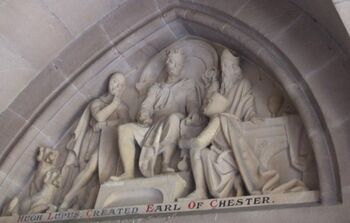
- 1087, King Philip I of France described the portly William I as looking like a pregnant woman. William mounted a furious attack on Philip's territory, and burned Mantes. His horse stood on an ember and William was thrown against the pommel of his saddle so violently that "his intestines burst". He lingered for five weeks, but on September 9, 1087 died. Dee Bridge mentioned in Domesday: 'When, for the purpose of repairing or rebuilding the wall or the bridge of the city, the proper officers commanded that one man be furnished from each hide, the lord of such man that did not attend was fined fourty shillings to the King and the Earl'. It was a not a good year for others: "In the one and twentieth year after William began to govern and direct England, as God granted him, was a very heavy and pestilent season in this land. Such a sickness came on men, that full nigh every other man was in the worst disorder, that is, in the diarrhoea; and that so dreadfully, that many men died in the disorder. Afterwards came, through the badness of the weather as before mentioned, so great a famine over all England, that many hundreds of men died a miserable death through hunger. Alas! how wretched and how rueful a time was there! When the poor wretches lay full nigh driven to death prematurely, and afterwards came sharp hunger, and dispatched them withal! Who will not be penetrated with grief at such a season? or who is so hard-hearted as not to weep at such misfortune? Yet such things happen for folk's sins, that they will not love God and righteousness."
Sources and Links
William II (William Rufus) (9 September 1087 (aged 27) — 2 August 1100). Third son of William I
Commonly known as 'William Rufus', perhaps because of his florid, red-faced appearance rather than his red hair (N.B all the English monarchs from here until Elizabeth I seem to have red hair). He was an effective soldier, a ruthless ruler and, according to the Anglo-Saxon Chronicle, 'hated by almost all his people.' English Church chroniclers took a dim view of William's reign, accusing him of being homosexual. According to Norman tradition, William scorned the English and their culture. According to William of Malmesbury, William Rufus was 'well set; his complexion florid, his hair yellow; of open countenance; different coloured eyes, varying with certain glittering specks; of astonishing strength, though not very tall, and his belly rather projecting.' He was the third son of William the Conqueror.
- 1088 Robert of Rhudlan was killed fighting the Welsh whereupon Hugh of Avranches took control of his lands, making him the virtual ruler of much of North Wales
- 1092 Hugh of Avranches granted Chester abbey, all the tolls, rents, and issues of a fair lasting three days about the feast of St. Werburg 'in the summer' (20–22 June), and assigned jurisdiction over it to the abbot's court and the proceeds to the monks. A weir is built across the River Dee with mills at both ends to grind corn.
- c.1093 Gruffydd ap Cynan exhibited at Chester market in chains and released by a young Welshman visiting 'to buy necessities'. Anselm founds the Benedictine monastery in Chester: (see Cathedral). According to the Chester Annals: "Anselm .. on the invitation of the noble prince, earl Hugh, he came to Chester, and there founded the abbey in honour of S. Werburg, and, having assembled the monks together, he appointed Richard, a monk of Bec, the first abbot. Having done this, in the same year, upon his return from Chester, he was made archbishop of Canterbury."
- c.1094 Welsh under Gruffydd ap Cynan revolt against the Normans and recover Angelsey and much of the rest of Gwynedd.
- 1095 William II invades Wales - his army was unable to draw the Welsh to battle and returned to Chester without having achieved very much
- 1097 King Willam mounted a second invasion of Wales, but again without much success. "Then upon the feast of St. Michael, the fourth day before the nones of October, appeared an uncommon star, shining in the evening, and soon hastening to set. It was seen south-west, and the ray that stood off from it was thought very long, shining south-east. And it appeared on this wise nearly all the week. Many men supposed that it was a comet."
- 1098 Hugh of Avranches marched from Chester as joint leader of an ill-fated expedition to Anglesey. This time, Earl Hugh joined with Earl Hugh of Shrewsbury in another attempt to recover his losses in Gwynedd. Gruffydd ap Cynan and his ally Cadwgan ap Bleddyn retreated to Anglesey, but then were forced to flee to Ireland in a skiff when a fleet he had hired from the Scandinavian settlement in Ireland accepted a better offer from the Normans and changed sides. The expedition became a disaster for almost everyone involved when the Norse fleet turned up and the Earl of Shrewsbury was shot by an arrow said to have been fired by Magnus Barefoot of Norway. See Gerald of Wales for more on this
- c.1100, Ranulf de Gernon born
- 1101 William II killed in a "hunting accident" his body is abandoned by his nobles at the place where he fell. William's younger brother, Henry, hastens to Winchester to secure the royal treasury, then to London, where he is crowned within days. It is left to a local charcoal-burner named Purkis to take the king's body to Winchester Cathedral on his cart. He is buried in the crossing under the spire, which promptly collapses on his grave. Richard Pincerna gave St Olave's church to the Abbey.
Henry I (Beauclerc) (3 August 1100–1 December 1135). Fourth son of William I.
Called "Beauclerc" for his scholarly interests and "Lion of Justice" for refinements which he brought about in the rudimentary administrative and legislative machinery of the time. Henry's reign is noted for its political opportunism - his succession was confirmed while his brother Robert was away on the First Crusade and the beginning of his reign was occupied by wars with Robert for control of England and Normandy. In the 12th century, though Chester was clearly regarded as a prosperous town, there are hints that it was very dependent on external trade. William of Malmesbury, for example, noted that while its hinterland abounded in beasts and fish, especially salmon, it was unproductive of cereals, which had to be imported from Ireland. Somewhat later the monk Lucian also praised the woods, pastures, beasts, and fisheries of the Cestrians, but also remarked that they were well placed to obtain supplies not only locally but from Wales and Ireland. There was a market in the city immediately south of St. Peter's church. This was fronted in the 1120s by important buildings, including the sheriff's house and a 'great shop' (magna sopa).
- 1101: Hugh of Avranches dies, July 27. He was buried in the churchyard of the Abbey, but was later exhumed and reburied in the Chapter House. Richard of Avranches becomes second earl. Annals of Chester (mcj Defuncto Hugone comite cestrensi principe nobili. Ricardus puer vij annorum comitatum suscepit. - The noble prince Hugh [Lupus, 1st], earl of Chester, being dead, Richard, a boy of seven years of age, inherited the earldom)
- 1102: Abbot Robert I of the monastery of (Bury) St. Edmund(s), illegitimate son of Hugh of Avranches, earl of Chester, is deposed for simony by St. Anselm. Robert de Limesey removed the see to Coventry and abandoned the plan of making St Johns the cathedral of the three united dioceses of Chester, Lichfield and Coventry
- 1106: Great Comet of 1106 (X/1106 C1) seen from Wales (as mentioned in the manuscript known as the Brut y Tywysogion - "Chronicle of the Princes"), so must have been visible in Chester - although not mentioned in the Annals of Chester. The 1106 annal of the Peterborough Chronicle describes the comet. In the first week of Lent, on the Friday, 16 February, in the evening, there appeared an unusual star, and for a long time after that it was seen shining a while every evening. This star appeared in the south-west; it seemed small and dark. The ray that shone from it, however, was very bright, and seemed to be like an immense beam shining north-east; and one evening it appeared as if this beam were forking into many rays toward the star from an opposite direction.
- 1110: Annals of Chester record: "King Henry, son of William the bastard [sic], gave [Matilda] his daughter in marriage to Udescalcus, emperor of Germany, who now lies buried at Chester".
- 1114: Richard led a campaign into Gwynedd, together with King Alexander of Scotland, forming part of a three-pronged campaign under Henry I. His father's old enemy, Gruffydd ap Cynan, reluctant to meet Henry in battle, paid homage to the English king and also paid a fine.
- 1115: Annals of Chester: mcxv Ricardus comes Cestriæ duxit uxorem Mathildam neptem Henrici regis filiam Stephani comitis (Richard, earl of Chester, took to wife Matilda, niece of king Henry [I.], daughter of earl Stephen.)
- 1116: Death of Richard of Bec, first abbot of Chester.
- 1118: "The Monastery of St. Michael, by the great fire which happened on Midlent Sunday at eight of the clock, when all were in church, was consumed, along with the greatest part of the city" - Bradshaw
- 1120: the line of the d'Avranches as Earls of Chester fails when Richard of Avranches is drowned on the White Ship ("Candida Navis"). Annals of Chester: (Obiit Robertus Prior. In die S. Katerine filius regis et Ricardus comes Cestrie cum uxore sua et multis aliis submersi sunt apud Barbelfleo - Robert, the prior [of S. Werburg], died. On S. Catherine's Day [Nov. 25], the king's son [William] and Richard, earl of Chester, with his wife and many others, were drowned near Barfleur.) - It is said that after the death of his son and heir Henry I "never smiled again". Contemporary historian William of Malmesbury wrote: "Here also perished with William, Richard, another of the King's sons, whom a woman without rank had borne him, before his accession, a brave youth, and dear to his father from his obedience; Richard d'Avranches, second Earl of Chester, and his brother Otheur; Geoffrey Ridel; Walter of Everci; Geoffrey, archdeacon of Hereford; the Countess of Chester; the king's niece Lucia-Mahaut of Blois; and many others ... No ship ever brought so much misery to England.". More on the White Ship can be found here. According to William of Malmesbury, Richard's death prompted the Welsh to raid Cheshire, looting, killing, and burning two castles.
- 1121: Ranulf de Meschines "le Briquessart" (1074-1128) becomes Earl of Chester. Chester Annals briefly records that "William was elected abbot" (Willelmus abbas effectus) - the abbots post had been vacant during the last years of the life of Richard of Avranches. De Meschines, created Alan Sylvester chief forester of the forest of Wirral and granted to him the manors of Hooton, Storeton and Puddington to hold upon condition that he performed the duties of forester and in addition that he blew or caused to be blown a horn at the Gloverstone in Chester on the morning of every fair day. In a charter signed this year de Meschines name appears together with that of William of Pirou, a Royal Steward who supposedly (according to Orderic Vitalis) was among those drowned on the White Ship. The office of sheriff of the city was first recorded in Chester in the 1120s, earlier than in any other English borough. In the 12th century the sheriff was appointed by the earl. The leading citizen of Chester, the sheriff presided over the city court (the portmote), maintained law and order, and accounted to the earl's chamberlains for the revenues of the city.
- 1123: Henry sent Ranulf de Meschines to Normandy with a large number of knights and with his bastard son, Robert, Earl of Gloucester, to strengthen the garrisons there.
- 1124: Ranulf de Meschines defeats rebels against Henry I at Bourgtheroulde (or nearby Rougemontiers). Ranulf had received intelligence that the rebels were returning to one of their bases at Vatteville, allowing him to ambush them en route. The rebel Waleran charged the royal forces, but his knights were cut down by Ranulf de Meschines archers and the rebels were quickly overwhelmed. Waleran was captured, but another rebel leader Amaury de Montfort escaped. Henry mopped up the remainder of the rebellion, blinding some of the rebel leaders – considered, at the time, a more merciful punishment than execution – and recovered the last rebel castles.
- 1128: Ranulf de Meschines dies. Ranulph De Gernon inherited the palatine earldom, aged 28. Annals of Chester: (cxxviij Obiit Godefridus abbas Scropesburiensis. Obiit Ranulphus Miscinus comes Cestrie cui successit Rannulphus comes filius ejus - Godfrey, abbot of Shrewsbury, died. Randle Meschines, earl of Chester, died, and was succeeded, as earl, by his son Randle II)
- 1131: Ranulph De Gernon was one of the five Earls who witnessed the Charter to Salisbury granted at the Northampton Council of Henry I, 8 September.
- 1132: Ranulph De Gernon founded Basingwerk Abbey bringing Benedictine monks from Savigny Abbey in southern Normandy.
- 1133: Savigniac religious house formed at Combermere by Hugh Malbank, Baron of Nantwich.
- 1134: The Annals of Chester record that Norton Priory "founded by William, son of Nigel, constable of Chester". William "FitzNigel" was Baron of Halton. They may have their dates slightly wrong - William is believed to have died in 1134 and be buried at Chester.
- 1135: Henry I died on 1 December 1135 of food poisoning from eating "a surfeit of lampreys" (of which he was excessively fond) at Saint-Denis-en-Lyons (now Lyons-la-Forêt) in Normandy. His remains (after the extraction of the brains and intestines) were sewn into the hide of a bull to preserve them on the journey, and then taken back to England. A later writer recorded: "the man, indeed, who had been hired, at great expense, to extract the brain, became infected, as it is said, from the intolerable stench and died."
Stephen (of Blois) (22 December 1135 – 25 October 1154). Son of William I's daughter.
An unfavourable thumbnail sketch of Stephen is given by Walter Map (who wrote during the reign of Matilda's son Henry II): "A man of a certain age, remarkably hard-working but otherwise a nonentity [idiota] or perhaps rather inclined to evil." The Anglo-Saxon Chronicle (Peterborough Chronicle, second continuation) provides a more favourable picture of Stephen, but depicts a turbulent reign:- "In the days of this King there was nothing but strife, evil, and robbery, for quickly the great men who were traitors rose against him. When the traitors saw that Stephen was a good-humoured, kindly, and easy-going man who inflicted no punishment, then they committed all manner of horrible crimes . . . And so it lasted for nineteen years while Stephen was King, till the land was all undone and darkened with such deeds, and men said openly that Christ and his angels slept".
- 1136 Ranulph De Gernon is a witness to Stephen's second "Charter of Liberties". However successive treaties between Stephen and King David of Scotland in 1136 and 1139 gave the Scots large tracts of land in Cumberland coveted by Ranulf who falls out with King Stephen.
- 1137 Gruffydd ap Cynan (82) dies in his bed of old age.
- 1138 Annals of Chester records "Bellum inter Gallos et Scocios" - a battle between the French and the Scots. It is possible that the chronicler intended to describe the forces of Stephen, who were chiefly Normans, as the French. The battle is otherwise known as the Battle of the Standard. Ranulph De Gernon's mother Lucy dies.
- 1140 Major fire in Chester. Annals of Chester: (mcxlij kal. Julii urbs cestria combusta et castellum de Bromfeld v non. Martii. iij non. octobris obiit Willelmus abbas Cestrie cui successit Radulphus abbas xi kal. Feb. - The city of Chester was burned down on June 30, and the castle of Bromfield on March 3. October 5, William, abbot of Chester, died. Ralph succeeded him as [third] abbot on January 22 [1141].) Ranulph De Gernon (supporting Matilda) takes Lincoln.
- 1141 Battle of Lincoln, Annals of Chester: (mcxlj iijo non. Februarii Stephanus rex Anglie a duobus comittibus, id est, a Ranulpho comite Cestriæ et a Roberto comite Gloucestrie captus in bello apud Lincolniam - On February 3, Stephen, king of England, was made prisoner in battle at Lincoln by two earls, namely, Randle, earl of Chester, and Robert, earl of Gloucester.). Ranulf's association with the Angevin party was cemented by his marriage in 1141 to the daughter of Robert of Gloucester.
- 1144 Ranulph De Gernon takes Lincoln again. The Annals of Chester record "A boy named William is crucified at Norwich, and there is a very great famine in the same year."
- 1145: Comet Halley returns. Ranulph De Gernon defects from Matilda to Stephen. Robert of Chester makes the first translation of an algebra text ("The Compendious Book on Calculation by Completion and Balancing") from Arabic into Latin - (link to English text here)
- 1146: Ranulph De Gernon accused of treason by Stephen, arrested and imprisoned in chains until his friends succeeded in coming to terms with the King (28 August 1146). Annals of Chester: (mcxlvj Ranulphus comes de Cestrie dolo captus est a rege Stephano apud Northamantiam iiij kal. Septembris. Quo audito Walenses vastaverunt provinciam. Contra quos Robertus dapifer cum paucis armatis perrexit ad bellum, et multa millia occidit apud Wichum iij non. Septembris - Randle, earl of Chester, was made prisoner by stratagem by king Stephen at Northampton, August 29. When the Welsh heard of it, they laid waste the province [of Chester]. Against whom Robert [de Montalt] the seneschal [of Chester] advanced to battle with a few armed men, and killed many thousands at Nantwich on September 3). Gerald of Wales born.
- 1147: Annals of Chester: (mcxlvij Natus comes Hugo II - Hugh II, earl [of Chester], was born). A gathering of leading Angevin supporters is convened in Chester by Ranulph De Gernon which included his nephew Earl Gilbert of Clare, Earl Roger of Hereford, Cadwaladr ap Gruffudd, younger brother of the ruler of Gwynedd, and William FitzAlan of Oswestry.
- 1149: Ranulph De Gernon apparently resolved his territorial problems with David of Scotland through a meeting between them and Matilda's son Prince Henry of Anjou (the future Henry II). However, the expedition of Duke Henry and David of the Scots failed because (according to John of Hexham) "Earl Ranulph did none of the things he had promised" - "nichil eorem quae condixerat prosecutus".
- 1150: St Werburg's association with Chester was sufficiently well known for William of Malmesbury and Henry of Huntingdon erroneously (but apparently independently) to make the city the scene of the saint's resurrection of a goose that had not only been cooked but had also been eaten. The story was an embellished version of a miracle in the earliest surviving Life of the saint, probably compiled at Ely (Cambs.), and may reflect a separate tradition preserved in Chester by the monks of the new abbey. (Malmesbury, Gesta Pontificum, 308-9; Henry of Huntingdon, Historia Anglorum, ed. D. Greenway, 692-3; Acta Sanctorum, Feb. (ed. J. Carnandet, Paris, 1863), i. 388.). The scholar Robert of Chester returned to England from Segovia in Spain
- 1153: Ranulph De Gernon survived a failed attempt at murder by poison by one of his arch-enemies, William son of William Peverel of Nottingham. William Peverel the younger was a supporter of King Stephen. Ranulf died later the same year (possibly of the poison - Peverel the younger was stripped of his lands and exiled by Henry II after his succession in 1154, for this treachery in the killing of Ranulf.). Hugh de Kevelioc (1147 – June 30, 1181) becomes Earl of Chester at the age of six. Annals of Chester: (mcliij Obiit Stephanus Rex Angliæ. Obiit Ranulphus II. comes Cestrie, et Eustachius filius Stephani - Stephen, king of England, died. Randle, earl of Chester, and Eustace, son of king Stephen, died.). Poulton Abbey founded (it transferred to Dieulacres in 1214)
Henry II (25 October 1154-6 July 1189). Son of Henry I's daughter (the Empress Matilda).
Like his grandfather, Henry II had an outstanding knowledge of the law. A talented linguist and excellent Latin speaker, he would sit on councils in person whenever possible. His led a frugal lifestyle: dressed casually except when tradition dictated otherwise and ate a sparing diet. Henry also had a good sense of humour and was never upset at being the butt of the joke. Unfortunately, he is best remembered for his involvement in the murder of Thomas Becket, archbishop of Canterbury. An important activity at Chester was fishing, especially the taking of salmon from the Dee, where they abounded. The earls had a fishery by the Dee Bridge, and by the 1140s they had assigned the monks of St. Werburgh's a tithe of the fish taken there and in other fisheries. Throughout the later 12th century they continued to grant boats on the Dee to various ecclesiastical establishments, including in the 1150s the newly established nuns of Chester and the monks of Much Wenlock (Salop.).
- 1157 During the minority of Hugh de Kevelioc, Henry II receives the homage of Malcolm IV (Máel Coluim mac Eanric), king of Scots, in Chester before invading north Wales. There they signed the Treaty of Chester under which Malcolm relinquished Scottish claims to Cumberland, Westmorland, Northumbria, and Carlisle. In return he was granted the Earldom of Huntingdon: arguably his by rights anyway in succession to his father. . According to some, a great battle took place between 3000 Welshmen led by Owain Gwynedd (the son of Gruffydd ap Cynan) and the 30000 troops of Henry II. The Welsh had sent spies into the drinking dens of Chester to fathom the English plans and, discovering that they were going to bring an army up a narrow river valley approaching Ewloe Castle, set the obvious trap (other versions place the ambush at Crogen). During the ambush Henry was almost killed by Owain Gwynedd's sons, and the English King's forces suffered a crushing defeat. Abbot Ralph of St. Werburgh dies, Robert Fitz-Nigel is elected as his successor
- 1160: Charter granted by Henry II to the burghers of Chester to buy and sell at Durham "as they were wont to do". £102.7s.6d. spent on the work of Chester Castle during the minority of Earl Hugh de Kevelioc. £20 spent on the rebuilding of the castle bridge.
- 1164: Henry II at Chester with another plan to subdue Rhys ap Gruffydd by attacking North Wales - but the attack was called-off, presumably because preparations only started late in the year (October)
- 1169: (mclxix In hoc anno factus Hugo comes Cestrie miles, eodem vero anno duxit Hugo comes Cestrie uxorem filiam Simonis comitis Ebroensis nomine Bertrad quam Rex Henricus II. Angliæ ei tradidit quia ipsius cognata fuit. - In this year Hugh [II., Kyveliock], earl of Chester, was made a knight. In the same year, Hugh, earl of Chester, took to wife Bertrada, daughter of Simon, count of Evreux. Henry II., king of England, gave her to [the earl] because she was his own [the king's] cousin.)
- 1170: Ranulf de Blondeville born.(Hic natus Ranulphus III. filius Hugonis comes Cestrie. In hoc etiam anno interfecit Hugo comes Cestrie magnam multitudinem Walensium juxta pontem de Baldert de quorum capitibus factum unum de aggeribus apud Hospitalem infirmorum extra Cestriam - This year Randle III., son of Hugh, earl of Chester, was born. In this year also Hugh, earl of Chester, slew a great multitude of Welshmen, near the bridge of Baldert, of whose heads one of the mounds at the hospital for the sick outside Chester is formed.) Thomas Becket was slain at Canterbury - a decorative boss at Chester Cathedral illustrates his murder (Becket was later voted "Worst Britain of the 12th Century")
- 1171: Matilda of Chester sister of Ranulf de Blondeville born. Henry II. granted permission to the Burgesses (citizens) of Chester to buy and sell at Dublin, "having and observing the same customs which they observed in the time of King Henry my grandfather."
- 1173: Hugh de Kevelioc joins the Baronial Revolt of 1173-1174
- 1174: Some sources say that Hugh de Kevelioc captured at Alnwick (he seems to have been captured at Dol). Robert Fitz-Nigel dies and Robert II elected 5th Abbot of St. Werburgh
- 1177: Hugh de Kevelioc got his estates restored.
- 1180: Major fire destroys much of Chester. The mint is closed. Ralph Montalt, Baron of Mold, gave St Mary's and St Helen's Church at Neston to St Werburgh’s Abbey, Chester, ‘because of my evil deeds’.
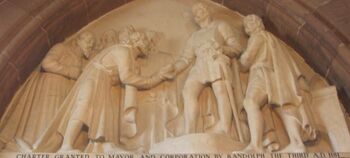
- 1181: Hugh de Kevelioc dies (30 June, at Leek). Ranulf de Blondeville succeeds to the earldom of Chester (like his father before him) as a minor (aged nine) and attains his majority in 1187. Supernova SN 1181 appears in Cassiopeia. One of only eight supernovae in the Milky Way observable with the naked eye in recorded history, it appeared around August 4th and was visible in the night sky for about 185 days. Robert of Chester revises Adelard of Bath's translation from Arabic into Latin of the astronomy textbook "The Astrolabe" by the Cordovan Arab Ibn al-Saffar.
- 1182: The Chester Chronicle records: "Richard Peche [or Peckham], bishop of Chester, died on Wednesday, October 6."
- 1183: The Chester Chronicle records: "September 25, Gerard Puella was consecrated bishop of Chester, at Canterbury, by Richard, archbishop of Canterbury" (some have suspected he was poisoned);
- 1184: Robert II Abbot of St. Werburgh dies. Ranulf de Blondeville was a ward of Henry II (until 1187) who seized the abbey and passed it on to Hugh de Nonant. Several Astrologers, including "William the Astrologer" (clerk to the Constable of Chester) predict the end of the world in 1186 - this was such a widespread belief that Archbishop Baldwin ordained a three-day fast. The Chester Chronicle records: "Gerard [Puella], bishop of Chester, of pious memory, died January 13, at Lichfield. In the same year there died Richard, archbishop of Canterbury, at Canterbury, and Jocelin, bishop of Salisbury, and the bishop of Chichester, and Waleran, bishop of Rochester, and Bartholomew, bishop of Exeter" and "In the same year, a certain monk of Chester, named William of Eccleshall, went into Ulster, to Down, and received the priory of the church of S. Patrick from Malachi, bishop of Down, and the lord John de Courcy [Earl of Ulster]. A great famine owing to the want of bread. "
- 1186: Robert of Hastings becomes 6th Abbot of St. Werburgh
- 1187: Arthur of Brittany, later stepson of Ranulf de Blondeville is born. See the Arthur Counter-factual for a fictional history of what might have happen thereafter.
- 1188 Ranulf de Blondeville's mother, the dowager Countess (still only 32) present three cheeses of does milk to the Archbishop of Canterbury. Gerald of Wales was present and reported that the cheeses were presented in small wicker baskets.
- 1189 Ranulf de Blondeville married to Constance of Brittany, the widow of Henry II’s son Geoffrey Plantagenet, and the mother of Arthur of Brittany, with whom King John contested the succession. Weak, ill, and deserted by all but an illegitimate son, Geoffrey, Archbishop of York, Henry II died at Chinon on 6 July 1189. His legitimate children, chroniclers record him saying, were "the real bastards." Foxe gives him an ignominious end: "In the five and thirtieth year of his reign, being in the castle of Chiven in Normandy, he died: at whose death those that were present were so greedy of the spoil, that they left the body of the king naked, and not so much could be found as a cloth to cover it, till that a page coming in, and seeing the king so ignominiously to lie, threw his cloak upon his nether parts; wherein, saith the author, was verified the surname which from his youth he bare, being called Henry Court Mantil."
Richard I (The Lionheart) (6 July 1189 – 6 April 1199). Third son of Henry II.
Richard described England as "cold and always raining" and spent only six months of his reign there while siphoning the kingdom's resources to support his Crusade. According to William Stubbs: "He was a bad king: his great exploits, his military skill, his splendour and extravagance, his poetical tastes, his adventurous spirit, do not serve to cloak his entire want of sympathy, or even consideration, for his people. He was no Englishman, but it does not follow that he gave to Normandy, Anjou, or Aquitaine the love or care that he denied to his kingdom. His ambition was that of a mere warrior: he would fight for anything whatever, but he would sell everything that was worth fighting for. The glory that he sought was that of victory rather than conquest." Lucian the Monk wrote his De Laude Cestrie, at the abbey in the 1190s. There have been some suggestions that Richard was homosexual: Richard, [then] duke of Aquitaine, the son of the king of England, remained with Philip, the King of France, who so honored him for so long that they ate every day at the same table and from the same dish, and at night their beds did not separate them. And the king of France loved him as his own soul; and they loved each other so much that the king of England was absolutely astonished and the passionate love between them and marveled at it.
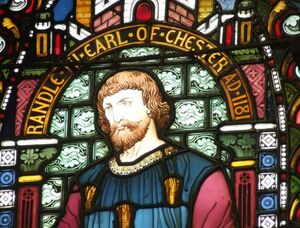
- 1189: Ranulf de Blondeville (aged 19) was present at Richard I's coronation, being the bearer of the crown. Prince John marries Isabella, Countess of Gloucester. It is likely that Joan, Lady of Wales was born prior to John's marriage.
- 1190: St John's Hospital (Little St Johns) founded by Ranulf de Blondeville: its site is now the Blue Coat School. Matilda of Chester (1171 – 6 January 1233), sister of Ranulf de Blondeville married David of Scotland, 8th Earl of Huntingdon, a Scottish prince, son of Henry of Scotland, 3rd Earl of Huntingdon, and a younger brother of Malcolm IV of Scotland and William I of Scotland. He was almost thirty years Matilda's senior. The marriage was recorded by Benedict of Peterborough. The office of mayor of Chester probably originated with Ranulf de Blondeville's grant of a guild merchant to the city in the 1190s. Although he was the head of the guild, the mayor ranked below the sheriffs.
- 1191: Richard I proclaimed his nephew, Arthur of Brittany, stepson of Ranulf de Blondeville as his heir to the English throne
- 1192: Charter of John of Mortain (later King John) to the citizens of Chester for their protection and freedom of trade with Ireland.
- 1193: Ranulf de Blondeville opposes John's coup.
- 1194: Ranulf de Blondeville fought alongside his brother-in-law David, Earl of Huntingdon for Richard I at the siege of Nottingham Castle (25-28th March). He then accompanied Richard to Normandy. After protracted litigation, Robert of Hastings' rival, Geoffrey, obtained the abbacy with the help of the now adult Earl Ranulf and at the price of a pension of 20 marks a year for Hastings.
- 1195: Roger of Hoveden spreads rumours about Richard: In the same year, there came a hermit to king Richard, and, preaching the words of eternal salvation to him, said: "Be thou mindful of the destruction of Sodom, and abstain from what is unlawful; for if thou dost not, a vengeance worthy of God shall overtake thee". The king, however, intent upon the things of this world, and not those that are of God, was not able so readily to withdraw his mind from what was unlawful, unless a revelation should come to him from above or he should behold a sign. For he despised the person of his advisor, not understanding that sometimes the Lord reveals to babes the things that are hidden from the wise; for the lepers announced the good tidings to Samaria [2 Kings 7], and the ass of Balaam recalled its master from the unlawful way. Wherefore, the hermit, leaving the king, went his way, and hid himself from before his face. In the process of time, however, although the before-named king despised the admonitions of the poor hermit, still, by inspiration of Divine grace, he retained some part of his warning in his memory, having faith in the Lord, that He who recalled the publicans and the Canaanitish woman to repentance, in his great mercy would give to him a penitent heart. Hence it was, that on the Lord's day in Easter when the Lord visited him with a rod of iron, not that he might bruise him, but that he might receive the scourging to his advantage. For on that day the Lord scourged him with a severe attack of illness, so that calling before him religious men, he was not ashamed to confess the guiltiness of his life, and after receiving absolution, took back his wife, whom for along time he had not known, and putting away all illicit intercourse, he remained constant to his wife and the two become one flesh and Lord gave him health of both body and soul…. Lucian the Monk writes the first "travel guide" to Chester in De Laude Cestrie ('Of the Praise of Chester') written around 1195 in the cloisters of Chester Abbey, we read: "The native of Chester remembers how three roads branch off outside Eastgate and how beautiful and pleasing are the names of the places to which they lead. The road straight in front straight in front leads to Christ's Town (Christleton), that on the right to the Old Ford (Aldford) but if it turns to the left it comes to a place which they rightly call the Valley of Demons (Hoole) with reference to the hiding places of those who lie in wait... the wanderer... is despoiled by thieves and robbers". Lucien, a monk at the Abbey of Chester (now the Cathedral) has the supposed distinction of being the first ever writer of a "guidebook" to anywhere in England outside of London. However he distorts geography to support theological arguments.
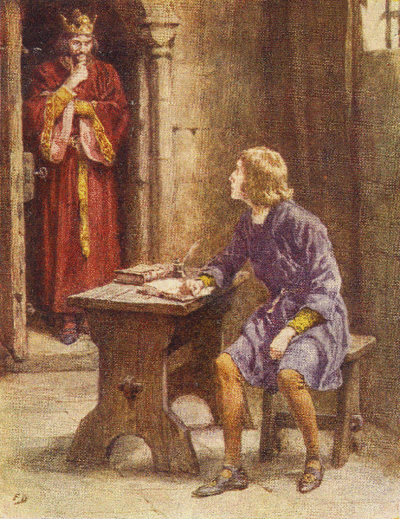
- 1198: Ranulf de Blondeville, Earl of Chester divorced from Constance of Brittany, the widow of Henry II’s son Geoffrey, and the mother of Arthur of Brittany.
- 1199: In the early evening of March 25, 1199, King Richard was walking around a castle (Chalus-Chabrol) he was besieging. One defender in particular was of great amusement to the king — a man standing on the walls, crossbow in one hand, the other clutching a frying pan which he had been using all day as a shield to beat off missiles. He deliberately aimed an arrow at the king, which the king applauded. However, another arrow then struck him in the left shoulder near the neck. A surgeon, called a 'butcher' by Hoveden, removed it, 'carelessly mangling' the King's arm in the process. The wound swiftly became gangrenous. Richard asked to have the crossbowman (Pierre Basile - a boy) brought before him. Richard, as a last act of mercy, forgave the boy his crime and died. His last act of chivalry proved fruitless as mercenary captain Mercadier had the crossbowman skinned alive and hanged as soon as Richard died.
John (Lackland) (6 April 1199 – 18/19 October 1216). Fifth son of Henry II
King John's reign has been traditionally characterised as one of the most disastrous in English history: it began with defeats—he lost Normandy to Philip Augustus of France in his first five years on the throne (the first real conflict with France)—and ended with England torn by civil war (The First Barons' War), the Crown Jewels lost and himself on the verge of being forced out of power. In 1213, he made England a papal fief to resolve a conflict with the Roman Catholic Church, and his rebellious barons forced him to sign the Magna Carta in 1215.
- 1200 Ranulf de Blondeville, Earl of Chester married to Clemence of Fougères; daughter of William of Fougères, widow of Alan de Dinant, and sister of Geoffrey of Fougères
- 1202: Charter of King to the Citizens of Chester in which he styles himself "King of England and Lord of Ireland" and "requests all Justices, Constables, Bailiffs and faithful people in the whole of Ireland to grant the citizens of Chester liberty to trade in Ireland as in the time of our Father King Henry I"
- 1203, in April Arthur of Brittany dies possibly at the hands of King John. Also in April, King John took a renewed oath of fealty from Ranulf de Blondeville.
- 1206: King John gave Isabel, the widow of Geoffrey of Chester, to Hugh le Despenser, unaware that she had privately married Roger de Creisy [who in 1207 obtained pardon for this offence]. In compensation Hugh got £20 annual rent in the manor of Waltham.
- 1208: Ranulf de Blondeville approves a law, as part of the market charter' to the efect that there cannot be another market within six and two third miles of Chester Market (as the crow flies). In 2014 this law is used to prevent Tesco holding a car-boot sale. Abbot Hugh Grylle is elected.
- 1209: Basingwerk castle burnt by Ranulf de Blondeville, Earl of Chester, after complaints from the monks of Chester that they had lost the Well Church at Basingwerk during the wars with the Welsh Princes. Ranulf had the castle rebuilt to protect the many pilgrims to the Well Church. Innocent III excommunicates John for attacks on Church property.
- 1210, King John lands at Waterford looking for the rebel baron William de Broase who had supposedly fled to Ireland. John took the opportunity to visit his lands in Ireland receiving homage from the Irish Chieftains. Maud, de Broase's wife and son were captured, taken back to England and starved to death in Windsor Castle. At Chester Castle the Agricola Tower is built as the bailey gatehouse with a first floor chapel, decorated with wall paintings.
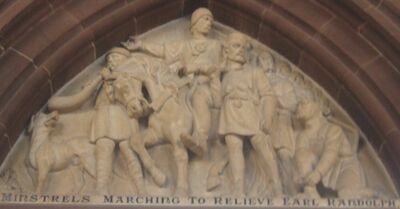
- 1211, King John visits Chester. Henry de Lacy rescues Ranulf de Blondeville from siege at Rhuddlan by collecting a body of "players, fiddlers and other loose persons" from the midsummer fair. This led to the Dutton/Button family being granted the right to hold the "Minstrel Court".
- 1213, Innocent III declares John deposed; John resigns his kingship to the pope and receives it back as a holding from the Roman legate, thereby ending the interdict.
- 1214, Ranulf de Blondeville established the abbey of Dieulacres at Abbey Green, near Leek, Staffordshire by moving Poulton Abbey. The story is that: Ranulf de Blondeville had a vision one night in bed. His grandfather, Ranulf de Gernon, appeared and instructed his grandson to go to Cholpesdale, in the territory of Leek, and found a Cistercian abbey there on the site of the former chapel of St. Mary the Virgin there, and to provide it with buildings and ample possessions. Ranulf de Gernon also ordered that in the seventh year of the interdict that would be placed upon England, his grandson should transfer to this new site the Cistercians of Poulton. Apparently, when Ranulf de Blondeville told his wife of this vision she exclaimed in French ‘deux encres’ – ‘may god grant it increase’. Thereupon Ranulf fixed the name.
- 1215, Ranulf de Blondeville witnesses the Magna Carta by John (who was voted "Worst Britain" of the 13th Century). Popular perception is that King John and the barons "signed" Magna Carta. There were no signatures on the original document, however, only a single seal placed by the king. The words of the charter — per manum nostram — signify that the document was personally given by the king's hand. By placing his seal on the document, the King and the barons followed common law that a seal was sufficient to authenticate a deed, though it had to be done in front of witnesses. John's seal was the only one, and he did not sign it. The barons neither signed nor attached their seals to it
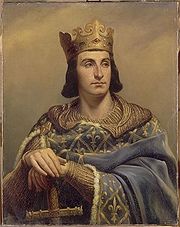
- 1216, Before John's death, rebel barons had offered the throne of England to Louis, the heir to the French throne. Louis had invaded the country during the summer of 1216 and had taken Winchester. Louis was proclaimed King at St Paul's Cathedral with great pomp and celebration in the presence of all of London. Even though he was not formally crowned, many nobles, as well as King Alexander II of Scotland (1214–49) for his English possessions, gathered to give homage. Ranulf de Blondeville put his political weight behind re-issuing the Magna Carta in 1216 and 1217. Retreating from the French invasion, John took a safe route around the marshy area of the Wash to avoid the rebel held area of East Anglia. His slow baggage train (including the Crown Jewels), however, took a direct route across it and was lost to the unexpected incoming tide. This dealt John a terrible blow, which affected his health and state of mind. Roger of Wendover provides the most graphic account of this, suggesting that the king's belongings, including the Crown Jewels, were lost as he crossed one of the tidal estuaries which empties into the Wash, being sucked in by quicksand and whirlpools. Succumbing to dysentery and moving from place to place, he stayed one night at Sleaford Castle before dying on 18 October (or possibly 19 October) 1216, at Newark Castle (then in Lincolnshire, now on Nottinghamshire's border with that county). Numerous, possibly fictitious, accounts circulated soon after his death that he had been killed by poisoned ale, poisoned plums or a "surfeit of peaches".
Henry III (Henry of Winchester) (18-19 October 1216 (Age 9) - 16 November 1272). Eldest son of King John.
Henry was the first child king in England since Ethelred the Unready (he was nine when crowned). Despite his long reign (56 years), his personal accomplishments were slim and, weak and vacillating, he was a political and military failure. Henry was much taken with the cult of the Anglo-Saxon saint king Edward the Confessor who had been canonised in 1161, and took to dressing like him. One pillar of Chester's economy remained its dominance over an extensive, if relatively impoverished hinterland. Its twice-weekly market was without serious rival between north-east Wales and the Marches to the west, Derby to the east, Shrewsbury to the south, and Lancaster and perhaps beyond to the north. Marketing was concentrated in the two open spaces by St. Peter's church and the abbey gate, but also spread into the main streets. The main commodities were agricultural. There were also two fairs, and of course a port. Its economy continued to expand, stimulated by royal interest and its role as a supply centre for royal enterprises in Wales, which more than compensated for the resultant temporary interruptions to the Welsh trade. If there was any hope for lasting peace with Wales it died with the last of the Norman Earls. Thereafter Edward, Lord of Chester and later Edward I, was never a man to compromise for long.
- 1217: Ranulf de Blondeville's military experience was utilised in defeating the rebels at the second Battle of Lincoln. Following the battle, in recognition of his support, Ranulf was created Earl of Lincoln by Henry III on 23 May 1217. With William Marshal acting as regent, a call for the English "to defend our land" against the French led to a reversal of fortunes on the battlefield. After Louis' army was beaten at Lincoln on 20 May 1217, and his naval forces (led by Eustace the Monk) were defeated off the coast of Sandwich on 24 August 1217, he was forced to make peace on English terms. In 1216 and 1217 Prince Louis also tried to conquer Dover Castle but without success. The principal provisions of the Treaty of Lambeth were an amnesty for English rebels, Louis to undertake not to attack England again, and 10,000 marks to be given to Louis. The effect of the treaty was that Louis agreed he had never been the legitimate King of England. Ranulf de Blondeville, granted the office of master-serjeant to Vivian de Davenport and his heirs.
- 1218: 11 February - letters of safe conduct were issued for Prince Llywelyn ab Iorwerth to come to Worcester. The next day Ranulf de Blondeville, Walter Lacy, Hugh Mortimer, John Fitz Alan, Walter and Roger Clifford were ordered to conduct him hither to pay homage to the king. In mid year Ranulf de Blondeville took part in the fifth crusade.
- 1220: Ranulf de Blondeville returns from the crusades and raises the Everton Beacon. Ranulf de Blondeville is offered the position of King of Jerusalem but turns it down. Trial by ordeal is abolished in England. Ranulf starts work on Beeston Castle.
- 1221: Fulk Fitzwarin III began rebuilding his fortress (Whittington Castle), with one eye on Wales for the reaction of Prince Llywelyn and his friend, Ranulf de Blondeville of Chester. One of the most prominent legends concerning Whittington Castle regards the Marian Chalice, thought by some to be the Holy Grail. According to this legend, Sir Fulk FitzWarin, the great grandson of Payne Peveril and one in the line of guardians of the Grail and King Arthur. A story from the 13th century states that the Grail was kept in a private chapel of the castle when Sir Foulke was there.
- 1222: according to "Picturesque England" King John visits Chester for a few days. This must count as a miracle since he died in 1216 (and this just goes to prove you can't believe everything you read on the web). Comet Halley returned as well. John Canmore married Elen ferch Llywelyn, daughter of Llywelyn the Great, at around this time.
- 1223: Ranulf de Blondeville attempts to broker peace between the English and the Welsh after Llywelyn the Great invades Shropshire.
- 1226: Abbot Hugh Grylle dies, William Marmion becomes Abbot of St. Werburgh
- 1227: Henry III assumed formal control of his government in January 1227. The Old Dee Bridge collapses during a flood. William the Clerk, is first known Mayor of Chester at around this time. John Canmore is knighted by Alexander II the king of Scotland on Whitsunday. Ranulf de Blondeville's mother dies.
- 1228: William Marmion dies and Walter de Pincebeck becomes Abbot of St. Werburgh
- 1231: Ranulf de Blondeville's sister Hawise became 1st Countess of Lincoln in April, when her brother resigned the title in her favour. He granted her the title by a formal charter under his seal which was confirmed by King Henry III. She was formally invested as suo jure 1st Countess of Lincoln by King Henry III on 27 October 1232 the day after her brother's death.
- 1232: Ranulf de Blondeville dies (26th October), aged 60. His heart was buried at Wallingford Castle, while his body was buried at St Werburg's. His earldom of Chester went to the son of his sister Maud of Chester, John Canmore known as "John the Scot". Henry III was anxious to be seen as the legitimate successor of the Norman earls, and especially of Ranulf de Blondeville. As early as 1232 he granted £3 a year from the manor of Newcastle-under-Lyme (Staffs.) to support a chaplain at Chester abbey to pray for Ranulf de Blondeville's soul. Hawise made an inter vivos gift, after receiving dispensation from the crown, of the Earldom of Lincoln to her daughter Margaret de Quincy who then became 2nd Countess of Lincoln suo jure and her son-in-law John de Lacy, Baron of Pontefract who then became the 2nd Earl of Lincoln by right of his wife. (John de Lacy is mistakenly called the 1st Earl of Lincoln in many references.) They were formally invested by King Henry III as Countess and Earl of Lincoln on 23 November 1232. Matthew Paris states that the John de Lacy was brought over to the king's party, with John Canmore, 7th Earl of Chester, by Peter de Rupibus, Bishop of Winchester, for a bribe of 1,000 marks.


- 1234: J. earl of Lincoln and constable of Chester had made fine with the king by 1000 m. for the custody of the lands and heir of Nigel de Mowbray, …. By the justiciar and Hugh Despenser. (S) FRsHIII.
- 1236: John Canmore attends the wedding of Hentry III and Queen Eleanor and carried the Sword of State before the king. The Blackfriars establish themselves in Chester.
- 1237: John Canmore dies (June 7th) aged 30, without issue, at Darnal and is buried at Chester the next day. Henry III hears of his death and is quick to take control of his castles at Beeston and Chester. After John's death, the honour of Chester was bought from Ranulf de Blondeville's sisters by Henry III. The earldom passes to Edward, Lord of Chester (later Edward I). Greyfriars settled in Chester by Albert of Pisa, the minister of the English province. Blackfriars turned up at the same time! To the constables of the castles of Chester and Beeston. The king is sending them Stephen de Segrave [married to Hugh’s sister Rohese], Henry de Aldithelegh and Hugh le Dispenser to provider for the custody of those castles … (S) CPRs. John de Lacy appointed High Sheriff of Cheshire, and Governor of Chester Castle.
- 1238: Alexander de Stavensby, bishop of Chester, died on S. Stephen's Day [December 26] at Andover. William the Clerk possibly becomes the first Mayor of Chester.
- 1239: Henry III provided for three beds for the poor and infirm in St John's Hospital without the Northgate.
- 1240: Walter de Pincebeck, Abbot of Chester, dies - Roger Frend elected Abbot. Llywelyn the Great dies (aged 68). John de Lacy becomes the governor of Chester and Beeston castles. By this time the Agricola Tower chapel at Chester Castle has been given a second coat of wall paintings of very high quality and focused on the Virgin. William the Clerk has been appointed the first mayor of Chester by this date.
- 1241: Henry III in Chester and meets with Dafydd ap Llywelyn who hands over his nephew Owain Goch ap Gruffydd as a prisoner. Hugh de Pateshull, bishop of Chester, died. Walter of Coventry becomes mayor of Chester. Henry III uses Chester Castle as a base for his campaigns in Wales, and an ‘oriel’ is constructed before the doorway of the King’s chapel. The castle was used as a jail from this time.
- 1245: Chester used as a base for the invasion of Wales. Henry III visits Chester while campaigning against Dafydd ap Llywelyn of Wales. The King’s apartments at Chester Castle were repaired, the paintings in the Queen’s chamber renewed and a bridge made from the castle into the orchard.
- 1246: Dafydd ap Llywelyn dies. Owain Goch ap Gruffydd, brother of Prince Llewelyn conveniently "escapes" from Chester Castle. Major remodeling and expansion occurs starts at Chester Castle.
- 1247: Llywelyn ap Gruffydd and Owain ap Gruffydd came to terms with King Henry in the Treaty of Woodstock at Woodstock Palace. The terms they were forced to accept restricted them to the part of Gwynedd west of the River Conwy, which was divided between them. East of the Conwy the land was taken over by King Henry.
- 1248: Henry III completes a new chamber over a cellar at Chester Castle at a cost of £220.
- 1249: Bonewaldesthorne's Tower first documented. Roger Frend dies, Thomas Capenhurst elected Abbot of St. Werburgh
- 1251: Henry III completes the replacement of the wooden palisade round the Outer Bailey of Chester Castle with a stonewall. Henry III demolishes the hall in the Outer Bailey of Chester Castle.
- 1253: Edmund Crouchback (briefly) becomes Earl of Chester? The title is later transferred to his elder brother Edward (later Edward I) as "Lord of Chester". Henry III completes a new Great Hall at a cost of £350 at Chester Castle.

- 1254: Prince Edward (later Edward I) becomes "Lord of Chester" (he never formally became "Earl")
- 1255: "the Welsh under Llewlyn ap Gryffyd, made a powerful interruption into this neighbourhood, where they committed great ravages, carrying fire and sword to the very gates of the city, and destroying everything around on both sides of the river. This hostile attack was inflicted for the cruelties perpetrated on the Welsh by Geoffrey Langley, lieutenant of the county under prince Edward." (Hemingway)
- 1256: Llewlyn ap Gryffyd sweeps English from Wales. Prince Edward, visits the city, arriving during the Festival of St Kenelm (see entry for 825).
- 1257: "In this year, too, Bishop Roger of Westham having ret signed his see in consequence of his old age and infirmities, the monks of Coventry elected as their bishop and pastor of their souls Master Roger de Molend, the king’s nephew, whom the king accepted and approved of, as he ought, for he could not in honesty reject him, as he usually did in the case of others. Moreover, he had entreated the conventual brethren to elect his treasurer Philip Lovel as their pastor. Therefore, at the instigation of Earl Richard, they elected the aforesaid Master Roger, to whom the king was favourably inclined, and who was, moreover, his nephew." (StAlbC) He did not last long: " Master Roger of Westham, bishop of Chester, a most praiseworthy man, went the way of all flesh. He had long suffered from an attack of the palsy, and had resigned his bishopric. He was succeeded by Master Longsword." (StAlbC). Sir Walter Lynnet becomes mayor of Chester - some sources say the first (until 1260). Pigot writes: The King determined himself to undertake an expedition against the Welsh and summoned all who held to him by Knight's service to attend him at Chester on St Mary Magdalen's day this year he accordingly marched with a great army but was obliged to make an inglorious retreat. The king returned from Chester. The St Albans Chronicle is typically rude about the Welsh: "At the decline of autumn, as the approaching winter had shortened the days and brought on cold, and as the greatest scarcity prevailed in his army, the king, by the advice of his especial counsellors, who could ill bear this state of want, took his departure from Chester, and returned towards London, to be present at the festival of the Translation of St. Edward. Llewellyn, on hearing of this, followed him in pursuit for a long time, for the purpose of attacking and slaying any stragglers from the king’s army. Thus, after expending a great deal of money, the king returned ingloriously, and followed by the derisive sneers of the enemy to his own country, which was a place of greater safety for him; yet he marched handsomely armed in the midst of his army, with the royal standard unfurled, and encouraged his fellow-warriors to slaughter those dregs of the human race, the Welsh."
- 1258: Roger of Meulan becomes Bishop of Chester. "On the morrow and the succeeding days, the king and the nobles held careful deliberation as to how they should crush the insolence of the Welsh, and check their frequent irruptions. The whole community of knighthood was therefore summoned, in order that all those who were bound to render knightly service to the king, might equip themselves with horses and arms, and be ready at Chester, to follow the king on an expedition into Wales, on the Monday before the Nativity of St. John the Baptist. In consequence of this, manifold murmurs and complaints were heard amongst the people, because the king so often impoverished and harassed his nobles without honour or profit, by so often requiring scutage of them, and disturbed them on the approach of harvest-time, especially when such an unusual famine had destroyed so many people." (St Albans Chronicle). The "unusual famine" was probably due to the eruption of a volcano, Samalas, in Indonesia.
- 1260: Walter Coventry becomes mayor of Chester. King Edward raised substantial loans from the city of Chester.
- 1261: Richard the clerk becomes Mayor of Chester (until 1268).
- 1263 During the Second Barons' War (1263-1267) Chester was held for the Lord Edward by the justice, William la Zouche, who in 1263 "took violent possession of St. Werburgh's".
- 1264: Henry III defeated and taken prisoner by Simon de Montfort's army and reduced to being a figurehead king. Henry III and Prince Edward (Lord of Chester) placed under house arrest. Simon de Montfort briefly becomes Earl of Chester (until 1265). The Chronicle recorded: "William la Zouche, the justiciary, and the citizens of Chester, fearing that the city was about to be besieged by the barons or by the Welsh, at the suggestion of a certain cursed fellow named Robert Mercer, then sheriff of the city, the day before the Annunciation of Our Lady [March 24], pulled down the houses of S. Werburg that were in Bog lane, and, after totally destroying the gardens, they began to dig a ditch round the city, the justiciary himself and David Fitz-Griffin faithfully promising to the abbot that the lord Edward should restore an equivalent of land and rents to the church of S. Werburg." While the defensive ditch immediately north of the city walls, destroyed property belonging to the abbey in the process, it may have formed the basis of the cutting which now holds the canal. "About this time, Llewellyn, prince of Wales, allied himself with Earl Simon, and during all this time ravaged the county of Chester" (St Albans Chronicle).
- 1265: Simon de Whitchurch becomes 13th Abbot of St. Werburgh. Llywelyn captured Hawarden Castle and routed the combined armies of Hamo Lestrange and Maurice fitz Gerald in north Wales. Edward escapes: " the king's son Edward, who was detained in custody in the castle of Hereford, obtained permission from his guards to take exercise in a field outside the city, and to amuse himself with trying the speed of their horses. On one occasion, after trying several horses and tiring them out, he at length chose a good one, which he mounted, and urging him to speed with his spurs, he bade farewell to his guards .... Edward assembled a large army, as numbers flocked to join him, and the counties of Hereford, Worcester, Salop, and Chester, entered into an alliance with him, the towns and villages, cities and castles, pouring forth their inhabitants to join his standard."
- 1267: Royalist supporters of Henry III besieged Luke de Taney (he of the battle of Moel-y-don), Simon de Montfort's justice of Chester, in Chester castle during the Second Barons' War. Dominus autem Eadwardus apud Herford die Jovis in Septimana Pentecostes de custodia Domini Simonis de monteforti evasit. Quo audito Jacobus de Audethlegio et V.de Sancto Petro, Sabbato sequenti castrum de Beuston nomine domini Edwardi ceperuntetdie Sancte Trinitatis Cestriam venientes de consilio civium, Lucam de Taney cum suis complicibus infra castrum Cestrie obsederunt per decem Septimanas continuas nec tamen illud obtinuerunt propter optimam inclusorum defencionem. Jacobus de Audethlegio factus est Justiciarius. Dominus vero Eadwardus interim associatis sibi Gilberto de Clare et aliis commarchionibus suis Simonem de Monte forti Henricum filium ejus Hugonem Disspenser, Petrum de Monte forti, Radulfum Basset et eorum complices sæpius [d]ebellavit et tandem eos apud Evsham ij. non. Maii in bello campestri prostravit: Winfridum de Bon, Henricum de Hasting, Guydonem de Monte forti in ipso bello captos apud castrum de D.(?) Beuston secum ducendo captivos. Audiens autem Lucas de Taney dominum Edwardum apud Beston venisse ij vigilias Asumpcionis castrum Cestrie reddidit eidem se suosque gratie sue subjiciendo. (But the lord Edward escaped from the custody of Simon de Montfort at Hereford on the Thursday in Whit Week. When this was known James de Audley and Urian de Saint Pierre on the following Saturday seized the castle of Beeston in the name of the lord Edward, and coming to Chester on Trinity Sunday, they besieged Luke de Taney and his accomplices in the castle of Chester for ten consecutive weeks, but did not succeed in taking it, on account of the excellent defence made by the besieged. James de Audley was made justiciary of Chester. In the meantime the lord Edward, Gilbert de Clare and others his fellow marchers being joined with him, made frequent attacks upon Simon de Montfort, Henry his son, Hugo Despencer, Peter de Montfort, Ralph Basset, and their accomplices, and at length completely overthrew them on the battlefield of Evesham on May 6. Humphrey de Bohun, Henry de Hastings, and Guy de Montfort, who were captured in this battle, Edward took with him as prisoners to Beeston castle. When Luke de Taney heard that the lord Edward had come to Beeston, he surrendered the castle of Chester on the day before the eve of the Assumption, submitting himself and his companions to Edward's grace.) Luke de Taney was the fiancée of a mediaeval mayors daughter who hit a ball away in a game and sent him to look for it, then escaped through the Peppergate to elope with a waiting Welsh Knight. Thereafter, Peppergate was kept locked. After 1267 Llywelyn ap Gruffyd's annual payments in return for recognition as prince of Wales and other concessions made in the Treaty of Montgomery were handed over to the king's envoys at St. Werburgh's abbey.
- 1268: John Arneway becomes Mayor of Chester (until 1277).
- 1272: Henry III dies. His body was laid, temporarily, in the tomb of Edward the Confessor (with whom he was obsessed) while his own sarcophagus was constructed in Westminster Abbey.
After the Norman Earls (Chester in the Late Medieval) 1272-1399
By the time of the death of the last of the Norman earls Chester was a prosperous trading center. This period of history is marked by successive favors being granted on Chester by successive monarchs, who had now taken the Earldom as a royal possession (see Earls of Chester). War with wales continued bringing wealth to the city which acted both a staging point for supplies and a winter retreat for workers building the castles of North Wales (one of whom was to become major). The privileges granted reached their zenith under Richard II, who elevated Cheshire to a principality with himself as prince.
Edward I (Hammer of the Scots) (20 November 1272 – 7 July 1307). Eldest son of Henry III.
Unlike his father, Henry III, Edward I took great interest in the workings of his government and undertook a number of reforms to regain royal control in government and administration. He also took a great interest in invading Wales and later Scotland. He is supposed to have invented "hanging drawing and quartering", although Matthew Paris describes an almost identical form of execution from 1238
The late 13th and early 14th century probably saw the peak of Chester's prosperity in the Middle Ages. Though there was a corn market in Eastgate Street by the 1270s, and though some corn was undoubtedly grown in the county and by the citizens themselves in the town fields, considerable quantities of wheat and barley had to be brought in from further afield, principally Ireland. The grain was not simply for home consumption: the city also acted as a centre for distribution throughout its region. Although trade with the native Welsh was suspended during Edward I's campaigns, such disruption was more than counterbalanced by the citizens' provisioning of the English armies. Edward I used Chester as his base for military campaigns against North Wales in 1277 and 1282, and hundreds of masons, carpenters and laborers employed to build the "Welsh" castles had their winter billet in Chester. The city was at the height of its prosperity and wealthy merchants could embark on a building boom with some of the country's most highly skilled craftsmen on hand. The Rows seem to have been largely in place by c1350. Trade rose to a peak during the campaign of 1282-3, when foodstuffs, including peas, beans, wine, salmon, cheese, and salted meat as well as corn, flowed through Chester in quantities which far exceeded those from any other province apart from Ponthieu. With the establishment of peace Chester resumed its wider distributive role. The extremely high tax income of the Dee Mills throughout the 13th and earlier 14th century perhaps reflected toll income resulting from Chester's role as an entry-port for wheat, oats, barley, and malt.
- 1273: Prince Alphonso becomes Earl of Chester? - see Earls of Chester.
- 1274: Kaleyard gate cut through the walls so that monks could reach their cabbage-patches. In the 13th century the monks of St Werburgh's Abbey had developed a vegetable garden (known as the kaleyard) outside the city walls. Access to it was by a devious walk through Eastgate and they wanted to have an easier route. They petitioned Edward I to allow them to cut a gate through the wall to provide direct access to the garden. This he allowed under certain conditions, one of which was that it must be locked at nightfall. Guncelin de Badelesmere becomes constable of Chester castle.
- 1275: Edward called Llywelyn ap Gruffydd, ('Llywelyn the Last') then Prince of Wales, to Chester Castle to pay homage, Llywelyn refused to attend. The sergeancy of the Eastgate was given, on January 2nd 1275 (in consequence of a royal mandate by Reginald de Grey, Justice of Chester), to "Henry de Bradford" and Robert his son, together with "Bruardeshalgh" (Brewer's Hall) as a compensation for their manor of Bradford, which had been ceded to Vale Royal Abbey. The King’s houses in the Outer Bailey of the Castle were renovated for the Earl of Warwick and given a new chapel.
- 1276: The king and queen's chambers at Chester Castle were repaired and a new chapel was built in the outer bailey. The Blackfriars apply to pipe water from Boughton. Edward appointed the mayor and citizens of Chester to furnish two ships to serve in his Scottish wars (An 4 Edw I). The pipe rolls make it clear that the master-serjeant was entitled to the fee of one shilling per robber's head delivered to Chester Castle. Robert de Ufford becomes constable of Chester castle.

- 1277: the Whitefriars were established in Chester (and Edward sends some cash to the little known Friars of the Sack). Edward's army camps at Saltney before invading Wales. By the summer of 1277, Edward's forces had reached the heart of Gwynedd. Edward's men confiscated the harvest in Anglesey, which deprived Llewelyn and his men of food, forcing Llewelyn to surrender and sign the Treaty of Aberconwy. Edward I used Chester as his base for military campaigns against North Wales in 1277 and 1282, and hundreds of masons, carpenters and laborers employed to build the "Welsh" castles had their winter billet in Chester. The city was at the height of its prosperity and wealthy merchants could embark on a building boom with some of the country's most highly skilled craftsmen on hand.
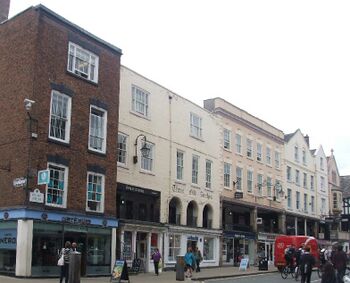
- 1278: Great fire destroys almost all the buildings within the City Walls. Llewelyn and Eleanor de Montfort were married (formally) in Worcester Cathedral, with Edward present at the nuptials. Before the wedding mass was celebrated, Edward insisted that Llywelyn should put his seal to an adjustment to the agreement that they had previously made. Llywelyn had no alternative but to comply, and he later stated that he did it under duress, 'moved by the fear that can grip a steadfast man'. Welshmen swear on the "Rood of Chester" (a relic at St Johns Church) not to bear arms against Edward. A charter for a market to be held each Monday at Bromborough was granted by Edward to the monks of St. Werburgh's Abbey. The monks are licensed to make a conduit from a well at Newton.
- 1279: Old Dee Bridge swept away. The mayor and citizens were granted a three-year pavage of ½d. on every cartload of firewood or coals brought into the city. Guncelin de Badelesmere becomes constable of Chester Castle (again).
- 1282: Dafydd ap Gruffydd attacked Hawarden Castle, thereby starting the final conflict with Plantagenet-ruled England. Pipes were laid to bring water to the Cathedral from Christleton. Luke de Taney now served Edward I of England during his conquest of Wales by successfully capturing Anglesey. From Anglesey, de Tany sent a strong force over the Menai Strait (using a "bridge of boats" - pretty impressive given the width of the straits) but they were defeated at the Battle of Moel-y-don. Luke de Taney was slain during the battle. Llywelyn ap Gruffudd, Prince of Wales was killed at Battle of Orewin Bridge at Builth Wells, 11 December 1282.
- 1283: Dafydd ap Gruffydd captured and taken to Chester. Dafydd was dragged through the streets of Shrewsbury attached to a horse's tail then hanged alive, revived, then disembowelled and his entrails burned before him for "his sacrilege in committing his crimes in the week of Christ's passion", and then his body cut into four quarters "for plotting the king's death". Geoffrey of Shrewsbury was paid 20 shillings for carrying out the gruesome task on 3 October 1283 (though some sources give the date as 2 October). Chester first sent representatives to Parliament (Cheshire’s status as a palatinate with its own Parliamentum meant that Chester did not receive further writs until it was enfranchised by statute in 1543).
- 1284: Alphonso, Earl of Chester, dies shortly after the birth of his younger brother (later Edward II of England), who became the only surviving male heir of Edward I.. New domestic buildings were begun at Chester Castle. New counties were created, including Flintshire - under the control of the Justice Of Chester.
- 1290: a three-year "murage" grant is made for the repair of the walls of Chester.
- 1291: Thomas de Burchelles is elected fourteenth Abbot of St. Werburgh
- 1292: a new outer gateway was added to Chester Castle with twin drum-towers on either side of a vaulted passage defended by a pair of portcullis.
- 1293: a mason worked from April until December making a seat for the king in the new chapel at Chester Castle and a new garden was laid out ouside the building. "Bakers Row" and "Ironmongers Row" are recorded.
- 1294: The King passed through Chester en route to Wales to quell the rebellion of Madog ap Llywelyn.
- 1295: the Justice of Chester was ordered to recruit 100 experienced masons from Chester and send them to Caernarfon "without delay".
- 1296: Chester was among the two-dozen English towns ordered to select two citizens to attend the autumn parliament at Bury-St-Edmunds.
- 1298: Justice of Chester, Sir John Grey took part in the expedition against William Wallace.
- 1300: Edward I grants Chester a new charter, which confirmed all the citizens' gains during the previous century, recognized the offices of mayor and city coroner and the grant to the citizens of the fee farm, set at £100 a year, only half of what had been demanded in the 1230s.
- 1301: Edward I gave the Earldom of Chester to his son Edward (later to be Edward II) during his last visit to the city. Halley's comet appears.
- 1302: Fire in the Agricola Tower at Chester Castle.
- 1303: "Saddlers Row" recorded.
- 1305: "Richard the Engineer" (who lived in Lower Bridge Street) was elected mayor of Chester. Richard was the builder of many of Edward's Welsh castles. By 1305 the mayor had taken over the presidency of the portmote for civil as well as criminal cases. By then, too, the portmote roll was dated by reference to both mayor and sheriffs, instead of the sheriffs alone, as had been customary earlier.
- 1307: Edward I died at Burgh-by-Sands, Cumberland on the Scottish border, while on his way to wage another campaign against the Scots under the leadership of Robert the Bruce. He asked to be buried in a lead coffin until such time as Scotland was conquered by the English - then be moved to the traditional gold box. He is still in the lead coffin. The then holder of the office of Chester master-serjeant (Thomas de Davenport) leased the sergeantry to Henry de Cotton for a period of two years, at £10 per annum. He then successively leased it from thereafter at the rate of £10.13.4 per year.
Edward II (7 July 1307 - 20 January 1327). Second son of Edward I. First royal Earl of Chester to become king.
Edward II had few of the qualities that made a successful medieval king. Edward surrounded himself with favourites (the best known being a Gascon, Piers Gaveston), and the barons, feeling excluded from power, rebelled. Throughout his reign, different baronial groups struggled to gain power and control the King.
In the reign of Edward II, when they were first recorded in detail, tolls were levied on the goods of 'foreign' merchants as they entered and left the Chester, the citizens themselves being exempt. At the Eastgate, the principal entry for landborne traffic and the only gate at which tolls could be paid in cash, there was a tariff for wool, salt, coal, timber, 'long boards', bark for tanning, turf, knives, cups, dishes, and tankards. Merchandise produced within Cheshire, including corn, malt, lead, iron, steel, and livestock, was exempt. At the Northgate the serjeant took toll on a wide variety of sea fish and shellfish, ale, fruit, sheep, timber, shingles, coal, firewood, and turf. At the Bridgegate tolls were taken on cattle brought in from Wales, fish and shellfish of various kinds, hops, nuts, firewood, turf, coal, timber, shingles, laths, bark for tanning, knives, cups, and dishes. Levies were presumably also made at the two adjacent gates, the Shipgate and the Horsegate, for which the serjeant of the Bridgegate was also responsible. The commodities which passed through the Watergate were similar, and included barley, various kinds of fish, coal, cups, dishes, and knives.
- 1309: Irresponsible cooks were fined for scorching the street surface outside the Buttershops
- 1311: Chester is asked to supply two ships for the campaign against Robert the Bruce.
- 1312: Edward II visits Chester to meet and welcome Piers Gaveston (reputedly his lover) on his return from exile in Ireland. The Piers Gaveston Society is reputed to be a secret dining club at the University of Oxford with membership limited to 12 undergraduates. It is supposedly named in honour of Piers Gaveston.
- 1314: Battle of Bannockburn: Robert Bruce defeats Edward II and makes Scotland independent.
- 1316: During The Great Famine, Chester merchants are licensed to go to Ireland to buy corn and other victuals for the king. Twelve jurors from the city and twelve from the county approved the transfer of St John's Hospital to the guardianship of Birkenhead priory (at that time impoverished by the cost of providing hospitality to travellers).
- 1322: Chester Castle granted to Edward II's favourite (and lover), Hugh Despenser the younger (voted "Worst Britain" of the 14th Century). William of Doncaster was involved, with seven other leading Chester merchants, in shipping merchandise including 105 tuns of wine from Bordeaux to Chester, but the vessel which they chartered was attacked by armed men off Anglesey and its cargo was lost or damaged.
- 1323: The The Water Tower and spur wall from Bonewaldesthorne's Tower on the north-west corner of the City Walls built at a cost of £100 to protect the harbour. The architect was John (de) Helpston who had also designed castles for King Edward II in North Wales. At the time it was known as the New Tower
- 1326: Chester Castle returned to Edward II, Hugh Despenser the younger brutally executed at Hereford on 26 Nov - with a huge crowd gathered in anticipation. He was dragged him from his horse, stripped, and had biblical verses against corruption and arrogance scribed on his skin. The list of charges against him read out (taking a great time). He was then condemned to hang as a thief, be castrated, and then drawn and quartered as a traitor - his quarters to be dispersed through England. As he was hacked to pieces, Isabella of France, Queen of England hosted a small picnic in the viewing gallery for her friends and ladies-in-waiting.
- 1327: there was unrest in Chester following Edward II's deposition - in July the former mayor, Richard le Bruyn was imprisoned at Chester Castle accused of supporting the Earl of Mar, an "enemy and a rebel". In August the Justice was ordered to arrest the large number of outlaws who had gathered in the vicinity of the city. Edward II is done to death with a red-hot poker. Isabella of France and Roger Mortimer imprisoned eighteen children in Chester Castle as hostages for the good behaviour of the townspeople (Close Rolls 1327-1330, pp. 169, 187-188).
Or was he .. in 1877, Alexandre Germain, professor at the university of Montpellier, discovered an undated document written by Manuele de Fieschi, papal notary, priest in York, bishop of Vercelli (1343-1348). According to him, Edward escaped from prison, fled to Normandy, then to Avignon where the pope John XXII sheltered him. He then went to Paris, Koln, Milan, and lived for two and a half years in the castle of Melazzo, near Acqui (nowadays in Piedmont region, northern Italy); finally, he moved to the castle of Cecima (province of Pavia), where he lived for 2 more years as an hermit. He was then buried in the abbey of Sant'Alberto di Butrio: in the small closter, a sign over an empty tomb reads "here is the tomb where was buried Edward II King of England, who married Isabelle of France and whose successor was Edward III, son of him."
sources and links
- Edward II at blogspot - "Why almost everything you think you know about Edward II is wrong".
- A note on the deaths of Edward II - Ian Mortimer
- Chester in the Plantagenet and Tudor Reigns Rupert Morris( 1893)
Edward III (25 January 1327 (aged 14) – 21 June 1377). Son of Edward II (previously Earl of Chester).
Edward was one of the most successful English monarchs of the Middle Ages. Restoring royal authority after the disastrous reign of his father, Edward III went on to transform the Kingdom of England into the most efficient military power in Europe. His reign saw vital developments in legislature and government—in particular the evolution of the English parliament — as well as the ravages of the Black Death. He remained on the throne for 50 years; no English monarch had reigned for as long since Henry III, and none would again until George III. In 1361 the citizens of Chester claimed that they lived by trade. In the later Middle Ages, however, the port suffered from facing west, away from the Continent, and also perhaps from the silting of the Dee estuary, as was frequently alleged. Ships with very heavy cargoes, such as wine and millstones, unloaded at anchorages in Wirral, the goods then being transferred to smaller craft or carts, but the city's own harbour at Portpool handled fish, Welsh slates, woollen cloth, hardware, and malt, and at high tide the smallest vessels could reach the New Tower (Watertower) at the north-western corner of the city walls.
- 1332: Supposed discovery within the church of St Johns of the his remains of Harold II, clad in leather hose, golden spurs, and crown
- 1333: Edward, the Black Prince, created Earl of Chester
- 1336: three hundred Cheshire archers accompanied John Legh and John Ardern amongst other leaders to Gascony.
- 1340: it was re-affirmed that "during the time of war with Wales, all persons, being in the peace of the King of England and the Earl of Chester ....(could)... have refuge on Hoole Heath, with their goods, necessaries, and beasts, for a year and a day."
- 1341: the Black Prince took St John's Hospital with its estates into his own hands because "certain duties were not being carried out" and an inquiry was ordered into its governance.
- 1343: Chester was named as a place to which wool bought below the fixed price was taken to evade customs. The city was expressly excluded from the national customs system and closed to the export of wool.
- 1344: at about this time Ranulf Higden, monk of Chester completed the Polychronicon.
- 1345: "This summer was called the dry summer for from March until the latter end of July there fell little rain or none by reason whereof corn was very scant the year following" (Hemingway)
- 1346: Revenue for the Dee Mills is £245 - this will fall sharply in the next few years due to the Plague. Work begins on the renewal of the Old Dee Bridge but this is later abandoned due to the Plague.
- 1349: The Black Death sweeps through Chester killing about one third of the population. The Rows seem to have been largely in place. Pigot writes: "The Mayor was slain this year by Richard Ditton who was pardoned paying 150 marks". Richard de Seynesbury elected 16th Abbot of St. Werburgh
- 1351: As part of an investigation of his earldom's franchises, the Black Prince instituted quo warranto proceedings in Chester. For ratification of their charters and declare of the bounds of their liberties, the citizens of Chester agree to pay a "fine" of £300, which (because they were impoverished) was to be collected in instalments over five years. The Old Dee Bridge was "in such plight that no one [could] pass over it".
- 1352: Raulph Higden, author of the Polychronicon is summoned to London by Edward III - "Father Ralph, a monk of the abbey at Chester, is summoned to Westminster on 21 August 1352 ‘with all your chronicles, and those which are in your charge to speak and take advice with our council on certain matters which will be explained to you on our behalf." (Calendar of Close Rolls, 1349-54, p. 499.)
- 1353: Edward the Black Prince, Earl of Chester, visits Chester "in great state" and stays for two months. Due to high food prices following the Black Death there is the threat of civil unrest.
- 1354: the Black Prince asserted that "there were more evil-doers within the city than in the entire shire outside it". In the Charter granted by the Black Prince Chester's boundaries extended well beyond the walled city and included the settlements of Handbridge, Boughton and Lache. The Castle and its surroundings and the Abbey precincts were exempt from mayoral authority. This charter (An 28 Edw III) also granted the Mayor and Citizens admiralty rights over the River Dee "from Iron Bridge to Arnold's Eye" (now the Red Stones at Hoylake). The Lord Mayor today is still the Admiral of the Dee and carries the "Water Bailiff’s Oar"" as a symbol of authority.
- 1356: four hundred Cheshire archers accompanied Hamo Massey, Robert Legh, Robert Hyde and John Danyers to Scotland.
- 1357: Mayor and the commonality of Chester petition the Black Prince for a reduction in taxes claiming that most of those who should have paid have died in the Plague. Empty and ruined tenements are reported throughout the city among them Stone Hall in Lower Bridge Street and many shops are closed. The Black Prince orders that no-one should buy or sell goods within four leagues of Chester except at official markets. He also ordered the mayor and citizens of Chester to make: "...with all speed their part of the bridge of Dee... in the same manner and style as the remainder of the bridge which has been newly made."
- 1360: new tenants has been found for much commercial property, including "a shop on Ironmongers Row" (Northgate Street).
- 1361: the city's tanners paid the Black Prince to establish a monopoly in the production of leather.
- 1361: Richard de Saynsbury (17th Abbot of St. Werburgh) forced to resign
- 1363: Thomas of Newport elected 17th Abbot of St. Werburgh
- 1364: Ranulph Higden: compiler of the Polychronicon dies and is buried in the South Choir Aisle of the Abbey (now the Cathedral).
- 1370: after prolonged challenges Chester shoemakers are granted the right to tan their own leather.
- 1375: First known performance of the Chester Mystery Plays;
- 1376: Edward the Black Prince, Earl of Chester, dies and so never ruled as king (becoming the first English Prince of Wales to suffer that fate). Around 29 September 1376 Edward III had fallen ill with a large abscess. After a brief period of recovery in February 1376, the king died of a stroke (some sources say gonorrhoea) at Sheen on 21 June.
Richard II (22 June 1377 (age 10) - 29 September 1399). Son of Edward, the Black Prince (previously Earl of Chester).
Richard is famed for his pivotal role in resolving the Peasants' Revolt of 1381, and for his purported misdemeanour's as King. Richard himself favoured genteel interests like fine food, insisting spoons be used at his court and inventing the handkerchief. He exiled his council, and turned to his circle of favourites for his council - it is also possible that Richard had a homosexual relationship with Robert de Vere - Thomas Walsingham called it 'obscene' and 'not without a degree of improper intimacy'. The Lords Appellant were a group of nobles in the reign of King Richard II who sought to impeach some five of the King's favorites in order to restrain what was seen as tyrannical and capricious rule. While initially successful, in 1398 Richard had them arrested: the Earl of Arundel was executed and Warwick imprisoned in exile, while Gloucester "died in captivity". Finally able to exert his autocratic authority over the kingdom, he purged all those he saw as not totally committed to him, fulfilling his own idea of becoming God’s chosen prince. He even took the title "Prince of Chester". Though probably not insane, as earlier historians used to believe, he may have suffered from a personality disorder towards the end of his reign. Richard II's government became highly unpopular outside of his strongholds in Cheshire and Wales, and he exiled Bolingbroke, the son of Edward III's third son John of Gaunt. This eventually led to both to his forced resignation and civil war.
- 1378: Comet Halley revisits. There is no surviving record of its apparition.
- 1379: "A bushel of wheat sold for 6d a gallon of white wine for 6d, a gallon of claret for 4d, a fat goose for 2d, a fat pig for 1d. A Mayor's Feast containing all the dainties of the season cost exactly eleven shillings and ten pence."
- 1381: John Holland half-brother to Richard II made Justice of Chester;
- 1385: John Holland dismissed after the murder of Ralph Stafford, eldest son of the Earl of Stafford. Edmund of Langley made Justice of Chester;
- 1386: At the Wonderful Parliament in response to King Richard's extravagant patronage of such favorites as Robert de Vere, the appointment of fourteen Commissioners to oversee Royal expenditure.
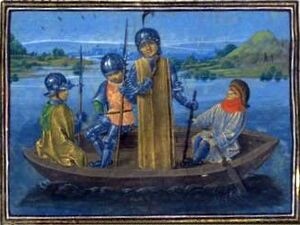
- 1387: Robert de Vere divorces his wife and moves to Chester with Agnes de Launcekrona. Richard II visits Chester and grants its citizens a murage for the repair of the ruined Old Dee Bridge: Letters Patent granted to the citizens on 25 July 1387 state: “Know ye that of our special grace and at the supplication of our lieges, the Commonalty of our town of Chester, and for consideration that as many have been drowned in the water of the Dee since the bridge has been destroyed and broken. And also, because the same town for that reason is very greatly impoverished as we are informed, we have granted to the fabric and repair of the aforesaid bridge all the profits of the Passage of the said water at Chester and the Murage which used to be granted there for the walls, to be received until that bridge is rightly and reasonably completed”. First mention of the High Cross in the city records. Robert de Vere made Justice of Chester. The Lords Appellant rebel. Richard II. sent secretly to Robert de Vere, Duke of Ireland, who was levying troops in Wales, to come to him with all speed, to aid him with the Duke of Gloucester and his friends; and commissioned at the same time Sir Thomas Molyneux de Cuerdale, Constable of Chester, a man of great influence in Cheshire and Lancashire, and the Sheriff of Chester, to raise troops, and to accompany and safe conduct the Duke of Ireland to the Kings presence. Molineux executed his commission with great zeal, imprisoning all who would not join him. Thus was raised an army of 5,000 men. (Hollinshead). Molyneux has also been associated with the Cuerdale Hoard - that treasure could have been several hundred years old when bought from an unknown location in Ireland at the direction of Richard II and buried at Cuerdale (a local Preston-Lancashire tradition said that anyone who stood on the south bank of the Ribble at Walton-le-Dale, and looked upriver to Ribchester, would be within sight of the richest treasure in England). Following the battle of Radcot Bridge, at which Sir Thomas Molyneux was killed, Richard was reduced to a figurehead. According to Holinshed, Molineux, who had attempted to flee, pleaded for his life, but Sir Thomas Mortimer pulled off his helmet and stabbed him in the head with a dagger. Robert de Vere fled.
- 1388: Thomas of Woodstock made Justice of Chester. Robert de Vere was attainted and sentenced to death in absentia by the "Merciless Parliament" which also made him forfeit his titles and lands. A considerable number of Richard's intimate associates, including Michael de la Pole, 1st Earl of Suffolk, Nicholas Brembre, Alexander Neville, and Chief Justice Robert Tresilian, were found guilty of "living in vice, deluding the said king...embracing the mammon of iniquity for themselves". None were given formal trials. Neville was bishop and spared execution, but all his assets were seized and he was exiled. The rest were ordered drawn and hanged. The purge continued deep into the administration, dozens of retainers, clerks, chaplains, and secretaries to Richard were summarily condemned and executed.
- 1390: Epidemic and food shortages.
- 1391: John Holland again made Justice of Chester;
- 1392: Robert de Vere died of the injuries he had sustained during a boar hunt, in French exile.
- 1393: there was a mysterious rising in Cheshire, apparently aimed primarily against Richard II's hated enemy Thomas of Woodstock, Duke of Gloucester, then justice of Chester. The cause of the 1393 rising has never really been satisfactorily established. The chronicler Thomas Walsingham maintains that the reason was the rumour put about in Cheshire that the dukes of Lancaster and Gloucester, together with Lancaster's son, the future Henry IV, were planning to surrender Richard II's claim to the French throne in the course of their current peace negotiations. It was also suspected that the special liberties of the Palatinate were about to be threatened. A force, according to Walsingham, of 20,000 men (probably a very generous over-estimate) was gathered with the avowed intention of putting to death the three "offending" lords It was probably during this rising that the seeds of a later one (1400) were sown. One historian writes that Richard took this as the opportunity to depose the Duke of Gloucester - Thomas of Woodstock from the office of Justice and replace him with Earl Marshal, with Sir William Bagot as his lieutenant, however Thomas had ceased to be justice in 1391.
- 1394: "Sir Baldwyn Rudistone and other desperados excite a dreadful riot in the Abbey Precincts and city. After killing one Sheriff, taking the other prisoner and injuring the Mayor, they were finally expelled but returned a few days after with 300 men, and attempted to take the place by surprise, but were repulsed and many taken prisoner." Apparently Baldwin Radington, controller of the royal household, at Chester to recruit for the king's expedition to Ireland, broke into the abbot of St. Werburgh's lodgings, detained two of his servants, and raided the neighboring houses. The mayor, John the Armourer, intervened in the dispute, Radington attacked the sheriffs; during the affray one of his own men was killed and in retaliation he and his supporters rode out 'in manner of war', terrorizing the city and its environs, an outrage to which the king's only response was to indict one of the sheriffs for the death of Radington's follower. Richard II arrives in Chester with the duke of Gloucester and the Earl of Northhampton, Earl of Arundel, Real of Salisburu, Earl of March and Earl of Rutland. The major, "John the Armourer", is ordered to "arrest ships in the Dee" to transport the royal household to Ireland. A murage is granted to the citizens for four years by the king. Thomas de Mowbray, 1st Duke of Norfolk, made justice of Chester. At around this time Richard II forms a Cheshire Guard for his personal protection - with John Legh, Ralph Devenport, Adam Bostok, John Donne, Thomas Beston, Thomas Holford and Thomas Cholmondeley each as captains commanding a select force of eighty men. The outrages committed by this guard have been cited as a reasons for Richard's eventual fall from power.
- 1395: Richard has the body of Robert de Vere returned to England. The king had the coffin opened to kiss his lost friend's hand and to gaze on his face one last time.
- 1396: £35 is spent on repairing the two stone towers of the inner gate of Chester Castle, in response to a letter from the King that the towers were "molt ruinose et fieble" and on the point of collapse.
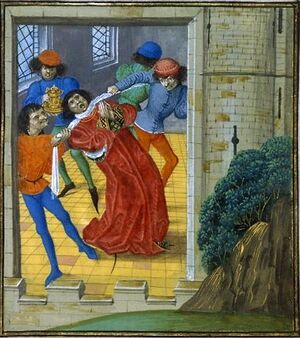
- 1397: On Saturday 22 September Sir Thomas Mortimer was summoned to stand trial as a traitor. Mortimer’s alleged crime was the slaying of Thomas Molineux, constable of Chester Castle, at the skirmish at Radcot Bridge. Unsurprisingly Mortimer chose flight to Scotland. Arundel, Warwick and Gloucester (Thomas of Woodstock - Justice of Chester) also arrested and charged with treason. The Earl of Arundel is executed and his estates in Shropshire and North Wales later become part of principality of Chester. Thomas Walsingham writes of the execution "before and after him in the procession went the wild roughs from Chester, armed with axes, swords, bows amd arrows" . Gloucester (Thomas of Woodstock) is murdered by Nicholas Colfox (Thomas of Woodstock's murder plays a prominent part in the opening scene of William Shakespeare's play Richard II). Warwick was imprisoned. The clerk John Hatton of Chester is appointed "yeoman of the livery of the crown" at 6d a day for life. The citizens of Chester are granted the profits of the murage duties towards the repair of the walls for five years by Richard II.
- 1398: Chester is erected into a principality by King Richard who styles himself "Prince of Chester". In the process the Maelor Saesneg was merged with the County Palatine of Chester to form the Principality of Chester. Richard was a regular visitor over the next year, granting various charters. 4000 marks are deposited at St Werburgh's for the benefit of the Cheshire men who fought for Richard II at Radcot Bridge. William le Scrope, 1st Earl of Wiltshire, made justice of Chester.
- 1399: Richard II has a heated bathroom constructed in Chester Castle (costing £70). It was panelled with Norwegian timber. His apartments were redecorated with cushions and fine silk hangings. While Richard II is away on a military campaign in Ireland, Henry Bollingbroke, later Henry IV, lands in Britain after exile and takes Chester without a fight. He stays at Chester for a few days and then captures Richard II who is briefly imprisoned at Chester Castle. Richard's treasure is reputedly hidden somewhere near Chester (often cited as down the well at Beeston Castle - England’s deepest medieval well), although this could be a confusion with the Cuerdale Hoard, or possibly with the Royal Treasure kept at Holt.
Chester and the Wars of the Roses (1399-1485)
The Houses of York and Lancaster, both branches of the House of Plantagenet, were two of the factions involved in the Wars of the Roses, an intermittent civil war during the 15th century. Both claimed descent from Edward III. Owing largely to the number of sons produced by Edward III, too many leading subjects had a claim to the throne or aspired to be the power behind it.
John of Gaunt, Duke of Lancaster (March 6, 1340 – February 3, 1399) was the third surviving son of King Edward III of England and Philippa of Hainault. John of Gaunt's legitimate male heirs, the Lancasters, included Kings Henry IV (Henry Bolingbroke), Henry V, and Henry VI. John of Gaunt's illegitimate descendants, the Beauforts, ultimately became legitimate by his marriage to Katherine Swynford in 1396, and later married into the House of Tudor. The House of York was descended from Edmund of Langley, 1st Duke of York, the fourth son of Edward III.
When Richard II was forced to abdicate the throne in 1399, Henry was next in line to the throne according to Edward III's entailment of 1376; but the heir of the royal estate according to the common law was Edmund Mortimer, 5th Earl of March, who descended from the daughter of Edward III's second son, Lionel of Antwerp. Bolingbroke's father, John of Gaunt, was Edward's third son. The problem was solved by emphasising Henry's descent in a direct male line, whereas March's descent was through his grandmother. The official account of events claims that Richard voluntarily agreed to resign his crown to Henry on 29 September. The country had rallied behind Henry and supported his claim in parliament. However, the question of the succession never went away. The problem lay in the fact that Henry was only the most prominent male heir, not the most senior in terms of agnatic descent from Edward III.
The Stanley family became powerful during this period. John Stanley led an expedition to Ireland on behalf of de Vere and King Richard II to quell rebellion. In 1389, Richard II appointed him justiciar of Ireland, a post he held until 1391. He was heavily involved in Richard's first expedition to Ireland in 1394–1395. However, on his return to England, Stanley, who had long proved adept at political manoeuvrings, turned his back on Richard and submitted to Henry IV of England. Stanley's fortunes were equally good under the Lancastrians. He was granted lordships in the Welsh marches, and served a term as lieutenant of Ireland. In 1403 he was made steward of the household of Henry, prince of Wales, (later Henry V). Unlike many of the Cheshire gentry, he took the side of the king in the rebellion of the Percys. He was wounded in the throat at the Battle of Shrewsbury. In 1405 he was granted the tenure of the Isle of Man by which had been confiscated from the rebellious Henry Percy, 1st Earl of Northumberland. In this period he also became steward of the king's household, and was elected a Knight of the Garter. In 1413 King Henry V of England sent him to serve once more as lieutenant of Ireland.
Although relations with the crown cooled and (not least from the election of a Welsh mayor) there seems to have been much sympathy with Wales in Chester. Prior to his return, the Stanleys had been communicating with the exiled Henry Tudor for some time and Tudor's strategy of landing in Wales and heading east into central England depended on the acquiescence of Sir William Stanley, as Chamberlain of Chester and north Wales, and by extension on that of Lord Thomas Stanley, 1st Earl of Derby himself. On hearing of the invasion, Richard III ordered the two Stanleys to raise the men of the region in readiness to oppose the invader. However, once it was clear that Tudor was marching unopposed through Wales, Richard ordered Lord Stanley to join him without delay. According to the Crowland Chronicle, although Lord Stanley excused himself on the grounds of illness, the 'sweating sickness', by now Richard had firm evidence of the Stanleys’ complicity. After an unsuccessful bid to escape from court, Lord Strange had confessed that he and his uncle, Sir William Stanley, had conspired with Henry Tudor. Richard proclaimed him as traitor, and let it be known that Strange’s life was hostage for his father's loyalty in the coming conflict. Indeed, Richard allegedly issued orders for Strange’s execution on the battlefield at Bosworth Field, although in the event these were never carried out.
Medieval Chester housed no industry of national importance and, as a west-facing port, was unable to participate in Continental trade to any significant extent. The city's economy was broadly based but its activities were small in scale and none dominated. Although Chester did not share the spectacular success enjoyed by towns more closely associated with the wool and cloth trades, it was spared the consequences of the dramatic slumps in those industries. Even so, for much of the period the city was far from prosperous, and occasionally, as in the 1450s, in considerable decay. The period was marked by much feuding between city factions.
Henry IV (30 September 1399 - 20 March 1413) LANCASTRIAN. Descended from Edward III - was never Earl of Chester.
Henry Bolingbroke began a military campaign, confiscating land from those who opposed him and ordering his soldiers to destroy much of Cheshire for its support of Richard II (it appears that Cheshire was the only county who wanted Richard II back). Henry quickly gained enough power and support to have himself declared King Henry IV, to imprison King Richard, who died in prison under mysterious circumstances, and to bypass Richard's seven-year-old heir-presumptive, Edmund de Mortimer. Henry spent much of his reign defending himself against plots, rebellions, and assassination attempts, some of which he imagined. However in the early days of his reign he had to deal with a series of revolts in Cheshire which has been a particularly favored county of the deposed Richard II
- 1399: Chester is reduced from a principality to an earldom. The first mention of "The Bell" inn - now a restaurant. Peter Legh, seemingly the chief among those left behind to protect Richard's interests is executed and his head placed on the Eastgate.
- 1400: revolt in Cheshire, seemingly linked with the Epiphany Rising, possibly through the conspiracy of John and Adam Hesketh two "men of Cheshire". On the 4th of January they left for Cheshire to meet with four of the seven captains of the Cheshire Guard: John Legh, John Donne, Thomas Beston, Thomas Holford. Chester Castle besieged. An armed group of men, dressed in the livery of Richard II made their way to the Eastgate and removed the head of Peter Legh and then issued a proclamation in Richard's name that all men of the city should rally to his cause. Sir William Venables, constable of the castle, resisted the assault. The castle was garrisoned by 8 men-at-arms and 35 archers. The mayor of Chester was ordered to "apprehend and imprison John and Adam Hesketh for they had broken into the Castle and stolen the keys to the Eastgate, beheaded Thomas Molyneux and proclaimed against the King." (Thomas Molyneux had died in 1387) Richard II is believed to have been killed by starvation, or otherwise murdered. A general pardon is issued to the people of Cheshire (except for 125 people), but property is confiscated from several Cestrians including their leader Thomas Cottingham. The mayor and sheriffs were required to supply provisions protected by an armed guard for an expedition planned by the king and prince, and the portmote was suspended while they fulfilled their commitments. On 16 September 1400, Owain Glyndŵr instigated the Welsh Revolt against the rule of Henry IV. The uprising was initially very successful and rapidly gained control of large areas of Wales, but it suffered from key weaknesses – particularly a lack of artillery, which made capturing defended fortresses difficult, and of ships, which made their coastlands vulnerable. Sir Henry Percy ('Hotspur') made justice of Chester.
- 1401: Henry, prince of Wales, confirmed the charters of Chester. The exchequer is moved to a building adjoining the Shire Hall, just outside Inner Bailey of Chester Castle.
- 1402: Chester evidently agreed to provide and man a barge and three small ships in the king's service, and later it was required to furnish all the richer citizens with equipment necessary for its defense. A revival of the Dee Mills Court was attempted, perhaps because of the presence in Chester of Henry, prince of Wales (later Henry IV), and his council;
- 1403: Sir Henry Percy ('Hotspur'), lately justice of Chester, stayed in the city and raised the standard of revolt there, where former kings men and veterans of the Cheshire Guard, the household guard of the the deceased & dethroned ‘Good King Richard’, King Richard II, still resided by the hundreds.. Percy formed an alliance with the Welsh rebel, Owain Glyndŵr. Before they could join forces, Hotspur was defeated and killed at the Battle of Shrewsbury as he raised his visor to get some air (he was wearing full plate) and was hit in the mouth with an arrow. The single most intriguing event taking place before the Battle of Shrewsbury was the defection from the royal army(and therefor from the Kings' Peace) of Hotspur’s uncle the Earl of Worcester just days before the battle was fought. The impact militarily on paper at least was significant, the Earl of Worcester bringing 1,000 men, mostly archers and lightly armed men of foot, over to Hotspurs rebel army. After Percy's defeat one of the quarters of his body was sent to Chester, together with the heads of Sir Richard Venables and Sir Richard Vernon. Chester was not wholly on the side of the rebels as the mayor and the constable of the castle were present at Shrewsbury in the king's retinue. The future (then sixteen-year-old) Henry V (Prince Hal) was also struck by an arrow which became stuck in his face "to a depth of six inches". Over a period of several days John Bradmore, the royal physician, treated the wound with honey to act as an antiseptic, crafted a special tool to screw into the broken arrow shaft and extract the arrow. The operation was successful, but it left Henry with permanent scars and explains why the one remaining contemporary portrait (see below) shows only the left side of his face. Legislation of 1403, vigorously supported by the mayor of Chester, denied any arms to the Welsh - except a knife to eat with. It is from this time that the Shoot the Welsh story comes from In the weeks following the Battle of Shrewsbury the insecurity of both the new dynasty and some of the city authorities (i.e. those who had been on the King's side at the battle) was demonstrated in the instructions issued by Prince Henry in response to further defections in north Wales. On September 4, 1403, he wrote to the Mayor, Sheriffs and Aldermen of the City of Chester, who were required to impose a curfew upon all Welshmen visiting Chester, and to ensure that they left their arms at the city gates and did not gather in groups of more than three; all Welsh residents were expelled and any who stayed overnight were threatened with execution. Apparently, the actual wording was that: "all manner of Welsh persons or Welsh sympathies should be expelled from the city; that no Welshman should enter the city before sunrise or tarry in it after sunset, under pain of decapitation.". William de Venables, constable of Chester, with the steward and others of the prince's household took the field with the armed forces of Cheshire to resist an imminent invasion by Owain Glyndŵr. Gilbert Talbot (c.1383–1419), 5th Baron Talbot, made Justice of Chester.
- 1404: Chester Castle was garrisoned by 8 archers. The government still found it necessary to order the citizens of Chester not to sell arms or merchandise to the rebels and to commission keepers of roads out of Chester. A large group of rebels broke into the fulling mills at Handbridge and stole white woollen cloth, an ox and three cows belonging to William Venables. Many of the Cheshire gentry families have a connection with the Venables of Kinderton and they were the ancestors of many of the branches of the Legh and Leigh families through John Venables son of William de Venables and Agnes de Legh, who changed his name to Legh. This family came over from Normandy and are first recorded in England in 1086. Gilbert de Venables was one of the eight barons appointed by the Earl of Chester.
- 1405: A pardon was granted to the citizens of Chester for aiding the Percy rebellion.
- 1407: The city's butchers, fishmongers, and poulterers were indicted for trading offences 'both in the market and without', and the smiths, cutlers, goldsmiths, skinners, barbers, coopers, and slaters for trading without paying toll and custom to the earl and for paying excessive wages contrary to the Statute of Labourers. A Chester butcher was arrested "on suspicion of having bought herrings from the French" (who were allies of the Welsh).
- 1408: Chester elects a welsh mayor - A serious feud then breaks out between on one side the civic authorities, led by the Welshman John Ewloe, and on the other William Venables, constable of the castle. Venables and over fifty members of his retinue were bound to keep peace with the mayor and sheriffs,
- 1419: Venables and Ewloe suspended from office. The Crown nominates a governor Sir William Brereton, sheriff of Cheshire, to replace mayor Ewloe as 'keeper and governor' of the city. Brereton and his deputy presided over the portmote and crownmote until Ewloe was re-elected later in 1409
- 1410: Another election was disrupted by the armed intervention of Robert Chamberlain, a former sheriff and a crony of Venables's. He was unsuccessful, the new mayor Roger Potter, was one of the leading opponents of the former constable
- 1411: A 'day of reconciliation' (dies amoris) was celebrated between Venables and the leading townsmen
- 1412: Under terms awarded by arbitrators, Venables pays reparations to various citizens. The city remained riven by feud - a further attempt at armed interference in the elections of 1412 caused the Crown to commission the current mayor and to appoint Crown nominees to choose the next mayor. Nothing certain is known of Owain Glyndŵr after 1412. Despite enormous rewards being offered, he was never captured nor betrayed. He ignored royal pardons. Tradition has it that he died and was buried possibly in the church of Saints Mael and Sulien at Corwen close to his home
- 1413: Henry IV dies after suffering acute attacks of some grave illness which might have been leprosy; perhaps psoriasis; perhaps a symptom of syphilis; or some other disease.
Henry V (21 March 1413 - 31 August 1422) LANCASTRIAN. Son of Henry of Bolingbroke, later Henry IV. Last Earl of Chester until, Richard of York, then Edward (later Edward V)
Famous for his military exploits, by the time Henry died, he had not only consolidated power as the King of England but had also effectively accomplished what generations of his ancestors had failed to achieve through decades of war: unification of the crowns of England and France in a single person. He was a member of the Order of the Dragon.
- 1415: John de Chester and Lyell de Chester fight at Agincourt as part of the retinue of Sir John Grey. Also present were "Archers of the erle Chester, that was of the Retenu oi our Soveraigne Lord the King CIIIJ".
- 1416: Former Welsh mayor Ewloe, his son Edmund, and their Welsh retainers attack another citizen in Eastgate Street. Shortly afterwards Edmund and his fellow Welshmen break into the house of John Hope (lately sheriff and soon to be mayor). Further disturbances in the same year include an attack on two citizens with the connivance of the mayor, William Hawarden, who was briefly imprisoned in Chester Castle. Many leading citizens, including William Venables and two former mayors, are required to give guarantees to keep the peace.
- 1421: No one, except the officers of the Earl of Chester, allowed to wear arms or carry staves in the city, and Welshmen resorting to Chester on business, to report themselves to the Sheriffs.
- 1422: Henry V died suddenly on 31 August 1422 at Bois de Vincennes near Paris, apparently from dysentery which he contracted during the siege of Meaux. He never was crowned king of France.
Henry VI (31 August 1422 - 4 March 1461) LANCASTRIAN. Son of Henry V.
Henry was the only child and heir of King Henry V of England and therefore great things were expected of him from birth. A revival of French fortunes, beginning with the military victories of Joan of Arc, led to the repudiation of Henry's title to rule France, and the crowning of the French Dauphin. Diplomatic errors as well as military failures resulted in the loss of most of the English territories in France. In later life he suffered from periods of insanity, and by 1461, Henry was suffering such a bout of madness that he was apparently laughing and singing while the Second Battle of St Albans raged. Henry's one lasting achievement was his fostering of education; he founded both Eton College and King's College, Cambridge.
- 1422: On the accession of Henry VI., the Mayor, Sheriffs, and many citizens, attacked the King's Deputy -Chamberlain, and “robbed the Exchequer.” Henry VI spent an average of £25 a year on the maintenance of Chester Castle, under the control of a master mason and master carpenter.
- 1423: Henry VI apparently visits Chester and grants a few charters confirming the appointment of his chaplain at Chester Castle and his Exchequer.
- 1424: In June 1424 the men who took part in the Corpus Christi Day riot were said to have attacked the king's ministers (those of Henry VI) at Castle Lane End: "iuxta le stouneplace que quondam fuit Petri de Thornton chivalier" (now the Old Kings Head - see: Randle Holme)
- 1431: a "great frost lasting nine weeks" settles on Chester.
- 1433: the Mayor and Sheriffs of Chester were ordered to find and punish all ‘foreigners’ who used the trade of skinner and shoemaker within the liberties of Chester.
- 1434: A commission issued by the King to the Chamberlain of Chester to suppress encounters between partizans, arising out of an abuse of “liveries and maintenance."
- 1435: King Henry VI, a boy of 14, informed Pope Eugenius IV that he agreed to the election of John Saughall as Abbot of Chester. Severe famine in Chester - "the people made bread of peas, feathers and fern roots" - bitter vetch (V. ervilia) was one of the first domesticated crops "vetches" is being here confused with "fletches" (arrow feathers)
- 1441: The jailors of Chester Castle and Northgate, "Rockley and Rooley" fought together on the Roodee.
- 1442: Chester Castle chosen for the imprisonment of Eleanor Cobham, whose husband, Henry VI's uncle Humphrey, duke of Gloucester, had been justice of Chester 1427-40. "It is said that one Robert Needham, a Chester gentleman, supposed to be concerned with the Duke of Glocester in her deliverance, was with others hung at Tyburn, taken down alive and pardoned after having been stripped by Executioner to be quartered." - Hanshall
- 1445: King visits Chester and reduces an annual tax from £100 to £50, on the grounds that trade had suffered from the silting of the port and that 'restrictions and charges' had been imposed by the Welsh rebellion. "From an Inquisition taken in the 28th year of Henry VI, the City of Chester is there described as being so decayed and depopulated, by reason of the choaking its harbour, by sands, and the consequences of Glyndwr's Rebellion in Wales, that the Citizens were unable to pay their rent to the Crown." - (Hanshall). Cestrians claim that the "greater part of the city lay in ruins" and that "for forty years now the great flow of warer at the said port ... is taken away from the said harbour by the wreck of the sea sand so that the said harbour is wholly destroyed ... no merchant ship can approach within twelve miles of the said city".
- 1449: a 'Royal Brief' assessed the City of Chester and proposed the construction of a quay at Neston for the transfer of cargoes into smaller vessels.
- 1450: Sir Thomas Stanley (Justice of Chester) called upon to supply troops to support the Lancastrians. Cheshire salt was not exported via Chester after 1450 and had been replaced by salt from the bay of Bourgneuf carried in Breton and Gascon ships. John Salghall, Abbot of Chester, excommunicated, but afterwards absolved.
- 1453: the king had a mental breakdown (and became completely unaware of everything that was going on around him) and Richard, Duke of York, was made protector. "In 1453 the city was gratified with the presence of Margaret of Anjou the Queen of Henry VI. She came upon progresse with manye greate lordes and ladyes with her and was graciously received by the Mayor and Citizens" (Hanshall)
- 1454: Edward of Westminster created Earl of Chester.
- 1455: there is some evidence that Queen Margret visits Chester to gather support for the Royalist cause. Thomas Stanley mobilizes a large force from Cheshire to help the Lancastrian cause, but arrives late for the Battle of St Albans (22nd May). Richard, Duke of York and his ally, Richard Neville, Earl of Warwick, defeat the Lancastrians under Edmund, Duke of Somerset, who was killed. With Henry VI captured, the parliament appointed Richard, Duke of York, Lord Protector.
- 1456: comet Halley revisits. Riots in Chester: "The commonalty of the city arose but were suppressed and committed to the Northgate and afterwards to the castle". Thomas Stanley becomes first Lord Stanley.
- 1459: Thomas Stanley turns up late for the Battle of Blore Heath (which the Yorkists claimed to win). Afterwards two of the Yorkist leaders, the Earl of Salisbury's sons Thomas and John Neville, were imprisoned in Chester castle (they were released the following year when the Yorkists won at Northampton). To discourage prostitution in Chester, an order of assembly was made that "no person in the four principal streets of the city should willingly receive into their houses chambers or cellars nor let the same to any woman that openly misuseth herself with any wedded man or any other man"
- 1460: King Henry was captured by the supporters of the Duke of York at the Battle of Northampton and taken to London. The Duke of York was dissuaded from claiming the throne immediately but he induced Parliament to pass the Act of Accord, by which Henry was allowed to reign but Edward was disinherited, as York or his heirs would become king on Henry's death. Queen Margaret and Edward had meanwhile fled through Cheshire. By Margaret's later account, she induced outlaws and pillagers to aid her by pledging them to recognise the seven-year-old Edward as rightful heir to the crown. Richard of York becomes Earl of Chester despite the fact that Edward of Westminster is still alive: "Also it was ordeyned by the sayde parlement, that the sayde Rychard duk of York shold be called Prince of Wales, duke of Cornewayle, and erle of Chestre; and [he] was made also by the sayde parlement protectoure of Englond.". Shortly thereafter he is killed at the Battle of Wakefield.
Edward IV (March 4, 1461 – 31 October, 1470) YORKIST. Descended from Edward III.
An extremely capable and daring military commander, Edward destroyed the House of Lancaster in a series of spectacular military victories; he was never defeated on the field of battle. Despite his occasional (if serious) political setbacks - usually at the hands of his great Machiavellian rival, Louis XI - Edward was a popular and very able king. Whilst he lacked foresight and was at times cursed by bad judgement, he possessed an uncanny understanding of his most useful subjects, and the vast majority of those who served him remained unwaveringly loyal until his death.
- 1461: Edward IV further reduced taxes on Chester, but his anxieties about the city were reflected in a proclamation requiring the mayor and sheriffs of Chester to arrest all within the shire who supported the king's Lancastrian enemies. These may have included Lewis Glyn Cothi, who had a command of foot in the army of the Lancastrian Jasper Earl of Pembroke at the battle of Mortimer's Cross. After the battle Lewis Glyn Cothi had found his way to Chester, where he married a widow and opened a shop. The mayor seized all his goods for "marrying without permission" and drove him out of town. Lewis Glyn Cothi cursed the inhabitants of Chester and satirised them mercilessly in an awdl, describing them as the offspring of "eight kinds of intercourse in the bushes" ("cyw wythryw cyfathrach — dan lwyn") and calling the vengeance of a pro-Lancastrian Welsh noble, Rheinallt ap Gruffydd ap Bleddyn of Mold, on their heads - with dire results
- 1463: slaughter of Chester citizens at Mold: "This year happened a bloody fray between Reginald ap Griffith ap Bleddyn ancestor of the Wynnes of Tower at the head of a great number of the Welsh and many citizens of Chester There was a dreadful slaughter on both sides and Reginald having taken prisoner Robert Brynn who had been Mayor of Chester three years before carried him away to his fortress near Mold and there hanged him in the large ground room within the tower" (Cowper).
- 1664: Trouble at Newcastle on Tyne was put down with the help of the "great bombard" of Chester (a mighty cannon). All of the gunpowder at Chester Castle was used up in the siege of Skipton Castle.
- 1468: the central tower of St Johns Church collapsed. Sir William Stanley rides out from Chester to Denbigh to resist Jasper Tudor (Lancastrian) who was preparing to land in Wales.
- 1470: Edward IV was forced to flee when he learned that Warwick's brother, John Neville, 1st Marquess of Montagu, had also switched to the Lancastrian side, making Edward's military position untenable.
Henry VI - again (31 October 1470 - 11 April 1471) LANCASTRIAN
The "Readeption" of Henry VI took place on 3 October 1470. However, by this point Henry was too mentally feeble to rule unaided; for example, he had to be led by the hand when he paraded through London. One historian has described him as a "useful political vegetable".
- 1470: Henry VI visits Chester. The goods of a Chester labourer at this time consisted of "two sheets (one canvas, one flax), two saucers, four plates and a dish as well as cloth to hang over the window".
- 1471: Edward of Westminster (Earl of Chester) slain at the Battle of Tewkesbury. Henry VI was imprisoned in the Tower of London, where he was murdered in the Wakefield Tower on 21 May 1471. Some of the reproduction tiles in the tower were manufactured by Willie Carter of Farndon, near Chester. Each year on the anniversary of Henry VI's death, the Provosts of Eton and King's College, Cambridge lay white lilies and roses, the floral emblems of those colleges, on the spot in the Wakefield Tower at the Tower of London where the imprisoned Henry VI was, according to tradition, murdered by the later Richard III as he knelt at prayer.
Edward IV - again (April 11, 1471 – April 9, 1483) YORKIST
Edward did not face any further rebellions after his restoration, as the Lancastrian line had virtually been extinguished, and the only rival left was Henry Tudor, who was living in exile.
- 1471: On 17 July the later Edward V received formal grants, which were afterwards confirmed by parliament, of the principality of Wales, the counties palatine of Chester and Flint, and the duchy of Cornwall (Rolls of Parl. vi. 9-16).
- 1472: Edward again reduced taxes in Chester. Richard Oldham, Abbot of Chester, promoted to the Bishopric of the Isle of Man .
- 1474: Edward (later Edward V), Prince of Wales (being only 5), was conveyed to Chester Castle at Christmas with much pomp.
- 1479: Richard Grey appointed constable of Chester castle. Richard Grey was the younger son of Sir John Grey of Groby and Elizabeth Woodville, later Queen Consort of King Edward IV. Abbot Oldham bound in £1000 to keep the peace towards the Mayor, John Southworth, who that year held office for the sixth time.
- 1483: Edward IV dies. Just which of Edward's many ailments actually caused his death has never been satisfactorily resolved. He probably died of pneumonia, though it has been conjectured that he had contracted typhoid or may even have been poisoned.
Edward V (18 April 1483 - 25 June 1483) YORKIST. Son of Edward IV. Earl of Chester (followed by Edward of Middleham).
Edward V (4 November 1470 – 1483?) was the King of England from 9 April 1483 until his deposition two months later. His reign was dominated by the influence of his uncle Richard, Duke of Gloucester, who succeeded him as Richard III. Along with his younger brother Richard of Shrewsbury, Edward was one of the Princes in the Tower, who were never seen alive after being sent (ostensibly for their own safety) to the Tower of London. Richard III has been widely blamed for their deaths, though it is not certain that he was responsible for them. The brother survives in "Blackadder", becoming Richard IV. Along with Edward VIII and Lady Jane Grey, Edward V is one of four post-1066 English monarchs never to have been crowned (the others were: Edward VIII, Empress Matilda and Lady Jane Grey). Prince Louis of France came close to being a fifth.
The counter-factual history presented in "Blackadder" is unfortunately impossible. Richard of Shrewsbury was born 17th August 1473, and would have been just twelve on 22 August 1485, when his younger son (the "original" Blackadder dates given as (1461–1498)) supposedly kills Richard III at Bosworth.
Richard III (20 June 1483–22 Aug 1485) YORKIST. Edward V's uncle.
Much that was previously considered 'fact' about Richard III has been rejected by modern historians. For example, Richard was represented by Tudor writers as being physically deformed, which was regarded as evidence of an evil character. However, the withered arm, limp and crooked back of legend are nowadays believed to be exaggerations, possibly originating from the questionable history attributed to Thomas More, which made a deep impression upon William Shakespeare, and was long taken as the authoritative history of events. The accusations against his moral character have proven more resistant to refutation than the slanders against his physical looks. On 24 August 2012, the University of Leicester and Leicester City Council, in association with the Richard III Society, announced that they had joined forces to begin a search for the remains of King Richard. Subsequently a skeleton was found. On 12 September 2012 it was announced that the skeleton might be that of Richard III. Several reasons were given: the body was of an adult male; it was buried beneath the choir of the church; and there was severe scoliosis of the spine, possibly making one shoulder higher than the other (to what extent would depend on the severity of the condition). DNA analysis confirmed that this was Richard.
- 1483: Edward of Middleham created Earl of Chester in a splendid ceremony on 24 August
- 1484: Edward of Middleham Earl of Chester, dies (the next Earl would be Arthur Tudor). Richard III possibly visits Chester. The citizens claimed that Chester had no merchant ship of its own and that the port was "wholly destroyed because no merchant ship had been able to approach within 12 miles for 60 years" (within two years 60 years would become 200). Richard III again cuts an annual tax on Chester from £50 to £30.
- 1485: the citizens' sympathies seem to have been with the Tudors. Their mayor from 1484 to 1486, Sir John Savage (d. 1495), had close links with the Stanleys, and his son, also Sir John (d. 1492), led the left wing of Henry Tudor's forces at the Battle of Bosworth Field and was afterwards well rewarded (see this site for more information). The serjeant of the Bridgegate, Sir William Troutbeck, also fought for Henry at that battle. Richard III was abandoned by Lord Thomas Stanley, 1st Earl of Derby, Sir William Stanley, and Henry Percy, 4th Earl of Northumberland. Tradition holds that Richard III's final words were "treason ,treason, treason, treason, treason"
sources and links
- Richard III Society packed with information and a great source for links;
- Interesting article on Richard III's diet;
- Bosworth Counterfactual - how things might have been different...
Chester and the Tudors & Stewarts (1485-1625)
The House of Tudor (Welsh: Tudur) produced a series of six monarchs of Welsh origin who ruled England and Ireland from 1485 until 1603. While the Tudor claim to the throne was tenuous, being based upon a lineage of illegitimate succession , the death of Richard III on Bosworth Field effectively ended the long-running Wars of the Roses, which ensured that most other claimants were either dead or too weak to challenge Henry VII. The Stewarts first became monarchs of the Kingdom of Scotland during the late 14th century, and after 1603 James VI & I became the senior genealogical claimant to The Crown holdings of the then extinct House of Tudor.
Chester's economy grew steadily from 1550 to c. 1600, not least because in the early 1580s and later 1590s the passage of troops bound for Ireland created more demand for goods and services. Recovery from the plagues of 1603-5 was hampered by national economic difficulties and by recurrent, though limited, local epidemics, but from the mid 1620s prosperity returned. Throughout the 16th century Chester was the largest port in north-west England, although it carried only a small proportion of the country's trade, ranking 12th in a list of 18 provincial ports in 1594-5. However Chester's ships were small and the port was unfavourably located for trading with England's main markets overseas (except Ireland). Silting of the Dee continued and the port continued it's long decline.
Henry VII (August 22, 1485 - April 21, 1509). Somewhat distantly descended from Edward III.
Henry VII was a fiscally prudent monarch who restored the fortunes of an effectively bankrupt exchequer (Edward IV's treasury had been emptied by his wife's Woodville relations after his death and before the accession of Richard III) by introducing ruthlessly efficient mechanisms of taxation. In this he was supported by his chancellor, Archbishop John Morton, whose "Morton's Fork" was a catch 22 method of ensuring that nobles paid increased taxes. After the treaty of Medina del Campo opened up trade with the Iberian peninsula in 1489, Spanish iron, and wine from Portugal, Spain, and Gascony became the basis for a dramatic expansion in Chester's overseas trade, which allowed other Mediterranean commodities to reach the city, and provided new markets for hides and cloth. Chester's trade with Spain focused on the Basque region and involved iron. Besides iron, small quantities of angora, silk and velvet, liquorice, train oil, woad, and Cordovan skins were sometimes carried. Trade with Portugal and Andalusia through the northern Spanish ports brought cork, dyestuffs, figs and raisins, litmus, pepper and herbs, oil, sugar, wax, and sweet wines to Chester from c. 1509.
Henry's bed (worth up to £20m) was discovered in Chester in 2010. It was dumped in a Chester hotel car park by builders converting the Redland House Hotel in Hough Green for collection by auctioneers. Collector Ian Coulson, of Northamptonshire, bought the "paradise state bed" at auction for £2,200 after spotting it online. Experts now believe it may be worth millions.
- 1485; King Henry VII and Elizabeth of York are married, uniting the House of Lancaster and the House of York after the Wars of the Roses.
- 1486; Henry VII reduced the annual farm to £20 in perpetuity. The king visited Chester with his queen and his mother in 1493 or 1495, and in 1498 or 1499 his son Prince Arthur attended a performance of an Assumption Day play and presented a silver badge to the Smiths, Cutlers, and Plumbers' company. The citizens of Chester claimed that the city was "thoroughly ruined .. nearly one quarter destroyed because access for shipping had been impossible for 200 years" (see 1484)
- 1491; "great tempest strikes Chester on St John's day" (Roberts) "A child of Tendon ap Thomas was slain by the fall of a principal from St Peter's church and a child of Ralph Davenport was sore hurt the same day". The "Comet of 1491" comes 873,784 miles (1,406,219 km) away from earth, the closest ever recorded.
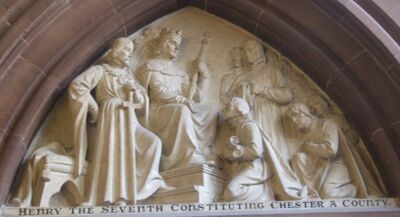
- 1493; "great fire without the Northgate" (Roberts)
- 1495; Sir William Stanley beheaded. Henry VII appointed a new master mason at Chester Castle and again spent c. £25 a year on maintenance.
- 1498; Midsummer Watch Parade first held during the mayoralty of Richard Goodman - organised by the City Guilds.
- 1499; Old Dee Bridge rebuilt in stone. The Smiths Company has a silver badge presented by Arthur, Prince of Wales - and Earl of Chester, when he visited Chester.
- 1500; another "great fire without the Northgate" (Roberts). The end of the Dee Bridge next to Handbridge was rebuilt.
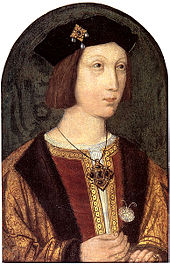
- 1502; Arthur, Earl of Chester marries Catherine of Aragon and shortly afterwards dies. The cause of his death is unknown but may have been consumption, diabetes, or the mysterious sweating sickness (a hantavirus). Some have suggested that he was worn out by the amorous Catherine (she was 17, he was 16).
- 1503; "all innkeepers ordered to hang out lanterns from All Saints until Candlemas" (Roberts). Henry ( afterwards Henry VIII.) created fourteenth Earl of Chester.
- 1506; Henry VII grants Chester its 'Great Charter' (see: Charters), which constituted the city a county in its own right, fully exempt from County control. but maintaining Chester Castle’s independence from the city. The rights, privileges and procedures of the Mayor and Corporation were ratified. The Corporation comprised a Mayor, 24 aldermen and 40 common councilmen. There were 2 sheriffs, 2 coroners and 2 muringers (officials who were responsible for collecting special murage taxes for the repair of the City Wall). The Corporation had the right to hold courts and to control trade, buildings and social conditions. The old Tower of St. Werburgh's Abbey taken down.
- 1507; Chester visited by the sweating sickness a disease which seems to have vanished - 91 householders died within three days (only four of which were women). The foundation stone of the Abbey Tower was laid.
- 1509; Henry VII died of a broken heart following the deaths of his son and heir, Arthur Tudor (Earl of Chester), and his wife, Elizabeth of York (in 1503).
Henry VIII (April 22, 1509–January 28, 1547). Third child of Henry VII (previously Earl of Chester)
In the first parts of his reign he energetically suppressed the Reformation of the Anglican Church, which had been building steam since John Wycliffe of the fourteenth century. He is more often known for his ecclesiastical struggles with Rome, which ultimately led to him separating the Anglican Church from Roman authority, the Dissolution of the Monasteries, and establishing the English monarch as the Supreme Head of the Church of England. Henry also oversaw the legal union of England and Wales. He is noted in popular culture for being married six times.
In the early 16th century Chester's overseas trade with Ireland, Spain, Portugal, and Brittany expanded, but only merchants with a sizeable turnover could carry the heavy costs which arose from carriage from anchorages down the estuary and from high customs duties. The share of the port's trade controlled by Cestrians fluctuated. Dubliners dominated the Irish Sea trade, and there was strong competition for the rest of the overseas trade from English, Welsh, and Continental merchants. In 1538-42, during Chester's trading zenith, 40-45 per cent of traders were Chester freemen. At this time Chester was one of 16 or so towns with 3500-5000 inhabitants. Of the freemen, most were probably only occasionally involved in trade, and between 1500 and 1550 there were forty or so significant Chester merchants who shipped through the port. Their trade was predominantly in importing iron and wine and exporting hides and cloth, but few were specialists. Even though Richard Grimsditch's main trading effort was with the Continent, for example, he also bought Irish cloth, while Henry Gee in 1532 shared a cargo which included canvas, buckram, glass, honey, black soap, velvet, trenchers, a round table, and a bedcase. By the mid-16th century the port was importing large amounts of fur and skins. However, Liverpool was beginning to develop as a port and this would eventually spell doom for trade in Chester.
In the early 1500’s Chester used to host a very bloody and violent game (played on Shrove Tuesday) called “Goteddsday footeball” or “Mob Footeball” with a ball made out of leather. Sometimes this game was played by different towns or different guilds, such as shoemakers and saddlers (not coincidentally men who worked with leather); sometimes feuding families; the game originated at the Roodee (or the Cross) and the object of the game was to get possession of the ball and to take it to the house of the Mayor or the Sherriff. This game had an unlimited number of players on both sides. This game used to become bloody and violent, people being trampled, breaking arms and legs, concussions, endangering lives in the meantime; therefore it was banned by Henry Gee in 1533.
The independent palatinate jurisdiction of Chester survived until the time of King Henry VIII (1536), when the earldom was brought more directly under the control of the Crown.
- 1508-10: St Ursula's Hospital founded following bequest of Roger Smith
- 1510: An order is made that "none shall attend priest's offerings, first mass, gospel ales or Welsh weddings, within this city, under a penalty of ten shillings"
- 1511: £272 was spent on repairs to the Great Hall, gatehouses and Shire Hall of Chester Castle.
- 1512: Piers Dutton becomes mayor of Chester.The Mayor issued an order “for the prevention of idleness". A serious misunderstanding took place between the City and County. The Mayor, Sir Piers Dutton, a county gentleman, was suspected of partiality by the citizens, and they chose John Rathbone in his place by free election.;
- 1513: A body of Cheshire men march north to join the English army against the Scots, many of them die at Flodden
- 1515: Altercation "betwixte the citizens of Chester and divers Waylshe men at Saint Warburghe Lane ende but lytill hurt done, for the Waylesmen fledde". The Shepherd's Play acted in St Johns churchyard;
- 1517: Chester visited again by the "sweating sickness" (a disease which seems to have vanished) - it was said that effects were so marked that "grass grew a foot high at the High Cross".
- 1519: An order made that “none go to Priest's offerings, first mass, gospel ales, or Welsh weddings, within the city, under a penalty of 10s."
- 1522: Chester called upon to supply forces to defend the Scottish borders, and the mayor mustered a force of sixty soldiers to serve with Thomas Howard, earl of Surrey.
- 1523: Inquest held into the death pf Roger Ledsham "keeper of the great gate of the Abbey" after he drowned in the Abbey Square pond, known as the "Horse Pole".
- 1524: Thomas Highfield elected 25th Abbot of St. Werburgh
- 1525: Chester Herald of Arms in Ordinary is an officer of arms at the College of Arms in London. The office of Chester Herald dates from the 14th century, and it is reputed that the holder was herald to Edward, Prince of Wales, the Black Prince. In the reign of King Richard II the officer was attached to the Principality of Chester, which was a perquisite of the then Prince of Wales. In the reign of King Henry VIII the title lapsed for a time but, since 1525, the office of Chester has been one of unbroken succession, as a herald in ordinary. The badge of office is taken from the arms of the Earl of Chester and is blazoned as "A Garb ensigned of the Royal Crown Or" (a wheatsheaf wearing a crown).
- 1527: Henry Gee is sheriff of Chester. Thomas Marshall elected 26th Abbot of St. Werburgh
- 1529: John Birchenshawe elected 27th Abbot of St. Werburgh
- 1531: Comet Halley revisits - widespread panic
- 1532: Chester's Assembly legislated against its own and Dublin citizens shipping through Liverpool and forbade Cestrians to bargain with Irish merchants at Liverpool.
- 1533: Henry Gee, now Mayor, orders that "No manner person or persons go abroade in this citie mumming in any place within the said citie, their fayses being coveryd or disgysed (because) many dysordered persons have used themselves rayther all the day after idellie in vyse and wantoness than given themselves to holy contemplation and prayre the same sacryt holye and prynsepaul feaste" This popular Mayor ordered that ale, beer and wine were not to be sold after 9pm on any day or after Sunday services. Henry gee also banned the local football game, traditionally played at the Cross and started the Chester Races instead. It has been suggested that Henry Gee is the origin of the term "Gee-gee" for horse, but this is not confirmed by the OED.
- 1536: Chester was brought into the national customs system for leather (in 1537-8 customs duties were paid on 10,681 tanned hides in five Spanish and five Chester ships). Chester Castle became a base for the County justices. Chester introduces the death penalty for repeated begging. Sir William Brereton, Chamberlain of Chester, was condemned to death for high treason
- 1537: "water first brought from Boughton to the Bridgegate by pipes" (Roberts) - actually the Romans had done this quite some time before.
- 1538: Three Chester friaries surrendered on 15 August the the King's commissioner Richard Yngworth during the Dissolution of the monasteries. Thomas Clarke elected 28th Abbot of St. Werburgh (the last one)
- 1539: Manchester cottons, friezes, kerseys, broad dozens, and goatskins were carted from Chester to four Spanish ships at anchor in the Dee estuary. An order was made by Henry Gee, Mayor, the Sheriffs, and Corporation, that “ all children be sette to schole all week, and to come to church to hear Divine Service on holy days and Sundays, and afternoone to shute on Roodey, or elsewhere, for pinns or poynts."
- 1540: St Werburgh's Abbey and St Mary's Nunnery surrendered. First races on the Roodee. Women forbidden from running pubs in Chester: "Whereas all the taverns and alehouses of this city be used to be kept by young women otherwise than is used in any other place of this realme whereat all strangers greatly marvel and think it inconvenient whereby great slander and dishonest report of this city hath and doth run abroad in avoiding whereof as also to eschew such great occasions of wantonness brawls frays and other inconveniences as thereby doth and may arise among youth and light disposed persons as also damages to their masters owners of the taverns and alehouses. Ordered that after the 9th of June next there shall be no tavern or alehouse kept in the said city by any woman between fourteen and forty years of age under pain of forty pounds forfeiture for him or her that keepeth any such servant". Mayor Henry Gee first "beats the bounds" of Chester.
- 1541: The former abbey of St. Werburgh, Chester, was reconstituted the Cathedral of Christ and St. Mary in August, with an establishment consisting of a dean and six prebendaries; John Bird appointed the first bishop. The new diocese had both administrative and financial problems: Bird tried to address the finances, and dispensed with archdeacons, but succeeded only in making bad deals with the Crown and with leaseholders. Thomas Clarke, last abbot of St. Werburgh's, became the first dean of Chester (he died a month later). The King's School is founded by Henry VIII. Chester gets its first seat in parliament. An attempt to improve port facilities was under way by 1541, with the construction of a quay at Neston some 10 miles down river from Chester. A committee of four, including three aldermen, was set up to supervise the work, voluntary contributions were gathered in each parish, and a customs levy was dedicated to the project. The "New Haven" was used even though it remained uncompleted. According to Douglas Jones ("The Church in Chester, 1300-1540") the relic of the "Rood of Chester" is removed from St Johns.
- 1542: The King on the petition of the citizens granted Chester parliamentary representation
- 1543: a ship arrives at Chester with "1600 shhep fells, 68 dere, 69 fawne skins and 6300 broke (badger skins)". The city mason was paid two days’ wages “for shiftyinge the cross” at St Mary on the Hill;
- 1545: King's School founded;
- 1547: St Ursula's Hospital dissolved, but continues as Sir Thomas Smith's Almshouses. Henry VIII had become grossly overweight and had to be moved about with the help of mechanical inventions. He was covered with suppurating boils and possibly suffered from gout. He expired soon after uttering these last words: "Monks! Monks! Monks!".
Edward VI (January 28, 1547-July 6, 1553). The son of Henry VIII and Jane Seymour. He had been Earl of Chester and would be followed as Earl by the older brother of Charles I.
During his father's reign Edward had effectively been pampered and kept in seclusion. Edward desperately wanted his own freedom. He became extremely fond of sports such as tennis. During the winter of 1552–53, Edward VI, strained by physical activities in the bitter weather, became ill. While he may have contracted a cold or other respiratory infection, smallpox was epidemic in the region at the time. Doctors administered various medicines (including arsenic), but their efforts were in vain, leaving Edward in perpetual agony. The first symptoms of "tuberculosis" were manifest in January 1553 and by May it was obvious that his condition was fatal
- 1550; Henry Gee, Mayor of Chester, dies of the "Sweating Sickness". His name is remembered with the annual running of the Henry Gee Maiden Stakes (a race for three-year old fillies) in July.
- 1551; "dreadful flood at Saltney - many drowned in their beds" (Roberts) “There arose in the night a mighty great wind and the flood came to such a height that many trees were left by the ebb, on the top of Dee Bridge”.
- 1553; Edward VI died at the age of 15 at Greenwich Palace on 6 July 1553. The definite cause of his death is unknown, but may have been tuberculosis, arsenic poisoning, syphilis (from his father) or rheumatoid arthritis. Edward named the (Protestant) heirs of his father's sister, Mary Tudor as his successors in a will composed on his deathbed.
Jane (July 10, 1553 – July 19, 1553)
Jane Grey was 15 when she became queen and she abdicated nine days later - she was executed in 1554. Edward VI's death was kept secret for several days so that preparations could be made for Jane's accession. High civic authorities privately swore their allegiance to the new Queen, who was not publicly proclaimed until 10 July 1553. However, the people were much more supportive of Mary, the rightful heir under the Act of Succession. On 19 July, Mary rode triumphantly into London, and Jane was forced to give up the Crown. Jane's proclamation was revoked as an act done under coercion; her succession was deemed unlawful. Thus, Edward VI's de jure successor was Mary I (1553–58), but his de facto successor was Jane.
(Bloody) Mary I (19 July 1553–17 November 1558). Only child of Henry VIII and his first wife Catherine of Aragon to survive infancy.
She is remembered for restoring England to Roman Catholicism after succeeding her short-lived brother, Edward VI, to the English throne. In the process, she had almost three hundred religious dissenters (more than one a week) burned at the stake in the "Marian Persecutions", resulting in her being called Bloody Mary.
- 1554: John Bird surrendered his bishopric on his marriage. He is succeeded by George Cotes. Chester Merchant Adventurers granted a charter by Queen Mary which gave them a monopoly of all trade to the continent, besides excluding retailers and all followers of manual occupations.
- 1555: 24 Apr - George Marsh burned at the stake at Boughton (on the orders of George Cotes) despite the attempt to rescue him by John Cowper, sherrif of Chester. Cowper goes into hiding in Wales. Cotes dies shortly afterwards (Foxe claims he "died of the pox, caught from a harlot"). Cuthbert Scott becomes Bishop of Chester.
- 1556: repairs effected to the City Walls.
- 1557: collection of money (at the churches of Chester) for the establishment of a "New Haven" at Neston due to silting of the River Dee.
- 1558: Henry Cole, Dean of St. Paul's, is commissioned to persecute "heretics" in Ireland. At the Blue Posts Inn in Bridge Street Chester the hostess stole the commission and replaced it with a pack of cards. The dean sailed immediately afterwards for Ireland, and arrived Dec. 7th, 1558 (by which time Mary was dead). Being introduced to Lord Deputy Fitzwalter and the Privy Council, he explained his business and then presented the commission to the Lord Deputy, who took it, opened it, and beheld the knave of clubs! Mary died at age 42 at St. James's Palace on 17 November 1558 (before Cole can get a new commission).
Elizabeth I (17 November 1558 – 24 March 1603). Daughter of Henry VIII and Anne Boleyn.
Elizabeth was a short-tempered, sometimes indecisive ruler, who enjoyed more than her share of luck. Elizabeth is however acknowledged by historians as a charismatic performer and a dogged survivor, in an age when government was ramshackle and limited and when monarchs in neighbouring countries faced internal problems that jeopardised their thrones. Such was the case with Elizabeth's rival, Mary, Queen of Scots, whom she imprisoned in 1568 and eventually executed in 1587. It was expected that Elizabeth would marry, but despite several petitions from parliament, she never did. The reasons for this choice are unknown, and they have been much debated. As she grew older, Elizabeth became famous for her virginity, and a beauty cult grew up around her which was celebrated in the portraits, pageants and literature of the day (in reality her skin had been scarred by smallpox in 1562, leaving her half bald and dependent on wigs and cosmetics). Towards the end of her reign, a series of economic and military problems weakened her popularity to the point where many of her subjects were relieved at her death. After the short reigns of Elizabeth's brother and sister, her forty-five years on the throne provided valuable stability for the kingdom and helped forge a sense of national identity. Chester's population in 1563 of c. 4,700-5,200 put it in the second rank of provincial towns, half the size of York and a third that of Norwich. Within the North-West, however, it was the largest town for sixty miles around. The city probably reached that population after half a century of growth following the recession of the later Middle Ages
- 1559: Cuthbert Scott (Bishop of Chester) was one of the four Catholic bishops chosen to defend Catholic doctrine at the conference at Westminster, and immediately after this he was sent as a prisoner to the Tower of London and then in the Fleet Prison 1559-1563. Sir Lawrence Smith and William Gerard returned as MPs. The Assembly Book records: "Joinery (beds, cupboards, shelving etc.) not to be exported except by special licence from the Mayor, under penalty of confiscation. The Joiners and Carvers had apparently found a very profitable market in Ireland, with the result that in Chester their work was scarce and expensive."
- 1560: Peter Colman, a freeman, is disenfranchised for allowing a non-freeman to trade in his name.
- 1561: William Downham becomes Bishop of Chester. He was considered rather ineffectual against the Roman Catholics, preferring not to offend the gentry. John Cowper is mayor of Chester.
- 1562: William Gerard and John Yerworth returned as MPs
- 1563, The diocesan returns of 1563 suggest that Chester had 1,041 households, representing 4,685 inhabitants. A privateer "fitted out by the licenced victualers of Chester, brought in a Frence prize" (to Liverpool). The "history of Eneas and Queen Dido" played out on the Roodee - with "two forts made, and shipping in the water, beside horsemen well appointed".
- 1564, "great fire without the Northgate" (Roberts). The Midsummer Watch parade included: "4 gyants, 1 unikorne, 1 dromodarye, 1 luce, 1 camell, 1 dragon, 6 hobbyhorses and 16 naked boys". Severe frost - River Dee frozen and football played on the ice.
- 1565, Chester claims that the port of Liverpool is "but a creek" within the port of Chester and that all Customs dues should be paid through Chester. Edward Brerewood born in Chester.
- 1566, "great fire in Handbridge" (Roberts)
- 1567, Richard Dutton, mayor of Chester "is said to have kepte a very worthy howse for all comers duringe all the tyme of Christmas with a lord of misrule and other pastymes" (Pigot)
- 1568, "Northgate Street, Whitefriars Lane, Parsons Lane and Castle Lane paved" (Roberts)
- 1569: William Massey and Peter Lickerband, the Sheriffs "fought and broke their wands on each other" - both were committed to the Northgate jail and each fined £10 toward the upkeep of the City Walls. The City Treasurer's accounts for 1569 contain an entry which reads: "for making the north-gate bridge new, great joists, thick planks £4/3s/2p".
- 1570: New Haven at Neston came permanently into use. "Elizabeth Plumpton, drowned in a tub of water in backside of house in Watergate Street" (QCI/3/31)
- 1571: The reformer Christopher Goodman (he died in Chester and is buried here) attacked the Bishop of Chester, as "supine", on a pretext of the continuing the Whitsun plays. The plays were enacted with an inhibition from the Bishop "having arrived too late". The chamberlain of Chester, the Earl of Leicester, in the face of opposition from the corporation, obtained the return of his vice-chamberlain, William Glasier, rather than the corporation’s Mr. Snogge or Snagge as an MP for Chester.
- 1572: All of the central tower and part of the north-west tower of St Johns Church collapses. November 11 - Tycho Brahe first observes Supernova SN 1572 in Cassiopeia. Elizabeth I decided to establish a weekly post to Ireland via Chester and Liverpool.
- 1573: The mayor removed the corn market to the Abbey side. The dean and chapter committed the workmen to Chester Castle for three days.
- 1574: More of the north-west tower of St Johns Church collapses. The plague breaks out in Chester and the infected houses are "shut up" with ill and healthy alike trapped inside by boarding up the windows and doors. A conduit is made at the High Cross supplying water. John Dee visits Chester.
- 1575: the Chester Mystery Plays are performed again, over four days. This resulted in the mayor, when he retired from his office, being taken to the Star Chamber in London to answer allegations against him, but with the support of the council (or assembly) he was freed. However the plays were banned. The sheriffs committed to the Northgate jail for refusing levy estreats. A collection made for building a of house of correction under the Northgate. The corn ordered to be held in the Northgate ditch under the walls.
- 1576: Complaints from the citizens regarding heaps of dung deposited by cattle and other creatures which roamed the streets, prompt the city council to order its removal by the beast's owners, on pain of a fine of 3s 3d. The privy council ordered the mayor to discharge a man confined in the Northgate for asserting that Queen Elizabeth had two bastards by the Earl of Leicester.
- 1577: Great Comet of 1577 would have been visible from Chester. The whole company of city butchers are imprisoned for not supplying enough meat: "Memo. of a dispute with the Butchers, on the occasion of their agreeing together not to kill any beef for the market. The entire Company was committed to the Northgate, an indictment of them prepared, and foreign butchers invited to supply the market. They were released, and the indictment stayed, on their speedy submission."
- 1578: soldiers en route for Ireland rioted while overnighting in Chester. The Mayor imprisoned two Captains in the Northgate Gaol and martial law was briefly imposed
- 1579: Chester was the main port used for sending English troops levied in other parts of the country to quell the Second Desmond Rebellion in Ireland. Watergate Street paved. William Chaderton becomes Bishop of Chester. Chaderton was also Warden of Manchester College, where he was succeeded by John Dee.

- 1580: Saturday 25th Feb: total ecplipse of the sun occured: "the like was never seen in the memory of man". Arms and supporters with the motto "ANTIQUI COLANT ANTIQUUM DIERUM" ("Let the ancients honour the Ancient of Days") granted to the city. Eighteen yards of St Peter's spire rebuilt.
- 1581: The choir and chapels of St Johns pulled down. Braun and Hogenberg map of Chester produced. The City Magistrates bought the old Shire Hall at Chester Castle for six Cheshire cheeses, and moved it to the Market Square in Northgate Street where (after a short stint a granary) it became the "flesh shambles" (meat market)
- 1582: Elizabeth Acton, of 'Orton Madock' in Maelor Saesneg confesses (at Chester Cathedral) of having counterfeited religious trances. During a prorogation, the Earl of Leicester unsuccessfully asked that his secretary Arthur Atye be returned as MP in place of the deceased recorder William Gerard.
- 1583: The Sheriff of Chester ordered crosses at the Bars, Northgate and Spital pulled down. This Sheriff died shortly thereafter - prompting comments about "Divine retribution"
- 1584: dreadful hailstorm - many cattle killed by lightning: "The 24th of July being St James's day there was such a storm of thunder, lightning, hail and rain from noon till midnight that the waters did rise of a sudden and overflowed the streets into the cellars so that hogsheads of wine did swim and much wares were hurt besides great harms to the mills much hay and corn destroyed and many glass windows broken with the hail being five inches in compass many men and cattle were slain by the light bolt in divers places so that the like was never heard of in the memory of man.". The Earl of Leicester again tried to have his man elected as an MP for Chester, city records state the response was: "My lord of Leicester’s letter well commending thereby Mr. Peter Warburton for the one citizen, which motion Mr. Mayor and Mr. Aldersey furthered to the uttermost yet was it not available, 46 voices with and 85 contrary."
- 1585: "Upon St Andrew's day the Castle bridge fell down and killed two horses and other cattle going over the same with a load of coals". "Sixteen pirates were committed to the castle and the Northgate for taking a ship out of Wirral and killing one man in the same ship but the wind crossed them brought them back so that they were forced to leave the ship and in flying away they were taken". "A man was hanged drawn and quartered for clipping of money and his quarters were set on the four Gates ". Smith Map of Chester drawn.
- 1586: a (false) rumour that 700 Spanish troops had landed at the New Quay causes great commotion in the city. Peter Warburton returned as the junior MP for Chester.
- 1587: A coiner (forger) "hung drawn and quartered, and his quarters set on the four gates". The Rose Theatre opens in London.
- 1588: William Smith’s plan of Chester from his “The Particuler Description of England. With the portratures of certaine of the cheiffest citties & townes”

- 1589: A woman "burnt at Boughton for poisoning her husband". John Taylor, the keeper of Chester Castle gaol hung for maltreatment of prisoners.
- 1590: 12 gun Privateer Harry Bonoventure sails from Chester with 60 crew: "To be used in warlike manner agaynst the Kinge of Spayne". An order made that none should be made free except he came in armour or other furniture and depose that it was not borrowed.
- 1591: Stanley Palace built. Construction of the abbey gateway started. Chester Bull-ring demolished (before which it was the Town Crier's duty to announce the fight and proclaim: "Oyez, Oyez, If any man stands within 20 yards of the Bullring, let him take what comes".).
- 1593: William Shakespeare possibly visits Chester as a member of the acting troupe Lord Strange's Men under Edward Alleyn. The aldermen compelled to reside in the city. “ A gentleman named Hesketh arrived from Spain with an offer from the King, Dr. Allan, and other fugitives beyond the sea, to Alderman Ferdinando, Earl of Derby, to crown him King of England if he would consent. The Earl sent the messenger before the Queen and Council, and, having been found guilty, he was hanged for treason."
- 1594: An army of 4000 horse and foot passes through Chester to quell the rebellion of Tyrone. The mayor erects a gibbet at the High Cross to deter disorderly conduct by the troops.
- 1595: 1700 troops pass through en route to Ireland. Hugh Bellot becomes Bishop of Chester - he assisted William Morgan in his Welsh language translation of the Bible and was also a reputed misogynist (he died within a year). Ale to be sold three pints for a penny.
- 1597: solar eclipse: "25th of February being Saturday the sun being totally eclipsed it was so dark for the time that the like was never seen in the memory of man". Richard Vaughan becomes Bishop of Chester. The "curiously wrought" spire of the former monastery of the Whitefriars, now belonging to Sir Thomas Egerton, was taken down. The antiquarian William Webb wrote of its removal, "It was a great pitie that the steeple was put away, being a great ornament to the citie. This curious spire steeple might still have stood for grace to the citie had not private benefit, the devourer of antiquitie, pulled it down with the church, and erected a house which since hath been of little use so that the citie lost so good an ornament, that tymes hereafter may talk of it, being the only seamark for direction over the bar of Chester". St Peter's spire (at the High Cross) was also taken down this year, for reasons of safety. The Earl of Essex and other noblemen, on their way to Ireland, halted in the city and were entertained by the Mayor and Corporation.
- 1598: major famine in Chester - the toll on grain is cancelled to try to attract corn into the city. 700 horse and foot ship from Chester for Ireland.
- 1599: Mayor Henry Hardware prohibited the Midsummer Watch Parade and ordered the Giants to be broken up. Bull ring closed. 6000 horse and foot ship from Chester for Ireland. The River Dee froze over, but three young men drowned when they walked onto the ice and fell through.
- 1600: 4000 troops ship from Chester to Ireland. The new waterworks at the Old Dee Bridge was commenced.
- 1601: the Dee Mills "stopped for three months" (this was due to the collapse of the weir). A commission was appointed to visit and reform St John's Hospital. The commissioners found that the master, Richard Young, had not visited the hospital for over three years (he had been imprisoned for debt in Chester Castle) nor could he produce his letters of appointment (it was suspected that he had pawned them). "At Michaelmas fair one Arnet servant to Mr Manly of Saltney-side cruelly murdered one of his fellows near unto his master's house at first by cutting his throat with a knife and afterwards missing his windpipe he ripped up his belly with the same knife so that his bowels fell out and leaving him for dead went home without taking any money from him as he first intended the dying man not-withstanding came home wrapping his bowels together in his shirt and lived until he had made known who killed him. The murderer was hanged in chains the year following near to the place where the deed was done" This year also saw the execution at Boughton of: "A woman named Candey executed for conspiring to murder her husband - her paramour, Boon, refusing to plead, was pressed to death in the castle"
- 1602: The plague once more visits Chester. It is said to have started in a house of a musician named Glover in St John's Lane, where seven people died. On the 22nd August a major auroral display was witnessed over the city. A wider passage through the walls made for the "Newgate" (now the Wolfgate). According to Roberts, Lord Mountjoy with the Earl of Tyrone prisoner passes through Chester and sleeps at the mayors house (seems to have his dates wrong). The first 'watchsmith' is recorded in Chester.
- 1603: In March, Elizabeth fell sick and remained in a "settled and unremovable melancholy". She died on 24 March 1603 at Richmond Palace, between two and three in the morning. Legend has it that she died sitting up because, as she said, "she would lie down for no man". 812 die of plague in Chester - many citizens lived in tents under the New Tower. Tudor House built in Bridge Street. New Gate enlargeed;
James I (24 March 1603 - 27 March 1625). Descendant of Henry VII. Never Earl of Chester.
James faced great difficulties in England, including the Gunpowder Plot in 1605 and repeated conflicts with the English Parliament. According to a tradition originating with historians of the mid-seventeenth-century, James's taste for political absolutism, his financial irresponsibility, and his cultivation of unpopular favourites established the foundation for the English Civil War. Recent historians, however, have revised James's reputation and treated him as a serious and thoughtful monarch. James was a talented scholar, the author of works such as Daemonologie (1597) and Basilikon Doron (1599). Sir Anthony Weldon claimed that James had been termed "the wisest fool in Christendom", an epithet associated with his character ever since.
The widespread and severe epidemic of bubonic plague in 1603-5 was unusual in Chester in falling into two contrasting phases (see: Pandemic). The first was long drawn out but relatively mild: 933 dead out of c. 5,220 inhabitants over 83 weeks represented a death rate of 11 per cent a year, four times the annual rate of the previous decade but not as severe as that experienced elsewhere. The second phase killed 1,041 people in 34 weeks, or 20 per cent a year among a population probably as large as in 1603. The first outbreak was accompanied by 'other diseases' (probably smallpox), and when it was carried from Chester to Nantwich in June 1604 it killed 430 people in 10 months, a mortality of between 23 and 28 per cent. Preventive measures taken in Chester by the Assembly in 1603-5 may have retarded the spread of infection, even though they were conventional and crude: erecting pesthouses on the outskirts to isolate the sick; destruction of infected bedding; orders against overcrowded housing; and a ban on the Michaelmas fair and Christmas watch in 1604 to prevent crowds from gathering.
Despite being the dominant port in north-west England, Chester, or rather its corporation, was not wealthy. Rents from city lands, freemen admissions, and fees for grazing cattle on the Roodee accounted for under £100 p.a.15 Overall income ranged from between £283 in 1607-8 to just £130 in 1616-17.16 Chester’s poverty meant that corporation members were often surcharged to meet extraordinary expenses.
- 1604; county courts held at Tarvin "on account of the plague". Aldersley and Dutton petition the King that the rights of "sanctuary" relating to Chester should be abolished. The Mercers, Ironmongers, Grocers and Apothecaries were incorporated as one company by the Mayor and citizens. The supernova which becomes known as Kepler's Supernova (SN 1604) is first observed from the northern parts of the Italian Peninsula. From October 17, Johannes Kepler begins a year's observation of it from Prague. There was not another "naked-eye" supernova seen until 1987. New bells were cast for the Cathedral.
- 1605; a waterworks housed in a tower is built on the Bridgegate to draw water from the River Dee. In May 1605, after a six-week lull, the plague returned, either from incubating bacilli or a fresh infection (1313 deaths). It struck first not in the suburbs but in the city centre, and so made the civic élite unusually vulnerable. One of the first victims was the previous year's mayor, John Aldersey. Rights of "sanctuary" abolished. George Lloyd (of Bishop Lloyd's House) becomes Bishop of Chester.
- 1606: James I attempted to have Hugh Mainwaring elected as Chester’s recorder. The corporation reminded the king that only the previous year he had confirmed the city’s charter, which gave Chester the right to elect its own recorder. Consequently, James decided "to forbear to press you any further in the suit". One of the prebendaries in the Cathedral put down the mace carried before the mayor which caused much controversy.
- 1607: Comet Halley revisits. The beer brewers paid 13s 6d for taffeta for a banner for the company’s use at Midsummer and 40s to Randle Holme, the heraldic painter, for painting it. A major disturbance (the ‘sword incident’) threatened instability. Thomas Mallory elected Dean. Many more soldiers shipped for Ireland under the command of the Earl of Thomond. Great exertions made to have the Dee causeway removed in order to prevent the overflow of the meadows and that the river being scoured ships might come close to the city.
- 1608: plague breaks out in "The Talbot" an inn on the site of what is now the Grosvenor Hotel. "A great part of the walls between the Watergate and the new Tower were repaired and the Newgate repaired and made larger"
- 1609: "The walls that were repaired the last year fell down this year in the month of November"
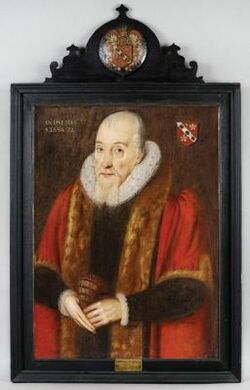
- 1610: John Speed's Map of Chester produced. Performance of "Chester's triumph in honor of her Prince, as it was performed upon St. George's day, 1610, in the foresaid citie"
- 1611: Prince Henry's Charter Case (1 Bulst 133; 80 ER 827) confirmed that while the Sovereign's eldest son is born Duke of Cornwall, he must be made or created Earl of Chester as it had ceased to be a principality. St Michael's church re-roofed.

- 1612: Henry Frederick, Earl of Chester, dies (see: Chamber's Book of days).
- 1613: "The Mayor finding the brazen measure which had been long used in the city to be too little he caused the same to be new cast according to a just measure and all the new bushels were enlarged by the same measure." 500 marks was spent on Chester Castle. Puritan iconoclast John Bruen arranges for ancient stone crosses around Chester to be smashed.
- 1614: The city trained band reviewed on the Roodee by Sir George Booth (for his grandson see: The Booth Rising).
- 1615: William Aldersey has his portrait painted (see Leche House and Merchant Adventurers for more on Aldersey).;
- 1616; Thomas Morton becomes Bishop of Chester. James I visits Chester. King James’s visit cost around £220, of which £130 was spent on the gift of a standing bowl, £40 on a banquet and £50 in assorted presents to members of the royal entourage. The Corporation members were surcharged for these expenses.
- 1617; Elizabeth Wainewright of Hawarden, widow, and Richard Fazakarley, of Broadlane were both accused, "of going to charmers to be blessed", apparently at Chester Castle.
- 1618: Thomas Morton, Bishop of Chester, became Bishop of Lichfield and Coventry. John Bridgeman becomes bishop of Chester
- 1619: there was "a bull baytinge at the high crosse the 2nd daye of October according to Auncient Custome for Mr. Mayor's farewell out of his office". John Bridgeman becomes Bishop of Chester. His son Orlando was a noted Judge, playing an important part in the trial of the Regicides of King Charles I in 1660.
- 1620: An assessment levied for repairing the walls;
- 1623: This year the races were ordered to be from beyond the New Tower round about the Roodee and a fair cup about 8 to be provided yearly by the city;
- 1624: Chester "suffered dreadfully from the plague"; the court of exchequer was removed to Tarvin, the court of assize to Nantwich, and the fairs were suspended. A survey of the Chester Castle was undertaken for the county justices. Bishop John Bridgeman tried to make the pews in the corporation church of St. Oswald’s "more uniform and to re-align the pulpit, which was not conveniently situated". The corporation objected, and the dispute rumbled on until 1638, when Bridgeman caved in. The argument with Bridgeman reflected the emergence of a strong puritan element in the city during the 1620s and 1630s, led by prominent corporation members such as John Ratcliffe, Peter and Robert Ince and the Bruen family, supported by the recorder, Edward Whitby.
- 1625: In early 1625, James I was plagued by severe attacks of arthritis, gout and fainting fits, and in March fell seriously ill with tertian ague and then suffered a stroke. James finally died at Theobalds House on 27 March during a violent attack of dysentery, with Buckingham (his possible lover) at his bedside.
Chester and the Civil War
Chester had major strategic importance during the Civil War. It could readily be garrisoned and defended, was the principal port for Ireland and the gateway to royalist north Wales, had road connexions with north-western and midland counties, and was close to the western route to Scotland.
Charles I (27 March 1625 — 30 January 1649). Second son of James I (previously Earl of Chester)
Charles famously engaged in a struggle for power with the Parliament of England. He was an advocate of the Divine Right of Kings, and many citizens of England feared that he was attempting to gain absolute power. Many of his actions, particularly the levying of taxes without Parliament's consent, caused widespread opposition. His last years were marked by the English Civil War, in which he was opposed by the forces of Parliament, which challenged his attempts to augment his own power, and by Puritans, who were hostile to his religious policies and supposed Catholic sympathies. Charles was defeated in the first Civil War (1642 - 1645), after which Parliament expected him to accept demands for a constitutional monarchy. He instead remained defiant by attempting to forge an alliance with Scotland and escaping to the Isle of Wight. This provoked a second Civil War (1648 - 1649) and a second defeat for Charles, who was subsequently captured, tried, convicted, and executed for high treason.
- 1626: The Falcon (Bridge Street) partially rebuilt
- 1627-28: The Earl’s representatives reluctantly paid for repairs, including a new bridge into Chester Castle.
- 1628: A bitter contest ensued at the parliamentary election on 10 March, with Mainwaring and Smith standing against Whitby and Ratcliffe: "...[there] was great contention about the burgesses of the Parliament… both parties laboured all the city either freemen or householders to give their voices on one part or other. Yea many were laboured four or five times over. So great was the contention the one seeking to over sway the other many were threatened unless they gave their voices to Sir Randle [Mainwaring] and Sir Thomas [Smith] they should lose their houses. The two knights wrought so with all the country gentlemen that had tenants in Chester to give them their voices. Within the Common Hall had like to have been a mutiny but with much ado it was appeased and each man gave his voice particularly so that Mr. Recorder [Whitby] had 631 voices, Mr. Ratcliffe 570, Sir Randle and Sir Thomas had other 300 and odd apiece and far short which vexed them so to see the recorder so well-beloved that they would not subscribe to the commission which went to London. The like labouring was never seen for a city more divided in faction was never seen." (Harl. 2125, f. 59v.)
- 1629: The murage assessment of 1629 named 1,117 "citizens and inhabitants" (that is, householders) by ward. St. John's Lane was omitted, but 78 householders were assessed there in 1630. The poor were exempt from paying the murage, but a survey of 1631 numbered c. 250 pauper households. The total number of households in 1629 was thus 1,445, representing 6,503 inhabitants.
- 1631: Thomas Lacely was "pressed to death" at Chester Castle and buried at the churchyard of St Mary on the Hill
- 1632: Charles I orders the Mayor and Sheriffs of Chester to collect money for the repair of St. Paul's Cathedral in London, "Which is grown into much decay", and was destroyed in the Great Fire of London, 1666. This year is inscribed on the "brank" at Walton-on-Thames and commemorated in the lines: "Chester presents Walton with a bridle, To curb women's tongues that talk too idle." (the original was stolen in 1965). Lord Wentworth passed through Chester and was entertained at the Pentice: he stayed at the Bishop's Palace.
- 1633: a new Custom House was established in Watergate Street, replacing the office formerly at Chester Castle. The aldermen and stewards of the drapers company committed to gaol for unfit speeches against the mayor until they acknowledged their fault.
- 1635: "Ellen Jones, found dead in her brewing pan, "with her heeles upward". Signed by Foulke Salesbury and Hugh Wichstead." QCI/10/10 March 3rd 1635/6
- 1636: Chester Castle was condemned as "old and ruinous". The Assembly minutes record a law imposing a fine of 10s on any householder who had not, within one month from the date of notice, cleared the pathway before his property of accumulated filth
- 1637: Sheriff Wilcock committed to gaol for arresting the goods of Robert Green with drawn swords, at his own suit without previous proceedings at law - Two serjeants-at-mace had their gowns taken off.
- 1639: Newgate repaired. The mayor by order of assembly, bound to find in these perilous times, a corslet and two muskets.
- 1640: with the Scottish army in northeastern England, the Chester Assembly set up a nightly watch, strengthened the defences at the Eastgate, Newgate (todays Wolfgate), and Bridgegate, and ordered members of the corporation and others to supply corselets, muskets, halberds, and calivers within a month.
- 1641: In support of the Irish rising, a supposed Chester conspiracy involved the Catholic Lord Cholmondeley. While Parliament had decreed that all "Papists" be disarmed", those of Cheshire refused the "trained bands" (Militia). On 20 November, the Cholmondeley supporters, after gathering at his mansion in Chester (located in what is now Grosvenor Park), sallied out with the intention of battering down the city walls. As might be expected, this did not come to much and in fact is almost certainly "fake news".
- 1642: 26 Sep - Thomas Aston issues an order at Chester for the seizure of arms and horses from those who had joined Parliament's Militia in Cheshire. Bishop Bridgeman cottages built in the Cathedral Square - they are still there. The Bunbury Agreement of December 23, was drawn up by some prominent gentlemen of the county of Cheshire to keep Cheshire neutral during the English Civil War. Chester Castle was a royalist headquarters during the siege of Chester, with a garrison commanded by a military governor.

- 1643: "The Boot Inn" opens - it is still open. Sir Richard Grosvenor petitioned the Assembly to enclose that part of The Rows which ran through the front of his town house (The Falcon) on Lower Bridge Street. His request was granted. In the years after the Civil War, people further down the street also asked for the Row to be enclosed. Eventually Lower Bridge Street lost it's part of The Rows. The only remnant can now be found at number 11.
- 1644: Lord Byron defeated at the Battle of Nantwich by forces under the command of William Brereton and Thomas Fairfax and forced to withdraw to Chester.
- 1645;
?? Feb - William Brereton's forces attack Chester and fail in their attempt to scale the City Walls near the Northgate.
15 Aug - "In consideration of "the noysomnesse of the Muckehills neere the Watergate and Northgate" it was ordered that each householder within the City should, upon notice given by the Constables, send a servant with spades or baskets to remove the muck from Watergate street to the Chancellor's Close and from the Northgate to such place as Mr. (Mayor) should appoint. Since the inhabitants of the wards adjoining the muckhills were most to blame for them, householders within the wards of Trinity, St. Martins, Northgate and St. Oswald's should send double the rest of the citizens. All the streets and back-lanes were to be cleansed of all muck by those before whose houses it lay." (ZA/B/2/71v-72)
18 Sept - King Charles (then at Raglan in Monmouthshire) set out to the north. His objective was to relieve Chester and link up with his remaining allies.
20 Sept - Parliamentarian Colonel Michael Jones led a determined assault on Chester's outer defences with 700 infantry and 700 horse and dragoons and stormed the eastern suburbs of Boughton.
22 Sept - Parliamentary assault on the city walls repulsed. Charles, then at Chirk Castle, learned that Chester might soon fall and led his army north on a relief mission.
23 Sept - Charles entered Chester with his "Lifeguard of Horse" through the Watergate. On the same day, 1,500 Royalist cavalry arrived at Rowton Heath.
24 Sept - At dawn the Royalists crossed Holt Bridge. By nightfall, the Royalists were defeated before the walls of Chester in what was to be one of the last battles of the first Civil War - Rowton Heath.
25 Sept - Charles left Chester in retreat to Denbigh, accompanied by only 500 horse.

- 1646;
3 Feb - Lord Byron at Chester surrendered. On 6 February Colonel Michael Jones was appointed governor of the city by Parliament. On 3 July 1646 it was voted that the horse regiments of Colonels Jones and Sydney should be immediately dispatched to Ireland, but he did not actually set out till a year later. The High Cross is smashed. During 1646-59 Chester Castle was a supply base for parliamentary troops in Ireland, with a garrison under a military governor.
- 1647; The plague arrived in June, perhaps with troops bound for Ireland. The onslaught was unprecedented. In 16 weeks 1,863 people died. The first week alone claimed 64 victims, more than the week of highest mortality in 1605. The peak was the seventh week, with 209 dead, and the worst of the epidemic was over in the sixteenth week with 52 dead, after which there was a long tail of intermittent deaths, lasting until April 1648 and numbering 236. The plague was reported as taking its victims 'very strangely, strikes them black of one side, and then they run mad; . . . they die within a few hours'. It was evidently bubonic plague, and Chester was one of two places in the British Isles hit hardest in the outbreak.
- 1648; John Wilkins (later Bishop of Chester) describes the advantages of the submarine in his book Mathematicall Magick. In August a Captain Oldham attempted to seize Chester for the King. The plan, however was discovered, and Capt Oldham and a Lieutennant Ashton were shot in the Corn-Market.
The Interregnum (30 January 1649 - 29 May 1660)
The one good thing which happened towards the end of the Civil War and during the Interregnum was the cattle plague (and floods) in Suffolk. Prior to these, large amounts of Suffolk cheese went to London. After these misfortunes the Suffolk farmers switched to making butter for the lucrative London market and consequently made a poorer tasting skimmed milk cheese. After this period, Cheshire Cheese would have been sold at a premium to the now inferior Suffolk Cheese. Port records show the growth in Cheshire cheese landings from 1650. This was a full milk cheese but cheaper to make & ship than the original Suffolk competition.

- 1649; Charles II proclaimed a traitor at the High Cross. On 19 December 1649 Cromwell announced the death of Colonel Jones to the speaker: "The noble lieutenant-general, whose finger, to our knowledge, never ached in all these expeditions, fell sick; we doubt upon a cold taken upon our late wet march and ill accommodation; and went to Dungarvan, where, struggling some four or five days with a fever, he died, having run his course with so much honour, courage, and fidelity, as his actions better speak than my pen. What England lost hereby is above me to speak. I am sure I lost a noble friend and companion in labours"
- 1650; the Bishops Palace with all furniture sold for £1059. Rowland Vaughan imprisoned in Chester Castle.

- 1651; James Stanley, 7th Earl of Derby tried at Chester and executed (1651) for his part in the Bolton Massacre. While in Chester Castle, Derby nearly escaped by means of a long rope thrown up to him from outside the walls; he fastened the rope securely, slid down it, and reached the banks of the River Dee, where a boat waited for him. Unfortunately, Derby's escape was discovered; he was seized (by Captain Hector Schofield), and brought back to the castle. The execution in Bolton took place outside the Man and Scythe Inn (owned at the time by the Earl of Derby's family). Outside, there is a cross on the site that bears a plaque which relates the stories of Bolton through the ages. However, within the pub itself, there is a chair that the Earl of Derby supposedly sat in before being taken outside to be beheaded, the inscription of which reads "15th October 1651 In this chair James 7th Earl of Derby sat at the Man and Scythe Inn, Churchgate, Bolton immediately prior to his execution". Royalist Sir Timothy Fetherstonhaugh was beheaded outside the Abbey Gate (22 October) after trial by court-martial at Chester Castle for "corresponding with Charles Stuart or his Party". On account of the plague in Liverpool, a watch is set on the city gates.
- 1652; John Bridgeman (Bishop of Chester) dies. God's Providence House in Watergate Street built
- 1653; The records of the Chester Assembly note: In order to settle differences which had arisen between the Companies of Joiners and Carpenters, it was ordered that both companies should henceforth be free to buy and sell all such timber and boards as they required. Of late the Carpenters, Slaters, Bricklayers, Plasterers, Masons and Pavers had exacted more wages than formerly from the inhabitants who had employed them. Therefore it was ordered that in future between Lady Day and Candlemas masters of these trades should not be paid more than 14d a day and for their journeymen 12d a day, and between Michaelmas (sic) and Lady Day 12d a day for themselves and 10d for their journeymen. Slaters should only be paid 4d a day for their boy. If these craftsmen refused to work for these wages the Citizens might employ foreigners at what rate they liked, but the foreigners must pay 1d to the company concerned for each week in which they were thus employed. John Smyth, glover, Thomas Watt, William Rainer, Thomas Nicholl the younger and Thomas Preece, cloth-workers, were elected to have portions of Sir Thomas White's money, viz: £25 each. They were forbidden to make sale of it to any other person.
- 1654: 17 October - three Cheshire women hanged at Boughton for "entertaining evil spirits and bewitching Elizabeth Furnivall, who had languished and died". Sir Timothy Fetherstonhaugh "shot in the corn market of Chester by order of the parliament" (acording to Hemingway - other records have him beheaded). Plague strikes Chester and Tarvin - Chester assizes held Nantwich. "House of correction" built outside of the Northgate.
- 1655: Many of the principal gentry of the county were sent as prisoners to Chester Castle, under suspicion of being disaffected with Cromwell’s government.

- 1656: 15 October - three women hanged at Boughton for witchcraft and buried in the castle ditch. One of the judges in this case and the 1654 case was John Bradshaw, appointed Chief Justice of Chester in 1649 in part recognition of his services as Lord President of the High Court which had tried and sentenced Charles I to death.
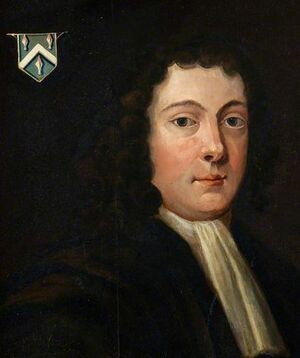
- 1657: Randle Holme restored the tower of St Mary on the Hill, and added a new peal of four bells. London to Chester coach service started.
- 1658: Owen Jones died, leaving the income from a plot of land near Minera for the benefit of the Guilds of Chester. Lead was later discovered there, vastly increasing its value. William Jones’ almshouses, are established in Pepper Street for 6 women and 4 men, all of whom had to be: “a poor and old inhabitant, unmarried, decayed and impotent” and swear that they did not indulge in “any Sins or Vices such as Adultery, Drunkenness and Swearing”. Randle Holme causes the "Phoenix Stone" to be placed on the Phoenix Tower. Celia Fiennes visits Chester. Oliver Cromwell dies.
- 1659; The Booth Rising: Sir George Booth surprised and took possession of the city. After gaining control of Chester on the 19th August, he issued a proclamation declaring that "arms had been taken up in vindication of the freedom of Parliament, of the known laws, liberty and property", and then marched towards York. Having been foiled in other parts of the country, General John Lambert's advancing forces defeated Booth's men at the Battle of Winnington Bridge near Northwich. Booth himself escaped disguised as a woman, but was discovered at Newport Pagnell on the 23rd whilst having a shave, and was imprisoned in the Tower of London. Parliament dissolved the Chester Corporation and ordered that the city should no longer be a separate county - however, the Parliamentarians did not hold power long enough to enforce the order.
- 1660: In the assessment list for the 1660 poll tax 1,307 householders were named by ward, but those in receipt of alms and exempt from the tax amounted to at least another 20 per cent, suggesting a real household total of 1,568 and a population of 6,742. Brian Walton is briefly Bishop of Chester. Governor and garrison removed from Chester Castle. Much of the outer gatehouse fell down, and John Shaw the county surveyor estimated cost of repairs to the Castle at £860. A garden was created in the Inner Bailey for the judges to walk in at the Assize.
links and sources
- The Oliver Cromwell website.
The Restoration (1660- 1714)
The revival of the city's overseas commerce after 1660 was hampered by wars and privateering, and it was never large even in the best years. In 1700, for example, there were only 10 outward international sailings and 20 inward. The export of tanned calfskins to France and Spain continued on a much reduced scale, with many interruptions. Instead, lead exports expanded markedly during the 1690s, when nearly 1,800 tons, two thirds of it ore and the rest pig lead smelted in Flintshire, was shipped to the Low Countries, with smaller quantities to Spain, Portugal, and France. Exports rose again after the peace of 1713, mainly of pig lead to France, and after 1740 Portugal, with totals sometimes reaching 2,300 tons a year. The tonnage of cheese carried, mainly to London, doubled between 1664 and 1676 and exceeded 1,000 tons in 1683 before dwindling rapidly because of French cheese-piracy after 1689. From the 1710s, with the renewal of peace, the trade grew enormously under London cheesemongers who used local cheese factors to collect from all over the Cheshire plain and neighbouring counties. About 1730 there were supposedly 20 ships making three round trips each and carrying over 5,500 tons a year (though no more than 1,500 tons a year was ever registered through the port records).
During the Restoration period a deep fissure had emerged in Chester’s body politic. By the 1680s two distinct groups, led by local Tory and Whig gentry, had emerged, and the 1690s saw the antagonism between these groups reach new heights. Led by the Whig Roger Whitley and the Tory Sir Thomas Grosvenor, 3rd Bt, these rival groups engaged in an increasingly bitter conflict over the extent of popular participation in corporate government, a battle in which the allegiance of the freemen became the crucial factor. The freemen’s main concerns appear to have been the willingness of the two groups to preserve their rights and privileges and to mitigate the economic problems caused by the decline of Chester’s port. The popularity of Whitley and his followers among the freemen allowed the Whig interest to dominate the corporation in the early 1690s, but in 1696 Grosvenor and his allies captured the mayoralty and the following year had established a Tory dominance in the borough that was to remain in place throughout this period.
Charles II (29 May 1660 - 6 February 1685). Son of Charles I. The next Earl of Chester was the "Old Pretender", followed by George Augustus, later George II
He was popularly known as the Merrie Monarch, in reference to both the liveliness and hedonism of his court and the general relief at the return to normality after over a decade of rule by Oliver Cromwell and the Puritans. Looking back, Tories tended to view Charles's reign as a time of benevolent monarchy whereas Whigs perceived it as a terrible despotism. Today he is seen as more of a lovable rogue—in the words of John Evelyn: "a prince of many virtues and many great imperfections, debonair, easy of access, not bloody or cruel". Charles left no legitimate heir. He did, however, have a dozen children by seven mistresses; five of those children were borne by a single woman, the notorious Barbara Palmer, Countess of Castlemaine, for whom the Dukedom of Cleveland was created. His other mistresses included Catherine Pegge, Louise de Kérouaille, Duchess of Portsmouth, Lucy Walter, Elizabeth Killigrew and Nell Gwyn.
- 1660: Amid modest jubilation following the Restoration the Chester corporation sent a loyal address to the king in early May 1660. Soon afterwards the aldermen began to dismiss some of the main supporters of the previous regime, principally the Cromwellian alderman and city counsel Jonathan Ridge. Between then and autumn 1660 three aldermen resigned, including the leading puritan Calvin Bruen, three royalists purged in 1646 were restored, and VIII Earl of Derby, was newly appointed. The communion table from St.Mary's-on-the-Hill was found to be missing, so 6d was spent on a warrant to search for it and 4d spent on constables "in going about to search for the table". Brian Walton was consecrated Bishop of Chester in December: in the autumn of 1661 he paid a short visit to his diocese, and returning to London, he died.
- 1661: Rumours of plots prevailed for some time after the Restoration. In 1661 doubts about the loyalty of the citizens led the corporation to pay for a permanent guard of 30 men and to stockpile match, while the county militia was also placed on alert.
- 1662: Following further rumours of plots the government stationed 60 foot soldiers in Chester. In February 1662, Henry Ferne became Bishop of Chester and died five weeks after his consecration on the 16th March. George Hall was then appointed as Bishop. Robert Venables (one time governor of Chester castle) published a successful book on angling: "The Experienced Angler, or Angling improved, being a general discourse of angling, imparting many of the aptest ways and choicest experiments for the taking of most sorts of fish in pond or river". Sir Theophilus Gilbey was granted a warrant to enlist and arm 60 foot soldiers to be kept under array at Chester Castle. Sir Evan Lloyd was appointed governor. A survey of the castle estimated the cost of repairs at £5,000. In 1662-4 however,only just over £546 was spent on repairs to the castle. "In the year l662 Lord Briereton, Sir Peter Leicester, Sir Richard Grosvenor, and Sir Geoffry Shackerby acting as commissioners for regulating the corporation endeavoured to remove several aldermen and common councilmen who appeared too much attached to the interests of their fellow citizens to be the avowed tools of governments" (Cooke)
- 1663: immediately after his appointment as governor of Chester Sir Geoffrey Shakerley repaired the city's fortifications and "repressed dissent".
- 1665: "many gentry imprisoned at the castle" (Roberts)
- 1666: Fears of an uprising among disaffected Parliamentarians stimulated the King to order the proceeds of the local mize to be paid to the Governor for additional repairs of Chester Castle.
- 1668: Charles Stanley, 8th Earl of Derby becomes Mayor of Chester. He presents the City with a silver gilt mace and a scabbard for the City Sword. Bishop of Chester George Hall dies in "an accident with a knife": John Wilkins is appointed in his place (he proposed a decimal system of measure not unlike the modern metric system). Wilkins was also a founder member of the Royal Society.
- 1669: "John Morgell, prisoner in Northgate gaol for debt, who fell on the stairs going to bed and died the next morning. N.B. Thomas Jones, barber-surgeon, contended that he died by the visitation of God, and not from the fall." QCI/12/6 24 May 1669. The spire of St Peter's, at the High Cross, was found to be in a dangerous condition, and demolished.
- 1670: significant beds of rock salt discovered near Northwich in Cheshire (salt having been produced here from brine springs since Roman times). It was customary for the two sheriffs of Chester to shoot with bow and arrows on Easter Monday, for a breakfast at which calf's head and bacon was the principal dish, after which the company went to the commercial hall of the city, where "the mayor, alderman and gentlemen and the reste take part together of the saide breakfast in loveing manner. This is yearly done, it being a commendable exercise, a good recreation and a loveing assemblye." In March 1670 the sheriffs were fined £10 for not keeping the calf's head feast. "Elizabeth Powell, prisoner in Northgate for last six years on charge of witchcraft, died from various ailments and from the long period of her detention." QCI/12/12 March 7th 1670
- 1672: Bishop of Chester John Wilkins died in London, most likely from the medicines used to treat his kidney stones and stoppage of urine. John Pearson was appointed as his successor. "Susan Fletcher, accidentally fell into a tub of fermenting beer, and her body was "ita glabrosa" that she took ill and died." QCI/12/55 3rd March 1672/3. "To such a degree was popular discord carried that at a parliamentary election in 1672 the Recorder Mr William Williams and Colonel Warden who had been gentlemen of the bed chamber to the Duke of York afterwards James the Second being opponent candidates eight men were killed in the crowd at the foot of the stairs of the common hall and the poll was in consequence adjourned to the Roodee." (Cooke)
- 1673: William Williams elected Member of Parliament for Chester. His profile grew, and he was elected to become Speaker of the House of Commons, a post which he held during the 3rd (Exclusion Bill Parliament, 1680–1681) and 4th (1681; Oxford Parliament) parliaments of Charles II. He was the first Welsh Speaker of the House. Randle Holme was a member of what was evidently one of the first permanent masonic lodges in England. At that date he was the only gentleman involved, his 25 companions being mostly well-off employers, notably in the building trades.
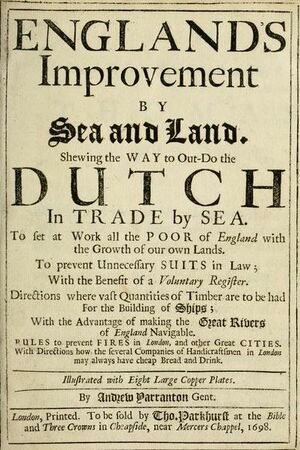
- 1674: A survey by Captain Andrew Yarranton, published in 1677 and entitled "England's Improvement by Sea and Land", concluded that the River Dee was so choked with sand that a vessel of twenty tons could not reach Chester, and propose the construction of a new channel along the Flintshire shore to provide deep water navigation to Chester
- 1675: the "Mary" the first Royal Yacht of the Royal Navy - sailing from Dublin to Chester is wrecked on the Skerries. Work starts on Eaton Hall designed by William Samwell.
- 1677: Thomas Grosvenor married; he was aged 21 and his wife, Mary Davis, was only 12. She was the daughter of Alexander Davis, a scrivener (scribe) and had inherited land to the west of London. This was part of the Manor of Eia (or Ebury) and Mary's portion consisted of "swampy meads" (or meadows). The area was later to become the Mayfair, Park Lane and Belgravia areas of London, a prosperous part of the Grosvenor estate.

- 1678: The "Popish Plot" (a fictitious conspiracy concocted by Titus Oates that ran between 1678 and 1681) led to cancellation of the Midsummer show and the Christmas watch in successive years, as well as repairs to the city walls. Titus Oates applied the term "Tory," which then signified an Irish robber, to those who would not believe in his Popish plot, and the name gradually became extended to all who were supposed to have sympathy with the Catholic Duke of York. Mr. Secretary Coventry writes to the Mayor of Chester ordering him to send to London one Mr. Burck, an Irishman, said to be employed in the King's secret service, Dec. 7, 1678.
- 1679: July 19th John Plessington, a practicing Catholic priest burned at the stake at Boughton after being tried and found guilty of High Treason, on account of his priesthood. From the scaffold at Gallow's Hill in Boughton, he spoke the following: "But I know it will be said that a priest ordayned by authority derived from the See of Rome is, by the Law of the Nation, to die as a Traytor, but if that be so what must become of all the Clergymen of the Church of England, for the first Protestant Bishops had their Ordination from those of the Church of Rome, or not at all, as appears by their own writers so that Ordination comes derivatively from those now living." There is a memorial tablet to him located in the entrance porch of St Werburgh's Catholic Church Grosvenor Park Road Chester. The Assembly Book records: "The Linendrapers stated in a petition that they had the privilege, confirmed to them by a charter of 6 Edward VI from the City, of being an ancient company, separate and distinct from all other trades. In 1603, by order of the Mayor and Justices of the Peace, they admitted the Bricklayers to join with them in setting forth certain pageants at the Midsummer show. They had found the Bricklayers very troublesome and unserviceable, being poor and unable to contribute to the defence of the Company's privileges. They desired that the Bricklayers might be debarred from being members of their Company and that they might be restored to their ancient privilege of being a separate Corporation of themselves. An order was made to this effect."
- 1680: The infamous "Hanging Judge Jeffreys" is made Chief Justice of Chester. Sir Geoffrey Shakerley was Governor and was ordered to disband the foot company garrisoning the castle. By 1681 there were only three gunners remaining.
- 1682: The visit of the Duke of Monmouth in September was accompanied by searches for arms, surveillance of those deemed disaffected, a few arrests, and frequent reports to London. Local antagonisms were intensified by the duke of Monmouth's visit (planned by Mayor George Mainwaring, Colonel Roger Whitley, and other leading Whigs). Monmouth was greeted enthusiastically by the populace and acted as godfather at the christening of the mayor's daughter. A new commission to Sir Geoffrey Shakerley to act as Governor, and a new garrison was installed. The men were quartered in public houses and private dwellings, and Chester Castle received a Roman Catholic chaplain. The duke rebelled in 1685 - "Hanging Judge Jeffreys" presided over the "Bloody Assizes" at which harsh sentences were handed out to the Duke of Monmouth's unsuccessful followers. Comet Halley also puts in an appearance. "Mary Ambrose, spinster, fell into a brewing pan and was scalded to death." QCI/14/27 Sept 4th 1682
- 1683: William Thomas Taylor, drowned while bathing near the Water-works, and suddenly taken with the "itch" QCI/14/33 June 18th 1683. "In the middle of August James Duke of Monmouth came to Chester greatly affecting popularity and giving countenance to riotous assemblies and tumultuous mobs whose violence was such as to pelt with stones the windows of several gentlemen's houses in the city and otherwise to damage the same. They likewise furiously forced the doors of the Cathedral church and destroyed most of the painted glass, burst open the little vestries and cupboards wherein were the surplices and hoods belonging to the clergy, which they rent to rags and carried away, they beat to pieces the baptismal font, pulled down some monuments attempted to demolish the organ and committed other enormous outrages." (Hemingway)
- 1685: Charles II suffered a sudden apoplectic fit on the morning of 2 February 1685, and died at 11:45 a.m. four days later at Whitehall Palace (at the age of 54). The symptoms of his final illness are similar to those of uraemia (a clinical syndrome due to kidney dysfunction). On his deathbed Charles told his brother, James: "Let not poor Nelly starve." and to his courtiers: "I am sorry, gentlemen, for being such a time a-dying." On the last evening of his life he was received into the Roman Catholic Church, though the extent to which he was fully conscious or committed, and with whom the idea originated, is unclear. In March of 1687, Nell Gwyn suffered a stroke that left her paralyzed on one side. In May, a second stroke left her confined to the bed in her Pall Mall house; she made out her will on 9 July. Nell Gwyn died on 14 November 1687, at ten in the evening, less than three years after the King's death. She was 37 years old.
sources and links
- Diary of Roger Whitley - MP for Chester;
James II (6 February 1685 — 11 December 1688). Second surviving son of Charles I. Was never Earl of Chester.
James was the last Roman Catholic monarch to reign over the Kingdoms of England, Scotland, and Ireland. Many of his subjects distrusted his religious policies and autocratic tendencies, leading a group of them to depose him in the Glorious Revolution in 1688. He was replaced not by his Roman Catholic son, James Francis Edward (the Earl of Chester), but by his Protestant daughter and son-in-law, Mary II and William III, who became joint rulers in 1689. James made one serious attempt to recover his crowns, when he landed in Ireland in 1689. After his defeat at the Battle of the Boyne in the summer of 1690, James returned to France, living out the rest of his life under the protection of his cousin and ally, King Louis XIV.
- 1685; following the outbreak of Monmouth's rebellion in June: the Midsummer fair was cancelled, suspects were imprisoned at Chester Castle, and arrangements were made (in the event proving unnecessary) to send 1,000 foot from Ireland to protect the city. The duke's cause evidently had some support in Chester, but there was no uprising. Thomas Grosvenor became Mayor of Chester and later raised a troop of horses to support James II in the Monmouth Rebellion.
- 1686; Bishop of Chester John Pearson died at Chester on 16 July 1686, and is buried in Chester Cathedral. Thomas Cartwright was then appointed bishop of Chester by James II, and became a member of the King's Ecclesiatical Commission. In October 1687 he was one of three Royal Commissioners, with Robert Wright and Sir Thomas Jenner, sent to Magdalen College, Oxford. They removed all but three of the Fellows. After the Glorious Revolution he followed James II into exile. He died in Dublin (1689), of dysentery, and is buried in Christ Church, Dublin. The City Assembly debated the bin-men: The Treasurers were ordered to engage common scavengers for cleaning the streets and common lanes. Within fourteen days after they had agreed with the scavengers, an equal assessment for the purpose was to be laid upon the inhabitants of the wards. The assessment was to be laid and collected by persons appointed by the Aldermen of each ward. (ZA/B/3/10v) If the scavengers were not paid the sum of money which the Treasurers had agreed to pay out of the assessment, within twenty-eight days after it ought to be paid, then the Treasurers should pay the scavengers out of the Common Treasury. This payment would be allowed to the Treasurers in their account, and the Treasury would be reimbursed out of the assessment money. It was further ordered that no persons inhabiting within the City should cast out their dirt or ashes into the street. They were to keep these in their backsides until the days on which the scavengers came to take away the dirt from the streets (at least twice a week), and should then cast them into the scavengers' carts, to be carried away to such places as the City should appoint, Penalty for failing to observe this order: 2s: 6d. - "Mary, wife of John Gutteride, butcher, fell into a vat of boiling water and was scalded to death" QCI/15/15 Jan 14th 1686

- 1687; Mistrust of the king was evident during his visit to Chester in August 1687, to the extent that the governor of Chester was unable to procure a loyal address from the corporation. The King saw the Quaker, William Penn preach at the Quaker meeting house in Frodsham Street. Bishop Cartwright of Chester wrote: "I was at his majesty's leave and accompanied him to the choir where he healed 350 persons" (presumably of the "king's evil"). At this time Chester Castle was garrisoned by 8 companies of soldiers from Ireland and a newly appointed furbisher. The Castle received a new armoury and Frobisher's shop.
- 1688; the Roman Catholic lords, Molyneux and Aston, raised a force, and made themselves masters of Chester, for James II - unfortunately James' "abdication" rendered their efforts useless. The first book to be printed in Chester, the 'Academy of Armory', is published. In the event of the Glorious Revolution the country is "invaded" by the Dutch and James II is deposed .During his last years, James lived as an austere penitent. He died of a brain hemorrhage on 16 September 1701 at Saint-Germain-en-Laye. During the French Revolution, James's tomb was raided and his remains scattered.
William III (and Mary) (12 February 1689 - 8 March 1702). William was "invited" over from Holland, Mary (died 1694) was co-monarch and daughter to James II.
William's primary achievement was to contain France when it was in a position to impose its will across much of Europe. His life was largely opposed to the will of King Louis XIV of France. This effort continued after his death during the War of the Spanish Succession. Another important consequence of William's reign in England involved the ending of a bitter conflict between Crown and Parliament that had lasted since the accession of the first English monarch of the House of Stuart, James I, in 1603. The conflict over royal and parliamentary power had led to the English Civil War during the 1640s and the Glorious Revolution of 1688. During William's reign, however, the conflict was settled in Parliament's favour by the Bill of Rights 1689, the Triennial Act 1694 and the Act of Settlement 1701.
After the Restoration Chester was still regarded as 'the head of the region', but in fact its provincial standing was permanently reduced. By the yardstick of the hearth tax both Shrewsbury and Manchester were as big, and soon after 1700 Chester was outstripped by Liverpool, Manchester, Birmingham, and Dublin. In the 1690s the city's political alignment was in the balance. Chester needed influential connections to obtain a scheme for the Dee navigation, relief from heavy taxation, and a relaxation of the regulations hindering the import of cattle and hides. Economic and political issues were therefore linked as Whig and Tory groups, led respectively by Roger Whitley and Thomas Grosvenor, vied for control of parliamentary representation.
- 1689: Nicholas Stratford appointed Bishop - he was one of the founders of the Blue Coat School (see: St John's Hospital) in Chester. He promoted good relations with the Chester nonconformist Matthew Henry, and supported the Society for the Reformation of Manners. Henry Howard, 7th Duke of Norfolk raised a regiment on the little Roodee in Chester in an effort to resist any attempt by James II to re-take the English throne - this would eventually become the Cheshire Regiment. Peter Shakerley was replaced as Governor of Chester Castle by Sir John Morgan, who requested two new companies of 100 men. A gun platform was built at the Castle. The Assembly Book records: "Thomas Crichley, draper, stated in his petition that last Midsummer Randle Minshall, Macebearer, "being very aged and infirme and almost blind" by consent of the Mayor and Justices, employed him as his servant to attend the Mayor, carry the mace and officiate in his stead. The Mayor and Justices ordered that Minshall should pay him £20 a year as reward, but he had not done so. He asked that the house should make an order for his relief. It was ordered that Critchley should be deputy Macebearer for Randle Minshall, who should pay him £4 quarterly to begin at the previous Christmas. Thereupon Critchley took a solemn oath to conceal the secrets of the Assemblies so often as he should be admitted to them."
- 1690: Chester Castle was used in the transport of soldiers to Ireland to repress the Jacobites. The roof of the Exchequer court and protonotary’s office were repaired. William visited Chester (later, on 1st July, he defeated his father-in-law James II at the Battle of the Boyne). John Davies falls down the stairs the the Pied Bull and dies - he is still said to haunt the cellar ("John Davies, brewer, fell down the stairs leading to the cellar of the Pied Bull Inn and died later" QCI/16/4 Oct 31ST 1690). The 1690 election saw the Whig MPs for Chester, Roger Whitley and George Mainwaring, opposed by the Torys Banonet Thomas Grosvenor and Alderman Richard Levinge - who win (see Grosvenors).
- 1691: ten young women drown in the River Dee, opposite St John's Church, by "the upsetting of a boat" on Whit Monday ("Mary, Ann and Elizabeth Hiccocke, (daughters of Richard Hiccocke, barber.) Elizabeth Hanley, Thomason and Anne Ludman, Martha and Katherine Harrison, Robecca Maddock and Dorothy Hampson, drowned when their boat capsized in the Dee". QCI/16/11 June 9th 1691) - "Whit Monday being a day of general recreation eleven young women were in a boat rowed by two watermen upon the river just under St John's church when one of the watermen threw an apple among them which they attempting to scramble for and rushing to one side of the boat overset it by which accident ten of them were drowned The two watermen swam to shore when Phoebe Jones catching hold of the leg of one of them held so fast that he drew her after him to the bank side but in the action of swimming he had with the heel of his shoe beat out all her front teeth." The Assemby Book records: "The Company of Carpenters set forth in their petition that of late they had been grievously oppressed by lawsuits, prosecuted against several of them by the Company of Joiners, Carvers and Turners, on the charge of exercising the trade of a joiner in the City. They said that the trades of carpenter and of joiner were not easily distinguishable so that jurors sometimes gave a verdict for them and sometimes against them, and much money had already been spent on, lawsuits. They prayed that the Assembly would recommend some expedient for an amicable settlement between the Companies so that they might ascertain the work which properly belonged to their respective trades. It was ordered that the petition should be taken into further consideration." Repairs to the armoury at Chester Castle included 62 yards of brick walling, also the Flag Tower and Half-moon Tower were re-roofed.
- 1692: Roger Whitley (Whig) chosen mayor (he was to hold this post for the next four years).
- 1693: Roger Kirkby becomes governor of Chester Castle. A Roman altar found on the corner of Newgate Street and Eastgate Street
- 1694: Queen Mary dies of smallpox. A company of c. 90 invalids was drawn out of Chelsea hospital to garrison Chester Castle.
- 1696: The Great Recoinage supervised by Edmond Halley (frequently misspelled), as Deputy Controller at Chester Castle. This is so badly organised that William runs out of money and is forced to abandon his campaign in France. The Grosvenor (Tory) faction scoured the city for supporters eligible for the freedom who had not yet exercised this right resulting in the admission of over 120 new freemen in the two weeks before the mayoral election.
- 1697: Edmond Halley observes a triple rainbow from next to the Phoenix Tower. Death of Roger Whitley - demise of the Whig facrion in the Corporation. Grosvenor’s supporters dominated the common council election of June, and in October annual popular election of the common council was replaced by co-option to the Assembly for life.
- 1698: Chester Exchange completed in Market Square. Letter from Mr. Secretary James Vernon to the Mayor of Chester directing him to hold prisoners Edward Ivy alias Jones, John Jennings and Edward Brady sent from Dublin on a charge of counterfeiting the coin of the realm, June 21, 1698. Celia Fiennes visits Chester.
- 1700: Shakerley and Grosvenor pilot a bill through Parliament granting the corporation the authority to embark upon the navigation of the River Dee.
- 1702: William III died of pneumonia, a complication from a broken collarbone, resulting from a fall off his horse, Sorrel. Because his horse had stumbled into a mole's burrow, many Jacobites toasted "the little gentleman in the black velvet waistcoat."
Anne (8 March 1702 – 1 August 1714). Mary's sister.
Anne's life was marked by many crises, both personally and relating to succession of the Crown and religious polarisation. Because she died without surviving issue, Anne was the last monarch of the House of Stuart. She was succeeded by her second cousin, George I, of the House of Hanover, who was a descendant of the Stuarts through his maternal grandmother, Elizabeth, daughter of James I. A statue of Queen Anne used to stand in a niche alongside the steps leading to the watertower. However according to Virtual Stroll it vanished in the 1960's. From the 1710s the Grosvenor family repeatedly intervened in the Chester's affairs. All attempts to break their power were thwarted, despite popular support and the presence within the corporation of a faction opposed to Grosvenor influence.
- 1702: the Quaker's Meeting House in Cow Lane (Frodsham Street) built (it is still on the same site). The upper part of the Goblin Tower (Pemberton's Parlour) removed. "Benjamin Butler, drowned, while under the influence of drink, in a trough belonging to Dee Mills" QCI/17/3 Dec 4th 1702
- 1703: At the age of seven Ibrahim Hannibal was taken to the court of the Ottoman Sultan at Constantinople as a slave. After many adventures he became governor of Tallinn (Russia). Some British aristocrats descend from Hannibal, including Natalia Grosvenor, Duchess of Westminster.
- 1704: the south side of the Pentice was rebuilt in brick
- 1705: Hugh Cholmondeley becomes governor of Chester castle.
- 1707: the corporation restored and leveled the walls (completed 1708) to provide "an agreeable pathway" around the city. Morgan's Mount is rebuilt.
- 1708: William Dawes appointed Bishop of Chester. This was at the personal wish of Queen Anne, who overruled the advice of her ministers in appointing him.
- 1710: Roodee enclosed with a cop (earthen embankment). St Michael's steeple rebuilt, as well as the west tower which straddles The Rows - a unique arrangement.
- 1714: Military stores and ordnance were removed from Chester Castle to the Tower of London. Francis Gastrell was consecrated Bishop of Chester. Queen Anne died of suppressed gout, ending in erysipelas, at approximately 7 o'clock on 1 August 1714. Her body was so large that it had to be buried in Westminster Abbey in a vast almost-square coffin.
The Hanoverians
By 1700 Chester was on the verge of losing its dominance as a regional economic hub, as nearby towns, especially the industrial and mill towns in south Lancashire and around Telford began to specialize in trade or manufacturing. The reopening of the Dee in 1737 did not halt Chester's decline as a port. In 1701 Chester shipowners had 25 vessels, and in the early 1710s the total tonnage, no more than 3,400, was less than half that owned at Liverpool. By the 1730s it had fallen to around 1,650 tons (a tenth of Liverpool's total) and in the late 1750s Chester's 1,000-1,400 tons was scarcely a twentieth of Liverpool's fleet. Efforts were made to improve the Dee by dredging a "new cut" in the estuary and cutting the canal, but the decline of traditional industry and trade continued. For more on this period see Georgian Chester
George I (1 August 1714 – 11 June 1727). Anne's closest living Protestant relative (51st in succession). Was never Earl of Chester.
George was ridiculed by his British subjects; some thought him unintelligent on the flimsy grounds that he was wooden in public. Though he was unpopular due to his supposed inability to speak English. However, in Europe he was seen as a progressive ruler supportive of the Enlightenment, who permitted his critics to publish without risk of severe censorship, and provided sanctuary to Voltaire, when the philosopher was exiled from Paris in 1726. European and British sources agree that George was reserved, temperate and financially prudent: George disliked to be in the public light at social events, avoided the royal box at the opera and often travelled incognito to the house of a friend to play cards. In Chester, membership of the corporation was occasionally conferred on the Grosvenors, their allies among the Cheshire gentry, and other outside supporters, including in 1720 their steward and political agent, Robert Pigot, who served as mayor in 1723-4.
- 1715: 500 Jacobite prisoners were brought to Chester after the government’s victory at Preston. Among them Charles Murray. They were imprisioned at Chester Castle - "The weather was very severe, and the snow lay a yard deep in the roads. Many of the above mentioned prisoners died in the castle by the severity of the season; many were carried off by a very malignant fever; and most of the survivors were transported to the plantations in America. As the castle was quite filled with these prisoners, the Lent assizes were held at Nantwich" (Hemingway)
- 1717: the Chester Corporation cooperated with private subscribers in replacing the former St John's Hospital outside the Northgate. "Blue Coat Hospital which was founded by subscription in 1700 at the instigation of Bishop Stratford uncle to the Commissary the greater part of the present structure was built in 1717 partly at the expense of the Corporation and partly by benefactions."(Seacome)
- 1718: Thomas Parnell, one of the so-called "Graveyard poets", dies at Chester and is buried in Trinity Church. Recorder Comberbatch (for whom the Recorder's Steps were built according to the mis-dated plaque on them) dies.
- 1720: the City Walls were connected with the Groves, by the Recorder's Steps (built by the Corporation). As part of the Roodee cop is washed away it is repaired with stonework. 18th December - a huge boulder was washed up on the banks of the River Dee by floods: this is now at the Grosvenor Museum (but not on display). "Matthew Sherlock, brought into prison "much in drink" and suffocated by smoke when his candle set the straw on fire" QCI/19/28 July 30th 1720
- 1724: The mortal remains of Hugh of Avranches, having lain undisturbed for over six centuries, were found in the Chapter House of the Cathedral, wrapped in leather, and deposited in a stone coffin, having a cross on the breast. They were re-buried with the following terrible verse: "Altho my corpse it lies in grave/And that my flesh consumed be/My picture here, now that you have/An Earl some time of this city". "Richard Thompson, pipemaker, poisoned himself by taking arsenic" QCI/19/38 April 10th 1724
- 1725: Daniel Defoe (author of Robinson Crusoe) visits Chester: "The walls, as I have said, are in very good repair, and it is a very pleasant walk around the city and within the battlements". By 1725 the city had three separate masonic lodges, more than in any other provincial town, who met at the Sun, Spread Eagle, and Castle and The Falcon inns. Membership had shifted decisively towards country gentlemen, members of the urban élite, and army officers from the garrison. The master of the Sun lodge, Colonel Francis Columbine, was the first Provincial Grand Master in the country.
- 1727: George I suffered a stroke on the road between Delden and Nordhorn (in Hanover) on 9th June. He died in the early hours of 11th June. Thomas Robinson and Robert Meridith fight a duel (with swords) in Foregate Street - Robinson is killed (Thomas Robinson, gent., killed in a sword fight with Robert Meredith after drinking together in the Golden Talbot Inn in Eastgate Street QCI/20/2 Sept 1727). "A private soldier received 900 lashes and was drummed out of his regiment with rope about his neck having been found guilty of being a Papist."
George II (11 June 1727 – 25 October 1760). Son of George I. First Earl of Chester since the "Old Pretender".
He was the last British monarch to have been born outside Great Britain, and was famous for his numerous conflicts with his father and, subsequently, with his son. As king, he exercised little control over policy in his early reign, the government instead being controlled by Great Britain's first de facto Prime Minister, Sir Robert Walpole.
- 1728: Chester Castle was commanded by a Governor and two companies of invalid soldiers.
- 1729: "Miles Gerrard, cutter, died by misfortune while under the influence of drink" QCI/20/12 Dec 26th 1729
- 1731: "Samuel Cookson, labourer, fell through trap door while assisting at Ald, Bennett's to lever casks of wine into the cellars and was instantly killed" QCI/20/16 May 18th 1731. "Thomas Dannald, baker, clerk of the Waterworks, slipped under the water engine while attempting to "oyl the Brasses" and was instantly killed" QCI/20/17 June 17th 1731
- 1732: The Whigs tried to win over the mayor of 1731-2 (Trafford Massie) by offering clerical preferment for his son. Shortly before the election in 1732 the Whig candidate for mayor left £100 in gold with Massie in return for a written promise to call no further Assemblies. Meanwhile sporadic disorders culminated in a clash in Bridge Street in early October between a Whig mob (allegedly reinforced with disguised soldiers, revenue officers, and Liverpool sailors) and Tory supporters who included Welsh miners. The latter came off worse, and the Whigs broke into and wrecked the Pentice. The mayor called for dragoons from Warrington to help restore order and appointed c. 270 special constables. The violence shocked the faction leaders into a truce, but when polling was adjourned the Whigs, supposing that their man had won, pursued the mayor and justices into the coffee house under the Exchange and carried off the mayoral sword and mace.
- 1733: The Merchant Venturers of Chester obtained an Act of Parliament authorising a 'New Cut' under the supervision of the marine engineer Nathaniel Kindersley. "The first sod of the new channel of the river Dee was taken up by R Manley Esq April 20th". "Lucy Conway, spinster, overcome by fumes while stiring a "comb" in the brew-house and fell in and was drowned" QCI/20/28 June 15th 1733
- 1734: "was commenced a newspaper called Adams's Weekly Cqurant.. the whole of its contents besides an invitation to buy the wares of the tradesmen being confined to a few paragraphs of news copied from the Lloyd's Evening Post the announcement of deaths and marriages the perpetration of a daring robbery or bloody murder or the occurrence of some dreadful accident within the immediate district" - (Hemingway) "A general election approaching in 1734 both parties began to muster their forces This proved to be one of the severest contests which the city had ever experienced Their passions already inflamed and conscious of the enormous weight of influence against them the Whigs were driven into excesses which would have been inexcusable on any other occasion" - (Cooke) Chester once had a crier, a day bellman and a night bellman, but in 1734, John (or Thomas) Posnitt took over as "Day and Night Bellman."
- 1736: while visting Chester Samuel Johnson supposedly scratched the words "Charming Miss Oldfield 1736" on the first floor front window of Olde Leche House. At the time Johnson was recently married and working as a schoolmaster near Lichfield, however his Tourette's syndrome meant that he could not continue with that occupation.
- 1737: Nathaniel Kindersley's new Dee cut along the Welsh shore was opened
- 1739: "The Mayor was this year refused admittance into the Abbey court by Bishop Peploe when proclaiming war against Spain whereupon he ordered the Abbey gates to be broke down". "Patrick Rowney, gardiner, accidentally shot when John Leche, clerk to Nathaniel Barber, attorney at law, was trying out his gun which had just been repaired by Michael Hutchinson, gunsmith" QCI/20/60a Nov 23rd 1739. "Great frost for 13 weeks. Carts crossed the river and a sheep was roasted on the ice"
- 1741: Handel visits Chester having stated that he would "smoke a pipe over a dish of coffee in the Exchange Coffee House"
- 1743: George II was the last King of Great Britain to lead his troops into battle in person at the Battle of Dettingen (against the French) in 1743. It was a British victory and Handel composed the "Dettingen Te Deum" specially for the celebrations that followed. During the battle Lieutenant-Colonel Sir Andrew Agnew warned The Royal Scots Fusiliers not to fire until they could “see the whites of their e’en.” George II’s horse "bolted" during the battle and ran away. George is said to have "sheltered" under an oak and to have presented an oak leaf to the soldiers who looked after him. The Cheshire Regiment claims this honour (they were in garrison in Minorca at the time - but a detachment was present).
- 1744: Lead discovered on land left by Owen Jones near Minera.
- 1745: During the Jacobite revolt part of the county militia was brought in to garrison the city. The city gates were bricked up, save for wickets at the Bridgegate and Eastgate, the walls were patrolled, cannon were mounted to command the bridge, and the castle defences were improved. The spring assizes were held at Flookersbrook in Hoole. George Earl of Cholmondeley put Chester in a state of defence, repairing Chester Castle’s defences and adding raised batteries in the inner and outer wards and a raised platform with a parapet south-east of the Great Hall. The military architect Alexander de Lavaux was engaged to draw up a plan to strengthen the fortifications, with massive earthworks, but the work was never carried out.
- 1747: John Bishop, labourer, found a cask of spirits in the stables while looking after the horses of Samuel Gellion, carrier, and died of an excessive indulgence. QCI/21/26 Dec 20th 1747
- 1750: The Chester Hunt had as its kennels a building outside the Northgate which it rented from the corporation; the hunt master at that time was apparently Sir Richard Brooke, Bt., of Norton.
- 1752: Race week at Chester was moved to the first full week in May after the Gregorian calendar reform (leaving out 3–13 September inclusive), allegedly because the mayor, a draper, hoped to sell more summer dresses in warmer weather.
- 1753: "John Taylor, son of Thomas Taylor, labourer, (died) overcome by the damp while down the well of Thomas Bingley, alderman." QCI/22/11 Sept. 21st. 1753
- 1755: Infirmary (1755-1993) founded following a bequest by Dr William Stratford, who had died two years earlier. It was funded by public subscriptions, and was free to patients who were recommended by the subscribers. It was originally housed in temporary accommodation in part of Bluecoat School (St John's Hospital).
- 1756: the last (historical) Minstrel Court held - this practice was restored at St Johns in 2009 although it is not clear that the practice of "an annual payment of four pence from every female of a certain notoriety within the county of Chester" was also restored. The shops on the west side of the Exchange built.
- 1757: all the city parishes, several of which had their own poorhouses, combined in an agreement to send their poor to a new workhouse, to be built at corporation expense in what was later to become Paradise Row on the north-west side of the Roodee.
- 1758: Watkin Tench born in Chester. A British Marine officer best known for publishing two books describing his experiences in the "First Fleet", which established the first settlement in Australia in 1788. The Royal Navy ordered that ships be stocked with Cheshire and Gloucester cheeses. House of Industry built.
- 1759: the Chester "Poor-law Union Workhouse" was established. It was approached by a new road from outside the Watergate - later Paradise Row. Comet Halley revisits. The Infirmary completed.
- 1760: At Chester Castle a large portion of the curtain wall of the inner bailey behind the armoury fell down. Repair work over the next few years (completed 1799) included the reconstruction of Lord Cholmondeley’s battery. on the morning of 25 October 1760, George II entered his water closet, and after a few minutes, his valet heard a loud crash. He entered the water closet to find the King on the floor. A post mortem revealed that the King died of a ruptured aneurism of the aorta.
George III (25 October 1760 - 29 January 1820). Grandson of George II and previously Earl of Chester.
George III's long reign was marked by a series of military conflicts involving his kingdom and much of the rest of Europe. Early in his reign, Great Britain defeated France in the Seven Years' War, becoming the dominant European power in North America and India. However, many of its American colonies were soon lost in the American Revolutionary War, which led to the establishment of the United States. Later, the kingdom became involved in a series of wars against revolutionary and Napoleonic France, which finally concluded in the defeat of Napoleon in 1815. Later in his reign George III suffered from recurrent and, eventually, permanent mental illness. In the years immediately following the end of the Napoleonic Wars in 1815, there was concern on the part of Lord Liverpool’s government that the economic recession might result in serious civil unrest. In July 1819 troops opened fire on peaceful demonstrators in Manchester, an incident known as the "Peterloo Massacre". This prompted concern that mobs might attack military establishments throughout the country, and, locally, there was much correspondence in the latter half of 1819 concerning the security of Chester Castle.
- 1762; Isaac Bickerstaffe's play, "Love in a village" first performed. The play contains the song Miller of Dee. Bickerstaffe later fled to France following a homosexual scandal and the play was parodied as "Love in the Suds".
- 1763; a coaching sign giving the distances to London, Worcester, Ludlow, Bristol and Bath is put up outside the Pied Bull - it is still there! "Mary Heald burned at Boughton for poisoning her husband". "James Wright, fell from scaffolding on St. Peter's steeple and was killed" QCI/23/19 Aug. 9th 1763
- 1766; James Stuart the "Old Pretender" (Earl of Chester) dies. Medieval Eastgate demolished, revealing remains of Roman gateway.
- 1768; "Mary Davies, poisoned herself by putting arsenic in her ale." QCI/23/46 May 31st 1768
- 1769; "In 1769 the Eastgate being found too narrow and inconvenient was pulled down and a magnificent arch arose in its room at the sole expence of Richard lord Grosvenour".
- 1770; "The Bars" a narrow defensive postern in the outer City defences in Boughton at the end of Foregate Street, is demolished.
- 1771; the people of Chester, fearing that the construction of the Trent and Mersey Canal would divert trade away from their city to Liverpool, announced in the Press that they would be applying to build a canal between Middlewich, on the Trent and Mersey, and Chester. The River Dee Company had recently spent £80,000 on improvements to the river, but without a connection to the growing canal network, there was little future for the river or the Port of Chester.
- 1772; New Crane Wharf on the River Dee, with its large warehouses and Harbour Master's house, was completed. On 5th November an explosion occurred in Watergate Street - "A few minutes before nine o clock in the evening the inhabitants of the city were greatly alarmed by a loud unusual noise attended with a shaking of the ground which every one imagined to proceed from an earthquake But the news soon spread that a large number of people assembled at a puppet show had been blown up by gunpowder placed in a warehouse which was under the room." - "Elizabeth Hale, Elizabeth French, Anne Peers, George Williams, Elizabeth Williams, Hendrick Eaton, Elizabeth Cooke, John Merijohn, Edward Powell, James Harrison, Elizabeth Allen, John Lawrencson, Timothy Garner, John Hewitt, Mary Ankers, Esther Jones, William Roberts, Elizabeth Williams and Robert Williams, while watching a puppet show in Eaton's Room, Watergate Street, were blown up and killed by an explosion of gundpowder stored in a warehouse below." QCI/24/16 Nov 7th 1772. Local preachers including one in Queen Street were quick to point out that such places were "the haunts of dishonest men and whores, where sinful bargains were struck and poisonous philosophies were spread." and that the explosion was "an alarming providential check to immorality, a vengeful act of God against such sin".
- 1773; The Chester theatre was erected by a company of proprietors in 1773 on the site of St Nicholas chapel (see: Music Hall Passage) and opened the same year under the management of Messrs Austin and Heaton. Public library opens in St John Street
- 1774; Samuel Johnson visits Chester and has a walk around the City Walls.
- 1775; Chester Chronicle (see: Newspapers in Chester) established
- 1776; the connection between the canal and the River Dee is opened. Hemingway records: "On the 12th of January in this year a fire occurred in the shop of Miss Washington milliner East gate street which destroyed a considerable part of the stock. April 28 - the banns of marriage published in the church of St Oswald's between George Harding aged one hundred and four years and Jane Darlington of Mollington aged eighty four."

- 1777: Chester hatters were involved in a national organization of journeymen and joined with colleagues elsewhere in unsuccessfully petitioning parliament against a Bill promoted by the employers to remove limitations on the number of apprentices which each master might take. Earthquake felt in Chester. "Samuel Thornley a butcher from Congleton was hanged and gibbeted this year for the murder of a young woman a ballad singer The motive that influenced this wretch was simply avarice as it appeared in evidence he had cut up the body after the manner of pork and had actually made use of some part of it for food". Townshend obtains a Royal Licence for the theatre.
- 1778: Linen Hall built by Irish linen merchants as a depot from which their cloth was distributed throughout England, Wales and Scotland. The "New Linenhall", was a large rectangular brick building comprising small shops around a courtyard and was erected on the eastern half of the Greyfriars site. "The Irish Linen Hall Built in 1778 at the expense of the linen merchants was situated in Watergate - street between Stanley Place and Lower lane, and contains 36 double and 24 single shops it is used, as its name imports, as a mart for Irish Linens. It was for many years used as the Cheese Mart, The latter Hall was a sleepy quiet place but often, in a few hours, cheese to the value of £5,000 would change hands. It was sold by the hundred weight, and only under exceptional circumstances could a single cheese be bought. Many tons of Cheshire cheese were from time to time shipped for London and other large towns as well as to the Continent." Also that year: "The Huntsman of the Chester Harriers for a wager rode his horse round tho walls in nine minutes and a half leaping two turn stiles in the circuit". Hemingway records: "During this year three privateers sailed from this port namely the Empress of Russia of 24 guns and 120 men the Hero of 16 guns and 80 men and the Spy of ten four pounders 12 swivels and 50 men. The former after capturing a Swedish ship of 300 tons was taken by a French frigate, and sent into L Orient."
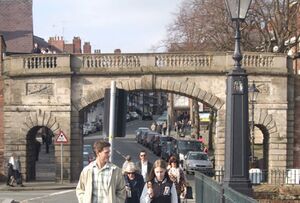
- 1779: Chester-Nantwich canal cut. James Boswell visits Chester and in a letter to Samuel Johnson writes: "Chester pleases my fancy more than any town I ever saw" (the Life of Samuel Johnson). "Two Roman Hypocausts discovered in the Linen Hall field about three feet under ground also a coin of Diocletian at the same time This year a gold coin of Nero was found in digging a foundation in Foregate street". October 2nd: Sarah Jones executed at Boughton for theft of 28 yards of chintz from Mr Meacock in Chester.
- 1780: City is illuminated to mark the victory of Rodney at Cape St Vincent.
- 1781: Medieval Bridgegate demolished and replaced by present arch by Joseph Turner.
- 1782: naturalist Thomas Pennant publishes his "Journey from Chester to London". "The following anecdote has been told of him Among other peculiarities he had a great antipathy to a wig which however he could suppress until reason yielded to wine Dining once at Chester with an officer who wore a wig Mr Pennant became half seas over when another friend that was in company carefully placed himself between Pennant and the wig to prevent mischief At length however after much patience and many a wistful look Pennant started up seized the wig and threw it on the fire Down stairs ran Pennant and the officer with hU sword after him through all the streets of Chester but Pennant from his superior knowledge of topography escaped This was whimsically enough called Pennant's Tour through Chester" The Georgian Era (Clarke). A giant fish is found in the Dee.
- 1784: John Oakes executed at Boughton for Coining. A Chester to London mail coach set a new record of a 22 hours and 45 minutes. The Grosvenors spent £24,000 on the general election, of which £15,000 went on drink and £1,600 on yellow ribbons and cockades (their opponents sported blue and red).
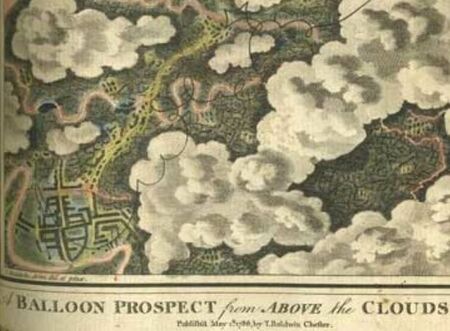
- 1785: Chester's first hotel, the "Royal Hotel" opens on the site of the current "Grosvenor Hotel". Competition held to re-build the gaol at Chester Castle. There are a number of balloon ascents from Chester as part of the Lunardi "balloon craze" . Captain G French and Thomas Baldwin ascended in Lunardi’s balloon from the castle yard. Quarter sessions ordered the rebuilding of the County goal at Chester castle, and this was awarded to Thomas Harrison.
- 1786: "Steam Mill" starts operation the world's first steam-driven commercial flour mill using Boulton and Watt’s rotative engine. "A man ran from the Eastgate to Christleton and afterwards round the outside of the City Walls in 51 minutes; a distance of near seven miles" (Hemingway). A large portion of the curtain wall at the battery of Chester Castle fell down and needed to be rebuilt.
- 1788; Medieval Watergate demolished and replaced by the present arch designed by Joseph Turner. Harrison demolished the Exchequer and constables house at Chester Castle, then built the "new" prison and southern parts of the main Assizes block.
- 1789; Dee Mill destroyed by fire. "A mare belonging to Mr Hodson harnessed to a truck taking fright ran away with great fury down Wall's lane and breaking down the railing leaped over the city wall to the Roodeye without the least injury". A passage with a new gateway was opened into the upper ward at Chester Castle, and consent was given for the Outer Gatehouse to be removed and replaced by a new arch and guardrooms. "A man accidentally killed on Dee bridge by striking his stick on the lock of the pistol of one of the 3rd dragoons who was escorting deserters to Shrewsbury" (Hemingway)
- 1790; "John Dean of Stockport executed for the murder of his wife with a heavy hand brush. It appeared that after completing the work of death when the body convulsively moved he exclaimed 'What damn thy soul arnt thou dead yet'. He was afterwards hung in chains at Stockport" . "Jane Melliford, poisoned herself by taking two ounces of oil of Vitriol" QCI/27/2 Feb 25th 1790
- 1791; "Three men executed for a burglary the gallows being for the first time removed to the North side of the road in Boughton". At Chester Castle, the Exchequer, Grand Jury Room, Protonotary’s office and Prisoners’ Wards had all been finished. "Cheshire militia embodied their parade ground in the Bottoms field " (Hemingway)
- 1792; Owen Williams established the Chester Old Bank. "The coachman of Mrs Cowper of Overleigh taking the carriage with a pair of horses down by the toll house at the bridge to the river to wash drove them beyond their depth the tide then flowing the footman and horses were drowned the coachman clung to the carriage and was saved" (Hemingway)
- 1793; Thomas & Hesketh's Bank (of Chester) became insolvent. American revolutionary Tom Paine, author of "The Age Of Reason" was burnt in effigy at the High Cross. "Mr Perceval (afterwards murdered by Bellingham) attended Knutsford sessions as council against a man for selling Paine s works" (Hemingway)
- 1794; Sir W. W. Wynn's "Ancient British regiment of fensible cavalry raised" (at Chester). Mr Eddowes, leader of the "Independent Party" in Chester, quits in disgust at political corruption and embarks for America.
- 1795; A cold winter leads to food shortages, riots in Stockport, Congleton, Northwich, Nantwich and Chester. "Death of Thomas Grosvenor Esq MP for this city near 40 years - Colonel Grosvenor introduced as his successor" (Hemingway). The Ellesmere canal completed from Chester to the river Mersey at Ellesmere Port. Passage boat launched in the new canal for the Mersey
- 1796; minor earthquake in Chester. "The mail robbed near Dunham on the Hill Jan 19th - T Brown and J Price executed for the above robbery on May 1st".
- 1797; City illuminated in honour of Duncan's victory over the Dutch Navy at the Battle of Camperdown. The mayor's feast formerly held on the first Sunday after his election abolished by Rowland Jones mayor.
- 1799: The main block including the Shire Hall, its portico and Prison Chapel at Chester Castle were finished.
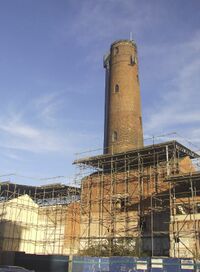
- 1800; Walkers, Maltby & Co. set up a Leadworks on the banks of the Chester and Nantwich canal. Stocks and pillory are removed from Chester High Cross. Stockport, boosted by cotton, outgrows Chester to become the largest town in Cheshire.
- 1801; last execution at Gallows Hill near St Giles Cemetery. "May 9th The execution of Thompson Morgan and Clare at Boughton for burglaries When at the gallows Clare made a spring out of the cart and leaping down the hill precipitated himself into the river beneath where he was drowned The execution of the other miserable men was delayed till the body of Clare was found when it was hung up with the others." Minor earthquake in Chester (June 1). "Oct 3 - Aaron Gee and Thomas Gibson hung out of a temporary window way in the atties on the south side of the old Northgate, a building not now in existence. The unfortunate men were propelled from the window about five feet and dropped near forty inches their bodies beating against the windows beneath so as to break the glass in them" (Hemingway). "Dreadful storm of thunder lightning and rain. Mr Chamberlain's house in Smith's Walk struck by the lightning; a young woman so frightened by it as to cause her almost immediate death" (Hemingway). City illuminated in consequence of the peace.
- 1802; severe storm strikes Chester (Jan 21). It was said of Guilden Sutton: "a fierce storm destroyed St John the Baptist church in 1802, although a 16th-century sundial and 17th-century font and other historic features still survive from the original building. An ancient yew tree flourishes nearby." Five prisoners broke out of Chester Castle on March 31st
- 1803; Flookersbrook foundry set up by Cole, Whittle & Co. The Pentice, being reduced in size in 1781, was demolished entirely. The Militia were called up on April 4th and assembled at Chester Castle. Bonaparte had already revived plans for an invasion of England in March. Great Britain broke the Peace of Amiens and declared war on France in May, starting the War of the Third Coalition. The First Consul of France Citizen Bonaparte begins making preparations to invade England. "A rupture between the press gang and some individuals of the volunteers. The Northgate broken open and a prisoner liberated." (Hemingway)
- 1804: The inner gatehouse, Square Tower and part of the curtain wall of the inner bailey at Chester Castle were demolished and a new armoury block was erected in their place. The Pillary at the High Cross was used for the last time, and together with the Stocks and Whipping Post, were taken away. "Mr Broster opposed for sheriff by Mr J Williamson in conseqence of the part his father took in the squabble with the press gang. Mr Williamson returned sheriff" (Hemingway)
- 1805; Thomas Brassey born in Aldford. Parry and Truss coachworks burns down. Five convicts made their escape from the castle. Work started on another block housing the barracks, provost cells and exchequer court on the north side of the outer ward at Chester Castle. A ditch faced with a stone wall was constructed round the castle yard. City illuminated to celebrate Nelsons's victory at Cape Trafalgat.
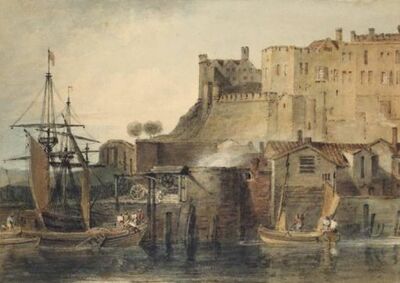
- 1806; "King George" of Chester wrecked of Hoylake with many drowned. In Chester, "July 28, Dreadful storm the mast of a ship at the Crane shivered to pieces by the lightning". The Courant reported Isaac Hitchen and Thomas Rix executed for sodomy at Chester Castle (it appears they were actually executed at Lancaster).
- 1807; five convicts escaped from Chester Castle. "One of the watchmen named Boulton found drowned in the canal locks at the Tower Wharf. Verdict of the inquest wilful murder" (Hemingway)
- 1808; prior to the building of the present Northgate in 1809, the City Gaol and House of Correction was moved to a new building erected in 1807 near the City Walls on the site of what is now the Queen's School. "Sept 27tb The picture of King George III placed in the Council room of the Exchange the likeness painted by Gainsborough the drapery by Sir Joshua Reynolds Given by Earl Grosvenor." Commercial Newsrooms open in Northgate Street.
- 1809; The Sugar House in Cuppin Lane (Cuppin Street) destroyed by fire. Execution of Proudlove and Glover at the "New Drop" - both ropes broke leaving them in a state of half-strangulation until new ropes could be obtained. Ludwig van Beethoven writes "The Monks of Bangor's March", WoO. 155 (26 Walisische Lieder) no. 2.
- 1810; Rowton and Morhall's Bank (of Chester) failed. An extra mural magazine was constructed adjacent to the upper bailey wall of Chester Castle. The Chester United Gas Company opens in Cuppin Street
- 1811; St John Street, previously described as "dark, narrow, and incommodious", was "much improved" after the building of a Wesleyan chapel. Parry and Truss coachworks burns down (again). Thomas Harrison starts work on his new Doric gateway (propylaea) at Chester Castle.
- 1812; Luddites imprisoned at Chester Castle. Executions this year include: "June 15 - Temple and Thompson for rioting They were connected with the Luddites." (Hemingway)
- 1814: William Wilson was executed at Chester Castle for setting fire to a barn in Tiverton. "June 17 The city illuminated in commemoration of the Peace In arranging the lamps at the New Bank a cornice stone fell from the top of the building and falling on a young woman beneath caused her death. On this occasion the principal tradesmen gave dinners to their workmen and a Regatta took place on the Dee which had a beautiful effect. The great bells of the Cathedral were RUNG for the first time the last sixty years"

- 1815: August, 1815, when news had just been received of Napoleon’s impending exile to St. Helena, some wag conceived the idea of distributing handbills in Chester, stating that the island chosen for the ex-emperor’s retreat was dreadfully infested with rats, and that the government had decided to clean them out. The advertisement offered liberal prices for cats and kittens to be used for this purpose. These were to be delivered at a specified address, which turned out to be a vacant house, and to which more than three thousand felines were brought on the appointed day. (see Modern Mechanics, 1931)
- 1816; Ann Moore the "fasting woman of Tutbury" imprisoned at Chester Castle (according to Roberts). "The body of Samuel Williams collector of the Northgate tolls found in the canal under the old house of correction. It was supposed he had been murdered" (Hemingway) 1816 was known as the 'Year Without a Summer' because of low temperatures in the Northern Hemisphere, the result of the Mount Tambora volcanic eruption in Indonesia.
- 1817; the "Chester Savings Bank" was established. The pillar, or shaft, with a square base of the original Chester High Cross was presented to the famous "Ladies of Llangollen" by the Duke of Westminster (it still remains in the grounds of "Plas Newydd" at Llangollen). First grandstand built at the Roodee. A fire broke out in the west wing of the Gaol at Chester Castle, causing considerable damage. First gas mains supply houses in Chester. "On the 4th of Jan the grand duke Nicholas of Russia (the present emperor) who had been making a tour of the northern part of England, visited Chester. He was attended by General Kutosow, whose father had driven Buonaparte out of Russia, General Sowrason, and several other Russian noblemen. On the following day his highness attended by his suite, inspected our walls and several of the public buildings and in the evening set off for Wynnstay, the seat of Sir W W Wynn. When the illustrious stranger inspected his sleeping apartment at the Royal Hotel, he ordered a quantity of clean straw to be placed on the floor in a convenient part of the room for his bed." The Lancaster Gazette for Saturday 14th June 1817 records: "A dreadful fire broke out in the ship-yard of Mr. Cortney in Chester on Tuesday night. It began in the smithy and adjacent buildings, and no exertion could prevent the flames from spreading over the whole of the east side of the yard. The saw-pit, huts, tool-room, moulding-rooms, &c. soon presented one great mass of fire. It was at mid-day, and in about two hours all this valuable property was destroyed. The loss which Mr Cortney has sustained by this calamity is great: he has carried on with high respectability one of the largest ship-building establishments in that part of England; and gave employment to a great number of hands."
- 1818: The Agricola Tower at Chester Castle is refaced in sandstone.
- 1819; Gas lights introduced in the streets of Chester. Dee Mills burned down. Much correspondence in the latter half of 1819 concerning the security of Chester Castle.
- 1820; While traveling home from an election meeting, Thomas Grosvenor's carriage was attacked near the Old Dee Bridge and cast over the parapet into the river: he escaped to the Bear and Billet. In later life "Mad King George's" health deteriorated, and eventually he became completely blind and increasingly deaf. He never knew that he was declared King of Hanover in 1814, or of the death of his wife in 1818. Over Christmas 1819, he spoke nonsense for 58 hours, and for the last few weeks of his life was unable to walk. On 29 January 1820, he died at Windsor Castle.
George IV (29 January 1820 — 26 June 1830). Son of George III, previously Earl of Chester.
George was a stubborn monarch, often interfering in politics, especially in the matter of Catholic emancipation, though not as much as his father. For most of George's regency and reign, Lord Liverpool controlled the government as Prime Minister. George is remembered largely for the extravagant lifestyle that he maintained as prince and monarch. By 1797 his weight had reached 17 stone 7 pounds (111 kg or 245 lb), and by 1824 his corset was made for a waist of 50 inches
- 1821; major fire at the Leadworks. Old Lamb Row in Lower Bridge Street collapses: "While this house was in being it was the greatest curiosity of its kind in the city but in 1821 the decaying timbers suddenly parted from their bearings and the entire pile fell in with a great crash to the unspeakable relief of the pent up thoroughfare but to the great chagrin and regret of the antiquary" (Hughes)

- 1822; a steam boiler explodes at Boults tobacco works in Cuppin Street demolishing the works and killing both Boult and employees. Much destruction caused by major storm: "At the close of this year the city of Chester, in common with many other places in the neighbourhood, was visited by one of the severest storms of wind that had ever been known in this latitude. This tremendous storm occurred during the night of Thursday the 5th of December" (Hemingway). Nude male bathing in the Dee and the canal was regarded as a nuisance which the mayor and J.P.s intended to eradicate.
- 1823; Parry's coach works burns down for the third time. By 1823, Cheshire cheese production was estimated at 10,000 tonnes per year. "April 14: Execution of Samuel Fallows for the murder of his sweetheart at Disley. Several galvanic experiments were made on his body previous to dissection" (Hemingway)
- 1824: Chester Cup first run (originally called the Tradesmen's Cup). Parry's coach works burns down for the fourth time since 1805. Windham Sadler ascends in a balloon from Chester Castle (7th June) - on 29 Sept Sadler made his thirty-first ascent at Bolton but: "the wind dashed his car against a lofty chimney, and he was hurled to the ground, sustaining injuries of which he died at eight on the following morning" Execution of Joseph Dale for the murder of William Wood on the road between Whaley Bridge and Disley in 1823. The spot is marked by a stone on which is inscribed: "WILLIAM WOOD EYAM DERBYSHIRE HERE MURDERED JULY 16TH A.D. 1823 PREPARE TO MEET THY GOD".
- 1825: Old St Bridget's, by then very decayed, was demolished. "During this year a new steam packet was built by a number of tradesmen to ply between Chester and Flint it proved a losing concern and in December in the following year it was brought to the hammer " (Hemingway). "At the spring assizes in this year a cause was tried which in its results went to establish the right of strangers to carry on business within the city without being compelled to purchase their freedom." (Hemingway)
- 1826: The military hospital on Castle Street was erected by William Cole the younger. "The body of a young man named Thomas Reeves was discovered in that part of the canal nearly opposite the Phoenix Tower and not more than a yard from the shore on the towing path side. The circumstance of a severe wound on the head the tattered appearance of some parts of his apparel and above all the finding his hat upon the walls at the distance of about eighty yards from the place opposite to which he was found naturally suggested a suspicion that after a struggle with some murderous villains he had been thrown over the parapet wall." (Hemingway). The Menai Suspension Bridge, built by engineer Thomas Telford, is opened between the island of Anglesey and the mainland of Wales.
- 1827: first stone of the Grosvenor Bridge laid. "The following coins were now deposited in a cavity cut in the foundation stone: a farthing, halfpenny and penny, silver penny, twopenny, fourpenny and sixpenny pieces, shilling, half crown and five shilling pieces, a half sovereign and a sovereign"
- 1828: As a consequebce of a rainstorm a section of the City Walls near the site of Sadler's Tower (at the bottom of Abbey Street collapses "with a terrible crash, the earth having been completely excavated and washed away by the descending torrents" - major floods. Major fire in Northgate Street
- 1829; Chester Asylum completed for the reception of patients. Lieut L.W. Halstead of the 87th Royal Irish Fusileers stepped out of a mess window at the officers barracks adjoining Chester Castle (to which he had recently returned), in the belief there was a balcony outside - unfortunately the mess had been moved during Halstead's absence to a different room which did not have a balcony, resulting in a fatal accident.
- 1830 Chester Castle precinct was enlarged to the south, demolishing the western part of Skinners Lane and the warehouses and "noxious acid works" (used for Tanning) sited there. The (Duke of Wellington's) Beer Act encourages the opening of Beer Houses (in an attempt to reduce consumption of gin). The semaphore station on Hilbre Island passes a message between Holyhead and Liverpool in 23 seconds. George IV's heavy drinking and indulgent lifestyle had taken its toll on his health by the late 1820s. His taste for huge banquets and copious amounts of alcohol caused him to become obese, making him the target of ridicule on the rare occasions that he did appear in public. Furthermore, he suffered from gout, arteriosclerosis, cataracts and possible porphyria; he would spend whole days in bed and suffered spasms of breathlessness that would leave him half-asphyxiated. He died at about half-past three in the morning of 26 June 1830 at Windsor Castle; he called out "Good God, what is this?" clasped his page's hand and said "my boy, this is death.
William IV (26 June 1830 — 20 June 1837). Third son of George III. Was never Earl of Chester.
As a result of the deaths and childlessness of his two older brothers, he inherited the throne when he was sixty-four years old. His reign saw several reforms: the poor law was updated, child labour restricted and slavery abolished throughout the British Empire. One of the most important pieces of legislation was the Reform Act 1832, which refashioned the British electoral system. Though William did not engage in politics as much as his brother or his father, he was the most recent monarch to appoint a Prime Minister contrary to the will of Parliament.
- 1830; Abolition of the Great Sessions in Wales and the palatine judicature of Chester. John Douglas (architect) born at Park Cottage, Sandiway, Cheshire, on 11 April. First official street names put up in Chester. Erection of St Paul's Church, Boughton.
- 1831; Joseph Hemingway, former editor of both local newspapers, observed in that skindressing and tanning had "greatly declined", while glovemaking had "chiefly migrated to Worcester". History of the City of ChesterVol I and Vol II by Hemingway published. Cholera breaks out. Shipgate taken down.
- 1832; end of outbreak of cholera in Chester. Small earthquake.
- 1833; Grosvenor Bridge completed - at the time, the largest stone arch in the world. Two major storms (Nov 20 and Dec 31) strike Chester causing great damage. Hanshall slain by the Cholera
- 1834; Frosts steam mill burns down.
- 1835; the "Municipal Corporation Act" abolishes the admiralty rights of seaport towns - from this time, the Mayor of Chester's title "Admiral of the Dee" is strictly honorary. Chester City Assembly becomes the Council of the Borough of Chester. Comet Halley is back again. Legal proceedings start over whether the corporation had grossly mismanaged the funds of St John's Hospital : only £85 of the annual income of £600 was applied to the purposes of the hospital. Mechanics Institute founded in St John Street. The Chester Criminals Execution Bill is passed after a dispute between the Sherrifs of the city and county as to who should execute criminals.
- 1836; tolls at the city gates are abolished, allowing goods to enter without payment. Watch Committee, with responsibility for borough policing, established by the City Council. Establishment of Poor Law Guardians in accordance with the Poor Law Amendment Act of 1834.
- 1837; William IV died from heart failure in the early hours of the morning of 20 June 1837 at Windsor Castle, where he was buried
Victorian Chester
From 1841 to 1871 Chester enjoyed thirty economic boom years following the arrival of the railways (see: Chester Station). This reasserted Chester's importance for transport and consolidated its function as a service centre for the region. A limited growth in manufacturing, particularly engineering, further diversified the economy (see:Industrial Revolution).
Victoria (20 June 1837–22 January 1901). Granddaughter of George III and the niece of her predecessor William IV.
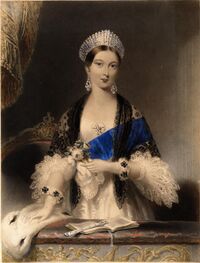
In 1837, the union of the thrones of the United Kingdom and Hanover ended. Succession to the Hanoverian throne was regulated by semi-Salic law (agnatic-cognatic), which gave priority to all male lines before female lines, so that it passed not to Queen Victoria but to her uncle, the Duke of Cumberland. In 1901, when Queen Victoria died, her son and heir Edward VII became the first British Monarch of the House of Saxe-Coburg and Gotha, Edward taking his family name from that of his father, Prince Albert of Saxe-Coburg-Gotha
"Railway Mania" was an instance of speculative communications frenzy in Britain in the 1840s. It followed a common pattern, similar to that of the "Canal Mania": as the price of railway shares increased, more and more money was poured in by speculators, until the inevitable collapse. It reached its zenith in 1846, when no fewer than 272 Acts of Parliament were passed, setting up new railway companies, and the proposed routes totaled 9,500 miles (15,300 km) of new railway. Few made a fortune, most lost their money. Much the same pattern was followed in the 1990s in the stock of telecom companies. The telecom mania resulted in the installation and deployment of a vast amount of fiber-optic telecommunications infrastructure, ironically spurred on from the realization that the same railway rights-of-way could make affordable conduits for fiber optics. Yet another boom occurred in the period 1995-2000, during the development of the Internet, when many companies were established to promote new services on the growing network. Like the others, the "dotcom" bubble soon collapsed.
- 1838; Railway opens between Chester and Birkenhead (Chester & Birkenhead Railway).
- 1839; Chester College (then "Chester Diocesan Training College") opens. Cathedral damaged by major storm, gaol wall blown down, nearly all windows at St Johns Church shattered. The effects of the storm are described in Narrative of the dreadful disasters occasioned by the hurricane which visited Liverpool and various parts of the kingdom ... January 6th and 7th, 1839. Chester (along with Cornwall) stated to be the very worst in the kingdom for wreckers: "They will rob those who have escaped the perils of the sea, and come safe on shore; they will mutilate dead bodies for the sake of rings and personal ornaments"
- 1840: Railway opens between Chester and Crewe (Chester & Crewe Railway). John Romney, print-maker, moves to Chester.

- 1841: Prince Albert becomes Earl of Chester.
- 1842: Post Office erected in St John Street. W. E. Gladstone lays foundation stone of Diocesan Teacher Training College.
- 1843: severe earthquake felt in Chester
- 1845: Chester Improvement Act effectively prohibits the building of "slum courts" (these reflected the surge in the city's population after 1800). This act also gave the Council the same powers as those granted to Local Boards under the Public Health Acts and provided for better pathing, lighting, and the establishment of new market places.
- 1846: Railway opens between Chester and Shrewsbury (Shrewsbury to Chester Line). Dee railway bridge opened in September. Randolph Caldecott born in Bridge Street;
- 1847: Work starts on Chester Station. 24 May - Dee Bridge Disaster. Dee mills burn down. Typhus epidemic. Chester theater opens in the Commercial Hall (Foregate Street) accommodating 1500 persons. The Chester Literary Improvement Society established in Nicolas Street;
- 1848; Railway opens between Chester and Holyhead (as far as Bangor and across the Britannia Bridge to Holyhead from 18 March 1850). General Railway station (the now: "Chester Station") opens in City Road incorporating the two previous termini. Cholera epidemic. Sanitary Committee formed under "Nuisance Removals and Disease Prevention Acts of 1848. Chester Cemetery Act sanctions the foundation of the Chester Cemetery Company;
- 1849; Founding of the Architectural, Archaeological and Historic Society of Chester, Cheshire and North Wales. Chester Public Swimming and Shower Baths opens on a site adjoining the Water Tower. Common Lodging House Committee established for local regulation and supervision of lodging houses;
- 1850; Maypole in Handbridge (as described by Washington Irving) removed. Overleigh Cemetery opens for business.
- 1851: Foundation of the Chester Ragged School Institution. Chester brought under the scope of the Common Lodging Houses Act of 1851. Thomas Pullin's French/English guidebook to Chester is published. Railway disaster in the Sutton Tunnel (between Runcorn East and Warrington Bank Quay) on the Chester-Manchester Railway on the Chester Cup day (see: Sutton Tunnel Accident for details);
- 1852: Queens Park Suspension Bridge opens;
- 1853; Phoenix Tower is converted into an "observatory". Chester Savings Bank (James Harrison) built in Grosvenor Street. Inauguration of the Chester Ragged and Industrial School Society;
- 1854; George Borrow, author of the travel book "Wild Wales" stayed in Chester, probably at the Pied Bull. The Dee House Ursuline Convent School was established, "in a fine mansion called the Dee House in St. John Street" (built upon the Amphitheatre);
- 1855; Serious fire at the Roodee grandstand; Royal Charter was launched - built at the Sandycroft Ironworks on the River Dee she was a new type of ship, a 2719 ton steel-hulled steam clipper, built in the same way as a clipper ship but with auxiliary steam engines which could be used in the absence of suitable winds. James Harrison rebuilds the Theatre Royal in Northgate Street as the Music Hall;
- 1856; After splitting from his wife, William Jackson, 35, took two of their four children, John, six, and Mary Jane, seven, with him. But after a few days the children vanished. The police were alerted, and their inquiries took them to a garden in the Handbridge area of the Chester, where the Jacksons lived. The bodies of the two children were found buried in a pit. Jackson, an upholsterer, denied killing the children when he appeared at Chester Assizes on December 5th, 1856, but several people said they had seen him digging in the garden. He was hanged on Saturday, December 20th, 1856, at Chester Prison. As hangman William Calcraft was about to pull the lever Jackson was asked by the chaplain if he confessed his sins, and he replied, “I do”. Publication of Thomas Hughes "Strangers Guide To Chester and its Environs";
- 1857; The Militia Buildings, designed by Penson of Chester in a '13th century style of architecture'- were erected on the corner of Nicholas Street and Grosvenor Street (known as Castle Esplanade) to provide accomodation for the families of soldiers stationed at Chester Castle. Edgar Garston donates four drinking fountains to the City.
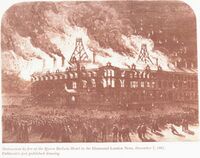
- 1859; Chester ship Royal Charter wrecked (October 26) by a hurricane of rare ferocity off Moelfre on the coast of Anglesey. She was returning from Melbourne with 388 passengers, a crew of 112, and a cargo of gold valued at £300,000. Brunel's steamship the Great Eastern survived the same storm, now known as the "Royal Charter Storm". The storm inspired Robert FitzRoy to develop charts to allow predictions to be made, which he called "forecasting the weather". David Roberts engineer and inventor of the "Caterpillar" track born in Chester. Establishment of the Chester Penny Savings Bank in St Bridget's school house in Grosvenor Street;
- 1860; Queen Hotel built, with towers, rather like small versions of Blackpool Tower for a fine view.
- 1861; Queen Hotel burns down. When built a roof joist had been put through a chimney - this caught fire and disaster followed. St Mary on the Hill church was restored by James Harrison. Semaphore station on Hilbre Island closes due to electric telegraph between Liverpool and Holyhead.
- 1862; Queen Hotel rebuilt. Chester Exchange in Northgate Street destroyed by fire. The surviving statue of Queen Anne is moved to the section of the walls leading to the Watertower. Mid-Cheshire railway line opens. 'God's Providence House' in Watergate Street restored.
- 1863; "The storm which set in on Monday night raged with terrific fury in this city during the greater part of Tuesday. Scores of slates and chimney pots were thrown down, to the great danger of passers by, but fortunately no one was injured. With such force did the wind sweep through the streets, that to keep one's equilibrium was out of the question. People were driven violently against each other, and in not a few instances they had to measure their length on the ground," several ships were lost in this storm. Rebuilding of the old Royal Hotel in Eastgate Street as the Grosvenor Hotel starts. The Market Hall, next to the present Town Hall opened on the wedding day of the Prince of Wales. "Earl of Chester's volunteer Fire Brigade" formed - see Fire Station;
- 1864; Competition for new design of Town Hall. September 3 1864 SINGULAR DEATH: An inquest was held at the Infirmary, yesterday, touching the death of George Sconce, a sawyer and boatman by trade, who had recently been engaged ferrying the boat at Higher Ferry. Deceased was in the custom of coming home every Saturday, and last Saturday he complained of a tightness across his stomach. He went to the ferry as usual on Monday, but returned on Thursday very poorly. On Friday morning, he rose at six o'clock, and his daughter had left him in the room for a short time, and on returning with a young woman, found him sitting in a chair, quite dead, with his head down as if in sleep. He clenched a bottle in his hand, containing some rum. The jury found a verdict of “Died by the visitation of God”.

- 1865; Chester Grosvenor opens for business. Statue of Stapleton Cotton erected
- 1866; last public Execution at Chester - Samuel Griffiths of Dunham. The execution was carried out before a crowd of 2000 during race week at the new City Gaol next to the Infirmary. Above the entrance of the Gaol was a colonnaded niche called ‘The Drop’ which was used for hangings. The site of the gaol is now occupied by the Queens School. Cholera epidemic - hospital sited in what is now Grosvenor Park;
- 1867; The "Operative Stonemasons" were involved in a nine-month strike on the Town Hall building site. Chester Castle was the focus of an audacious plot by Fenians (supporters of Republicanism in Ireland) that ended in farce. Charles Dickens appears at the Music Hall during a dreadful ice-storm. Grosvenor Park presented to the City;
- 1868; Sir George Gilbert Scott starts renovation of the Cathedral.
- 1869; Town Hall completed. Edward, Earl of Chester (later Edward VII) opened it and knighted the Mayor, Alderman Thomas Gibbon Frost, "as a gesture to mark the occasion". Charles Kingsley appointed Canon of Chester Cathedral. Artist Louise Rayner known to be living in Chester (see: Art of Louise Rayner). Erection of the Volunteer Drill Hall, Albion Street, headquarters of the Second Volunteer Battalion (Earl of Chester's) Cheshire Regiment;
- 1871; Founding of the Chester Society of Science Literature and Art (President: Charles Kingsley); January 14 1871, City Police Court Summary - AN EFFEMINATE BOATMAN - Thomas Edwards, described as a miner, of Tipton, was charged with committing a breach of the peace. The defendant, whose appearance created much amusement, was dressed in a gown and a shawl, and his head was covered with a hood, usually worn by the wives of boatmen, in which was inserted a small, coloured paper flag. At eleven o'clock that morning the defendant was arrested by D S Wallace whilst parading in Eastgate Street in female clothing, leaning on another man's arm. There were a lot of boatmen with him at the time, who appeared to greatly enjoy the fun that was caused by the defendant. Sir T G Frost: Was he or she drunk? D S Wallace: Quite sober, sir.
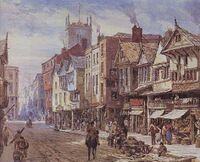
- 1872; The City Gaol was closed in and its prisoners were transferred to the county gaols at Chester Castle and Knutsford. Henry James visits Chester. Chester consituted an Urban Sanitary Authority under the Public Health Act (1872);

- 1874; Hugh Lupus Grosvenor created Duke of Westminster on 27 February, the most recent person neither born into nor related by marriage to the British Royal Family to be advanced to the highest degree of the peerage. By the time of his elevation the family's London property in Mayfair, Belgravia and Pimlico had made it the richest family in the United Kingdom. He was one of the most successful British race horse owners of all time and it is believed that the character "Colonel Ross" in Sir Arthur Conan Doyle's Sherlock Holmes story Silver Blaze is modeled on Hugh Grosvenor. One of the most popular Sherlock Holmes short stories, "Silver Blaze" focuses on the disappearance of the titular race horse (a famous winner) on the eve of an important race and on the apparent murder of its trainer. The tale is distinguished by its atmospheric Dartmoor setting and late-Victorian sporting milieu. It also features some of Conan Doyle's most effective plotting, hingeing on the "curious incident of the dog in the night-time:"
- Gregory (Scotland Yard detective): "Is there any other point to which you would wish to draw my attention?"
- Holmes: "To the curious incident of the dog in the night-time."
- Gregory: "The dog did nothing in the night-time."
- Holmes: "That was the curious incident."
- 1875; Railway station opens at Chester Northgate.
- 1876; New Post Office building in St John Street. The Mechanics' Institute, now a public Pibrary and Reading Room, opens as a Free Library. Flookersbrook improvement act relates to: "Such of the lands situate in the townships of Newton and Hoole and county of Chester, comprising in the whole two acres two roods and three perches or thereabouts, bounded as follows; ...and on the north-west in part by property belonging or reputed to belong to the said Earl of Kilmorey, on the other part by property belonging or reputed to belong to the trustees of the will of the late John Lightfoot, in other part by property belonging or reputed to belong to the trustees of the settlement made on the marriage of the late Maria Broadbent, in other part by a certain street or occupation road, ..."
- 1877: First Roman Catholic ordination since the Reformation takes place at St Werburgh's Church in Grosvenor Park Road. "At the Chester Assizes last evening, the Grand Jury ignored the bill against John and Jane Probert, charged with the murder of a boatman named Charles Moston, at Waverton near Chester on the 15th or 16th of April. Deceased was found dead on the towing path of the canal, having been seen in the company of the accused. The counsel for the prosecution did not proceed on the coroner's warrant, and the judge said that, having read the depositions over and over, he had come to the conclusion that there was no evidence to convict the prisoners. His remarks were received with applause.";
- 1878: "A fire broke out at Chester Castle on Monday evening, beneath the new court, which has recently been erected at a cost of £10,000. As soon as the flames were observed the men stationed at the Castle turned out and manned their engine. A window in the carpenter's store-room, in which the fire was raging, was broken, and volumes of water were poured in. The scene was exciting, for on one side the county prisoners were incarcerated, and on the other, in immediate proximity to Caesar's Tower, separated only from the burning building by a guard's box, immense quantities of ammunition are stored. To prevent the fire from extending to this tower, therefore, was the chief object of the men, as an explosion would have inevitably been terribly destructive to life and property. In a short time the firemen mastered the flames though the fire continued to burn for some time afterwards. The Chester fire brigade was unable to be present in time to render assistance, in consequence of a failure of the telegraphic apparatus. The storage of so large a quantity of ammunition in the city will forthwith be the subject of discussion in the Town Council" (The Times).
- 1879: horse-drawn Trams begin to run in Chester, from Chester Station to Saltney;
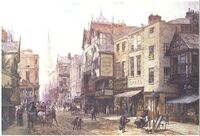
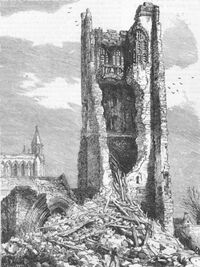
- 1880: election in Chester - the proceedings are such a spectacle of corruption that the result is later declared void under the 1883 Reform Act
- 1881: while the north-west tower of St Johns Church was being repaired it collapsed (again), destroying the north porch (the porch was rebuilt in 1881-82 by John Douglas).
- 1882: Thomas Hughes (author of Tom Brown's Schooldays) is appointed a Judge and moves to Chester. He had Uffington House built in Dee Hills Park (with the initials of his wife and he in the wrought iron gates): his daughter drowned on the Titanic. Erection of the Royalty Theatre in City Road. Anti-Salvation Army disturbances in Boughton; "A SHOCKING OFFENCE - George Sumner, 19, boatman, was found guilty of an unnatural crime on the 7th June. His Lordship sentenced the prisoner to ten years penal servitude, remarking that was the lowest penalty the law permitted him to impose for such a crime."
- 1883: Roman (sandstone) tombstone found in the northern part of the City Walls. Between 1883 and 1892, over 150 such tombstones were found, having been used to repair the walls. Chester Liberal Club founded in Watergate Street;
- 1884: Chester Improvement Act extends the powers of the Council both as a Sanitary Authority and as a Municipal Authority; provisions include the consolidation of the City of Chester into a single parish, improved rights to levy rates, the issue of corporation stock, and lifting of tolls (from the Dee bridges).
- 1885: toll fees abolished on the Grosvenor Bridge. Change from a two-member representation by MPs to a single member constituency following boundary changes. Ban on Chester MP sitting in parliament ends;
- 1886: Grosvenor Museum opens. Chester Conservative Club founded in little St John Street.
- 1887: Typhoid epidemic: - 360 cases reported between '87 and '89;
- 1888: Chester becomes a County Borough under the 1888 Local Government Act;
- 1889: the conductor Adrian Boult born to a prosperous mercantile family in Liverpool Road. Parkers Buildings completed - they were intended for the Duke's employees when they retired from working for him on his Eaton Hall estate, designed by the Chester firm of architects Douglas & Fordham and based on flats being built for the working-class in London;
- 1890: Railway opens between Chester and Connah's Quay;
- 1892: Edgar's Field is presented to the Council as a public park by the Duke of Westminster;
- 1893: Oblesque erected a Barrel-Well hill Boughton, to commemorate the burning at the stake of George Marsh, at or near its site.
- 1895: Dee Mills burn down for the final time.
- 1897: First admission fee charged at the Racecourse.
- 1898: "THE NEW INFECTIOUS HOSPITAL AT SEALAND: FOUNDATION STONE LAYING. A brief but interesting ceremony was witnessed on Tuesday afternoon at Sealand - about a mile distant from the city, and on the left hand side of the road - when, in the presence of a number of leading citizens, the Mayor (Mr. J- Gooddie Holmes) laid the foundation sr.nne of the proposed new Infectious Diseases Hospital at Sealand."
- 1899: January - During an exceptionally high tide the Floating Baths on the River Dee loses its moorings and becomes stranded on the weir. Chester bricklayers' labourers went on strike, gaining support for their demands from the Chester Chronicle. 27 May Eastgate Clock unveiled
20th Century Chester
By the beginning of the 20th Century there was very little heavy industry left in Chester and while shipping occasionally used Crane Wharf (until 1946), Chester was at a low ebb. Increasingly, Chester became a centre for residence, tourism and retail. Indeed, plans to open a steelworks in Chester were opposed as this would detract from the placid nature of the city. In the early half of the century the amphitheatre was discovered and the zoo opened. The river front was developed with restoration and improvements to the bridges and clearance of the Mills.
Conversion of the center of the city to "half-timbered" construction continued.
- 1900 : Grandstand at the Racecourse burns down. Municipal baths, by John Douglas, open in Union Street.
- 1903: Alfred Mond son of the chemist Ludwig Mond elected MP for Chester. His major business achievement was in 1926 working to create the merger of four separate companies to form Imperial Chemical Industries (ICI). He became its first chairman. He was also the model for "Mustapha Mond" in the novel "Brave New World". Electrification of tramways in Chester. "Buffalo Bill Cody's" Wild West Show, with Annie Oakley, performs at the Roodee. 1-13 Bath Street Built by John Douglas. Statue of Queen Victoria, designed by Frederick Pomeroy unveiled at Chester Castle.
- 1907: Chester Vase first run - the result was a dead-heat between Earlston and Sancy. Western Command moves into Watergate House on Watergate Street.
- 1909: First cinema in Chester opens (initially the "Corn Exchange Cinema", then the "Picturedrome") in Eastgate Street. Construction starts on St Michael's Row in Bridge Street.
- 1910: A spectacular Chester Pageant is staged with over 3000 performers. Debate erupts in the Chester Chronicle over the appearance of St Michael's Row in Bridge Street as it is not "Mock Tudor". Mills on the Old Dee Bridge demolished. LTC Rolt (canal and railway writer) born in Chester. Comet Halley passes by. Artist Louise Rayner leaves Chester. Edward (later Edward VIII) becomes Earl of Chester. He remained so until becoming king in 1936.
- 1911: The population of the city of Chester, according to the census, was 39,028. Edward becomes Earl of Chester. Fire Station designed by James Strong built in Northgate Street for the Earl of Chester's Volunteer Fire Brigade. St Michael's Row in Bridge Street refaced in "Mock Tudor".
- 1912:Damer Leslie Allen takes off from the Roodee in an attempt to fly to Ireland and is never seen again after being spotted crossing the coat at Holyhead. Mary Phillips flour-bombed Herbert Asquith outside the Town Hall when on his way to ireland to visit Lord Lever (whose house at Rivington the Suffragettes burned down). Her fine was paid by Louisa Phyllis Brown (nee Humfrey), later mayor of Chester in 1938.
- 1913: Hydroelectric Plant opened at the Old Dee Bridge. Band-stand erected on The Groves by the River Dee. Mayor Ribbeck beats the bounds for the first time since the mid-19th century.
- 1914: War starts. Frank Simpson records in his diary for 5th August: "The banks are all closed but are to re-open on Friday when one pound, and ten shilling notes will be issued to the public. This is to protect the gold supply. All kinds of food stuff has gone up in price this owing to certain people making raids on the grocers shops etc to lay in a supply."
- 1916: HMS Chester launched and damaged at the battle of Jutland
- 1919: A Mark IV tank ("I 65") visits Chester as part of a fund rasing drive. This is displayed outside the Town Hall for a week. The tank may have been offered to Chester as a memorial "Presentation Tank". It was apparently turned down and later displayed in Crewe.
- 1921: Music Hall in Northgate Street becomes a cinema.
- 1923: Present Suspension Bridge across the River Dee built. The actor Hugh Lloyd born in Chester. Louise Rayner dies.
- 1929: Roman Amphitheatre discovered. Stanley Palace given to the City by the Earl of Derby. The "Meadows" (The Earl's Eye") given to the City by the then mayor, Harry Brown.
- 1930: Trams cease to run and are replaced by a bus service. The trams were discontinued after a ballot of ratepayers following a 1928 report on the cost of overhauling the system.
- 1931: Chester Zoo opens. June 24, The American airmen, Wiley Post, and his co-pilot and navigator, Harold Gatty, brought their Lockheed-Vega monoplane - "Winnie Mae" - down to a safe landing at the Sealand airfield near Chester.
- 1935: Odeon cinema on Northgate Street opens. A greyhound track was opened in Sealand Road next to the then football stadium.
- 1937: A second Chester Pageant 1937 is staged. A Chester Constabulary driving school opened at Hoole Police Station (1, Egerton Street). Police drivers were trained in a Lagonda, which when first purchased reached speeds of 130mph.
- 1938: Newgate completed. First woman Mayor, Phyllis Brown. Western Command moves from Watergate House to a new site on the south bank of the River Dee.
- 1939: A strange Elliptical Building was partially uncovered behind Chester's market hall. This building is (was) unique in the Roman Empire. At the outbreak of WW2, two Asian cow elephants, Molly and Manniken, were part of Dourley’s Tropical Express Revue - a German-Argentinian concern - travelling around Europe. The elephants became stranded in Northampton and were offered to the Government for work in the forests. The Forestry Commission’s rules made no provision for the employment of elephants and their plight came to the attention of George Mottershead who agreed to them joining his zoo and so they were transported to Chester by train.
- 1940: Fireman Cyril Dutton became Chester's first wartime casualty when he was killed by falling timbers in Foregate Street during Nov 20th air raid.
- 1941: Astronomer Beatrice Tinsley born in Chester.
- 1945: On VJ night (August 15th) the sewer in Bridge Street collapses releasing a horde of rats.
- 1949: Bluecoat School (located at St John's Hospital) closes.
- 1950: Castle Esplanade Hoard found about 200 metres west of the Grosvenor Museum - a small pot containing hundreds of silver pennies, silver ingots and pieces of 'hacksilber' silver jewellery cut up into small pieces to be used as a form of currency.
- 1951: Gerald Grosvenor Duke of Westminster born on the 22nd December - the winter solstice (here he is on "Desert Island Disks"). The Chester Mystery Plays are first performed after a gap of nearly 400 years.
- 1955: The film "Godiva of Coventry" released (with Clint Eastwood as "a saxon"): Edward the Confessor wants Leofric Earl of Chester to marry a despised Norman woman, and has him jailed when he refuses. In jail, he meets Godiva (Maureen O'Hara), the sheriff's daughter. two deHaviland Comet aircraft hulls are shipped through the center of Chester to Broughton.
- 1957: The cafe at The Falcon closes: it later become a textile wholesaler.
- 1958: Charles becomes Earl of Chester. St John’s House demolished so that the northern half of the Amphitheatre could be excavated. Much of what is visible today is 20thC. "reconstruction"
- 1959: "Hooligan" compiler of the Chester Timeline born on the 22nd December - St Lucy's day.
- 1961: The population of the city of Chester according to the census was 59,268. The cinema at the old Music Hall in Northgate Street closes.
- 1964: Remains of the Extra-Mural Roman Baths destroyed by construction of Norroy House between Watergate House and the City Walls at the Watergate - by 2014 the building is vacant and due to be demolished. Work starts on the "hideous" County Police HQ ( demolished 2009) replacing the historic Militia Building.
- 1966: First section of the Inner Ring Road opened. Remains of the Roman Elliptical Building destroyed by construction of Market Car Park.
- 1967: Chester Indoor Market in Northgate Street is closed and demolished.
- 1968: Opening of the Gateway Theatre. The actor Daniel Craig born in Chester.
- 1969: Closure of Northgate Railway Station - (more photos of the station). Northgate Brewery is demolished. Nine of the ten bells are removed from Chester Cathedral.
- 1971: The population of the city of Chester according to the census was 62,923. New Fire Station opens in St Anne Street.
- 1972: St Olave's, St Michael's, and St Mary on the Hill all become redundant due to parish boundary changes.
- 1973: Cathedral bells recast by John Taylor & Co as a ring of twelve with a flat sixth. Chester gets its first Blue Plaque.
- 1974: New City Council established under local government reorganisation. A Petition by Chester Council led to the Queen granting the City a new charter - under the Local Government Act 1972 Chester became a District Council on 1st April, but the Queen, by Letters Patent, gave Chester the status of a City.

- 1975: Chester Heritage Centre opens in former St Michael's Church. The High Cross is restored to it's location after an absence of some 329 years. On 26th February the new bells at the Cathedral were rung for the first time. The Cathedral Bell Tower was officially "opened" 25th June. St Mary on the Hill converted into an educational centre. Nobby the elephant escapes from Chester Zoo and is shot dead after attempts to tranquilise him failed.
- 1976: Actress Emily Booth born in Chester
- 1979: Richard II's revenge: "Duke of Lancaster" beached on the River Dee Coast. Chester's 1900th Anniversary Celebrations. Kings Arms Kitchen closes (and is transferred to the Grosvenor Museum, where it becomes the "cafe").
- 1984: Library opens in the Westminster Coachworks (Northgate Street).
- 1985: County stand at the Roodee burns down (again - see: 1900)
- 1986: Comet Halley revisits and became the first to be observed in detail by spacecraft.
- 1991: On Valentines Day the "ghost of Sarah" took a dislike to the Thornton's Valentine's Day display. The heart shaped boxes of chocolates were found scattered all over the shop floor of the shop, while the ordinary boxes of chocolates that had been stacked in front of them, remained undisturbed. Hugh Grosvenor born 29th January.
- 1992: Grant of Lord Mayoralty by Elizabeth II, on 16th April. The national canoe marathon championship was held in Chester.
- 1993: Women were made Freemen in Chester's Guilds for the first time.
- 1995: Rebuilding of the Forum in Northgate Street completed.
- 1996: Ravens nest on Chester Town Hall after an absence of several centuries. Great Comet Hyakutake seen from Chester. 24 Oct - Lightfoot Street Fire
- 1997: Ravens nest on Chester Cathedral. Great Comet Hale-Bopp seen from Chester - the most widely observed comet of the 20th century and one of the brightest seen for many decades. It was visible to the naked eye for a record 18 months, twice as long as the previous record holder, the Great Comet of 1811. Diana, Contessu of Chester, dies. Christine Russell, with a majority of 915, becomes first female and the first Labour MP for Chester, defeating Gyles Brandreth. In Handbridge there was outcry when youths wearing black clothes were spotted rampaging through Overleigh Cemetery. They desecrated around 20 graves and set fire to an upside down cross in what was described as a satanic attack.
- 1998: 500th anniversary of the Midsummer Watch Parade. Historic tow path graveyard destroyed during "Old Port" redevelopment. Redevelopment of Infirmary.
The 21st Century
At the dawn of the 21st Century interest in Archaeology in Chester appeared high as can be seen from the extensive updates produced by the Annual Review Of Archaeology.
2000-2009
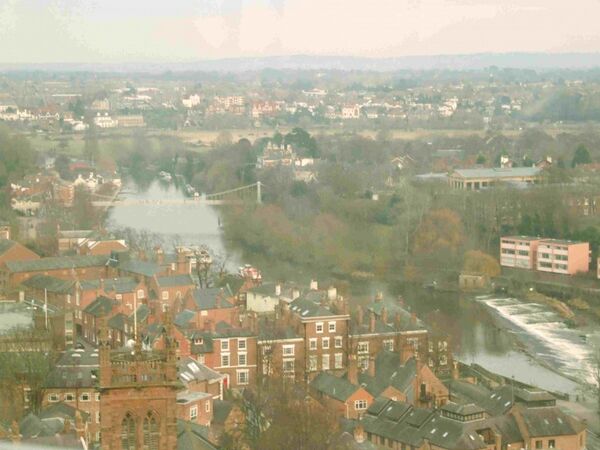
- 2000: Chester Millennium festival trail opens
- 2001: The population of Chester district according to the census was 118,210. The population of the city was 80,121.
- 2002: Chester is the first city in the UK to be granted "Fairtrade City" status. Chester is 5th in the UK retail rankings. Fire in the Rows on Bridge Street does £3M damage.
- 2006: Cheshire Police HQ, near Chester Castle, demolished.
- 2007;
- 6 Feb - Hilarious discussions in the House of Commons about Chester/Welsh relations (see Shoot the Welsh!)
- 8 Feb - Chesterwiki started! (here is an early version of the original page)
- Odeon cinema in Northgate Street closes;
- Stephen Mosley elected MP for Chester.
- 2008;
One of the last surviving provisions of the Magna Carta: "Every common man was allowed to pick up and take home deadwood from his unwitting Lordly purveyor for purposes of firewood, building materials, wife-impressing and vault-pole" gets repealed - less free wood for your log-burner.
- 3 Apr - A 30-metre section of the walkway, behind The Chester Grosvenor hotel and the Mall shopping centre, is closed after part of the City Walls collapsed at 5.30pm.
- 19 May - A fire destroys much of the former Abbey Gate School in Victoria Road. It is made a listed building (later) in the same week.
- 31 Oct - Controversial plans to redevelop the Forum Shopping Center and Market Hall are put on hold due to the "Credit Crunch"
- 2009;
- Oct - Chester Castle Inner Bailey closed to the public.
- Nov - parts of the City Walls near Northgate are briefly closed after movement of the wall following heavy rain.
- Dec - temperatures plummeted to a bone-chilling -10.7°C in the lead-up to Christmas.
- 2010;
- Jan - The "Big Freeze" Chester has "record" low temperatures for a prolonged period - however the River Dee does not freeze as in 1962/63
- Feb - A portion of The Rows is closed at Bridge Street Row when a wooden support beam was found to be weakened.
- Mar - A 30-metre section of the Walls near Morgan’s Mount Watchtower, between St Martin's Way and Northgate Street, closed for safety reasons.
- Dec 2nd - second Lightfoot Street Fire: Chester Enterprise Centre burns down.
2010-2019
- 2011;
- Stephen Mosley re-elected MP for Chester. A section of the City Walls at Northgate needs to be propped up - repair work will not start until 2016.
- 2012;
- Aug - Chester introduces a new waste-recycling scheme with five "bins" being delivered to many households. Multiple occupancy houses (bedsits) get a set of five per bedsit.
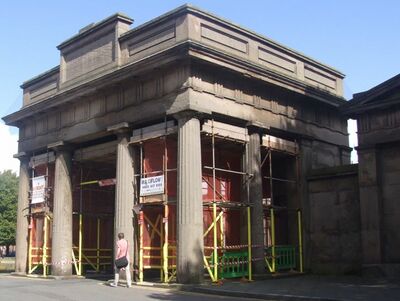
- 2013;
- Jan - the embankment and ramped path on the Curzon Park side of the river suffered an embankment slip, which caused damage to a section of the foot bridge and part of the path. This also caused concern to Network Rail, as the embankment supports a section of railway and bridge foundations.
- Nov - Virgin Trains suffered a "Train Operating Incident" at Chester (that's a train crash in English).
- Dec - The Chester footbridge over the River Dee, linking Curzon Park with the Riverside Path around the Racecourse, re-opens.
- 2014;
- Jan - Chester slides to 51st place in the UK retail rankings (from being in the top ten, a decade earlier);
- Feb - Chester and the North-West struck by high tides and winds. The River Dee overflowed into Farndon, Holt and Bangor-on-Dee.
- Apr - Cathedral at Height opens at the Cathedral allowing the public to ascend the tower (by 216 steps - and you could not get a camel through some of the doorways).
- July - Two sections of the City Walls: near Recorders Steps and Barnaby's Tower show structural problems leading to closure of footpaths. 25kg of "Love Locks" on the Suspension Bridge need removal as their presence pushed the bridge beyond its safety limits.
- Aug - The Propylaeum at Chester Castle has to be propped-up after a small amount of stonework falls off.
- Sep - Section of the City Walls including the Eastgate closed for nine months to allow scheduled repairs. The Canal Towpath near Northgate is closed after dangerous areas of sandstone were detected in the rock-face supporting the City Walls.
- 2015;
- March-20th: partial solar eclipse visible from Chester;
- May - Labour secured a local election victory by winning the City of Chester and defeating the Conservatives by a narrow margin (93 votes). Outgoing MP Stephen Mosley was replaced by Chris Matheson.
- July - a Chester Cathedral Falconry and Nature Gardens opens to the public;
- Oct - Pranksters place fake plaques on city-center benches to raise awareness of the plight of homelessness in the city. The texts included: “If you shut your eyes for more than ten seconds whilst on this bench, you may be deemed asleep, and risk facing an ASBO. By Order of Public Space Protection Orders under the Anti-Social Behaviour, Crime and Policing Act 2014.” The council promptly removed them.
- Dec - Fire at the Leadworks. On Boxing Day, the traditional Race around the Walls is called off due to "Specific Circumstances" - just what these are is not made at all clear.
- 2016;
- April - Repair starts on a section of the City Walls between Northgate and Morgans Mount which is closed for an unspecified period. During the works a "hidden" chamber is discovered within the wall.
- June - Hoole Bridge closed briefly as appliances from Chester Fire Station extinguish a major fire at a furniture store next to the bridge. Chester MP Chris Matheson, a former Unite official who won Chester with fewer than 100 votes, resigned as Parliamentary Private Secretary to the shadow justice team in the wake of a "revolt" against the effectiveness of the leader of the Labour Party.
- Aug - Unexpected death of Major General Gerald Cavendish Grosvenor, 6th Duke of Westminster.
- Sept - Council leaders defend their decision to grant a 150-year lease on Dee House and thus prevent the excavation of the still-covered half of the Amphitheatre.
- Nov - Work begins on repairs to the Watergate, which had been supported by scaffolding since late 2012.
- 2017;
- Feb - Storm "Doris" brings down many trees in Chester and causes structural damage. University building in Delamere Street loses part of roof, Eastgate Street is partly closed due to falling slates.
- Jun - The City of Chester seat was a Conservative target constituency in the general election. Labour incumbent Chris Matheson was defending a tiny majority of 93 but, on a swing of 8% from the Tories, he has increased that to 9,176.
- Jul-Sep - Chester castle open to the public again.
- Nov - Towpath in the Northgate cutting closed due to falling rocks.
- Dec - Watergate repaired, with 85% of the stone being replaced. Heritage Centre at St Michael's closes.
- 2018;
- Feb - Earthquake felt in Chester. Event epicentre approx 20km NNE of Swansea, with 4.4 magnitude at a depth of 7.4km. Events of this magnitude only happen in the UK every 2-3 years. Severe cold spell over the entire country lasts into March.
- Jul-Sep - Chester castle open to the public again.
- Sep - complete idiot John Armitage, 50, of Canberra Way, Blacon smashed a stained glass window in the cloisters area of the Cathedral before using a fire extinguisher to smash open a donation box, stealing £40.

- Dec - Chester Market voted into the Top Ten UK Markets 2019 as a finalist together with BARNSLEY, BURY, CARDIFF, LEEDS, PRESTON, SKIPTON, SHREWSBURY, ST.GEORGE’S MARKET BELFAST and WATERSIDE AT STRATFORD UPON AVON. In the same month Chester came in eighth place in this year's poll of Britain's 20 best cities, as voted for by readers of The Telegraph in their annual travel feature. 15th serious fire at Chester Zoo (caused by an electrical fault) - flames were fanned by very strong winds and raced across the roof of the Monsoon Forest enclosure. The zoo saw the highest number of visitors in its entire 88 year history in 2018 - 4% up on its previous best in 2016.
- 2019;
- Jan - 20th - Minor earthquake in Cheshire, the epicentre was just off Long Lane in Milner’s Heath between Waverton and Hargrave , a quarter of a mile east of St Peter’s Church. 21st, total lunar eclipse visible in Chester: the last total lunar eclipse visible anywhere on Earth until May 2021.
- Apr - Bridgegate shut to walkers wanting to cross it due to structural issues.
- Jun - debate continues over the "metal trees" to be installed at Gorse Stacks roundabout. The real trees at the site have been cut down and the area is now experiencing flooding. Plans to install a statue of "Orville the Duck" have not yet been taken forward.
- Jul - A study by the online ticket selling platform TicketSource determined the cities with the sparsest "culture" per square mile - Chester is in eighth position, from the bottom.
- Aug - Chester "Supertrees" erected at end of Brook Street: considerable debate sparked as to their actual benefits. Minor earthquake hits Cheshire. Fire on Hilbre Island due to use of plastic to pack caves;
2020-2029
- 2020;
- Jan - A section of the City Walls behind the Wesley Church Centre in St John Street collapses. Early indications appear to show that earth had been removed from the bottom of the city walls behind 15 to 19 Newgate Street by a developer. The local paper had reported in 2019: "Cllr Don Beckett, Labour, was less convinced that the location would be suitable. He said: “I think the application site is too near to the famous walls...." (as they say: מנא מנא תקל ופרסין)
- Mar - Chester affected by the 2019–20 coronavirus pandemic. Panic buying empties many shops of tinned goods, cleaning products and toilet rolls. For further detail see: Pandemic;
- Jun - Chester's Falconry Center states that it will not re-open following the COVID lockdown.
- 2021: Chester was in the news over the state of its walls.
- 2022:
- Mar - The first of two collisions with Grosvenor Bridge just after the speed limit on Grosvenor Road between the Castle Drive junction and near Overleigh Roundabout reverted to 30mph, having been 20mph for a couple of years.
- Jul - hottest day on record for Cheshire, with temperatures in Nantwich reaching 34.9°C before 3pm.
- Aug - Chester voted "Most Beautiful City In The World" (see: Three Old Arches).
- Sep - Elizabeth II dies (8th September) and William Arthur Philip Louis; born 21 June 1982 was named the new Earl of Chester by Charles III.
- 2023:
- Sep - 'How to Work Better, 1991' was reproduced on the side of The Forum Building, Exchange Square as part of a major new visual arts event, Chester Contemporary. Other elements of event included the design of a tattoo (copied from a Tin-Tin comic), a cocktail (white port, brandy, cardamom and orange bitters: mulled wine, without the wine and served cold) and a flag based on several flags including the Union of South American Nations; the Flag of Earth; HM Coast Guard; the Principality of Sealand; NASA; Jolly Roger Pirate; United Galactic Federation; the Flag of Animal Farm; Europe; the Progress Pride Flag; the Dune Inspired Choam Flag; Japan; Australia, and Germany. The "local artist" involved wrote: "I worked at a carpet shop in Chester for some time. It was only by going to the Jan Van Eyck Academy later that year that I was prevented from the possibility of working at that shop the rest of my life. It really saved me."


